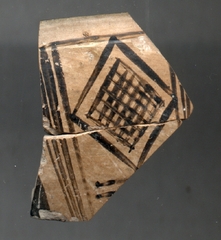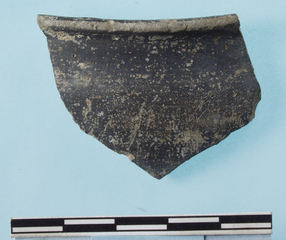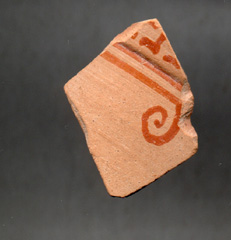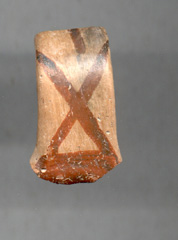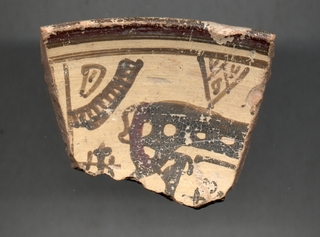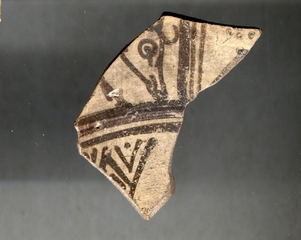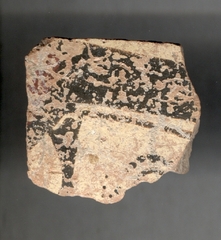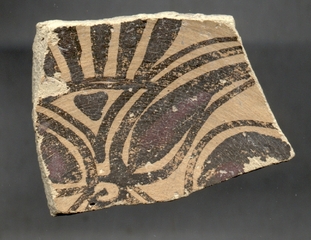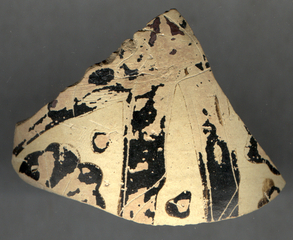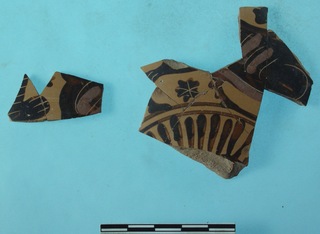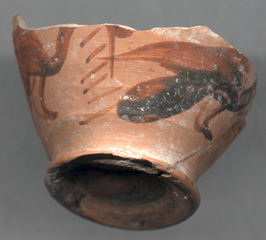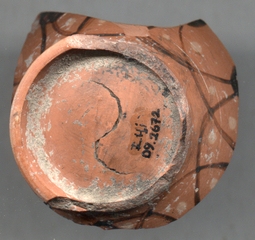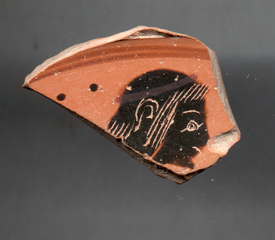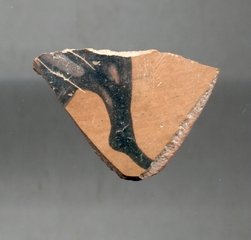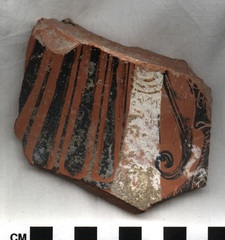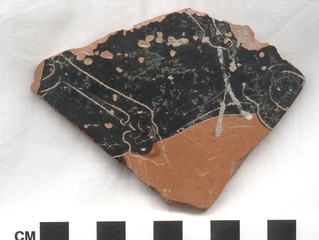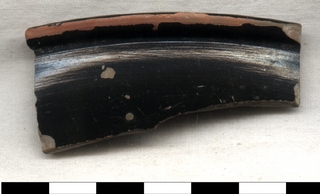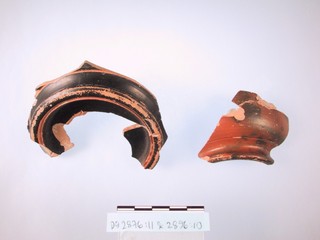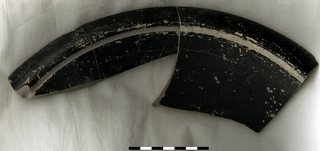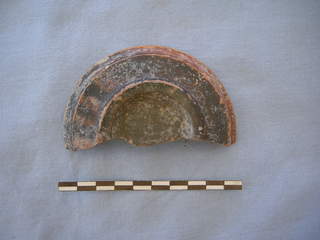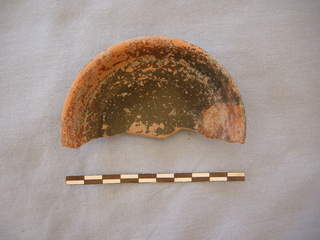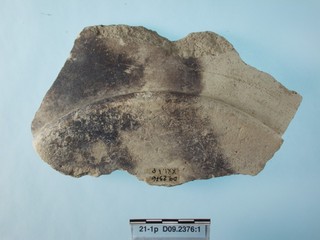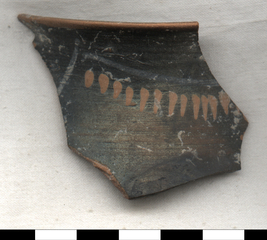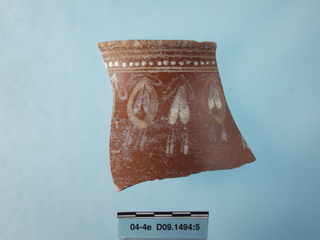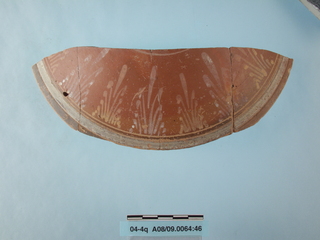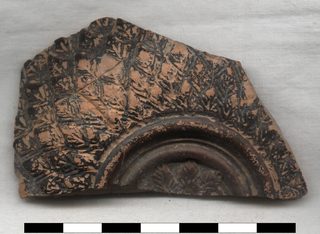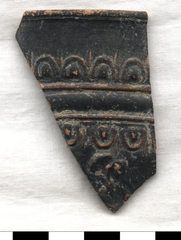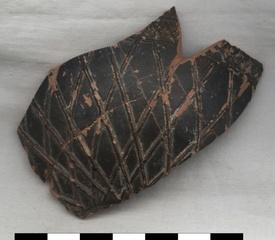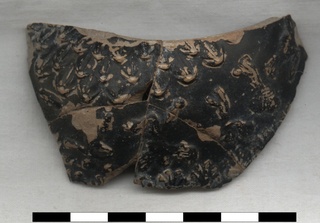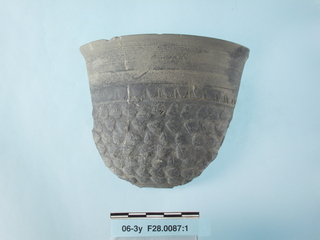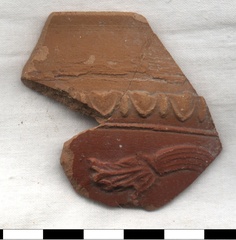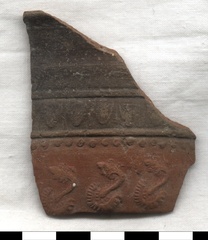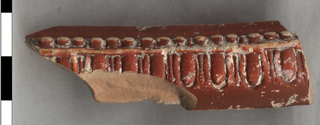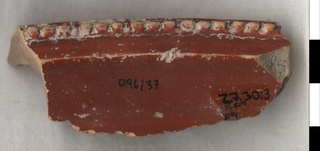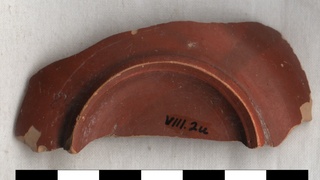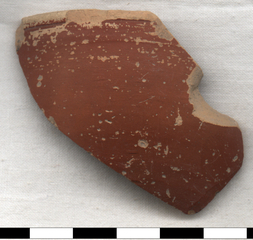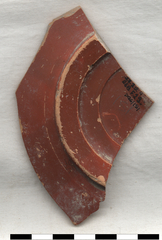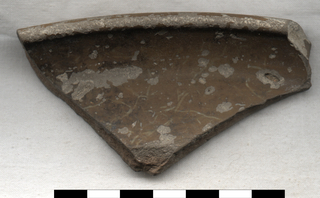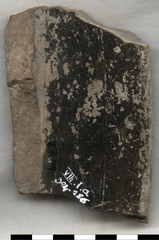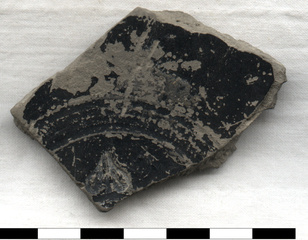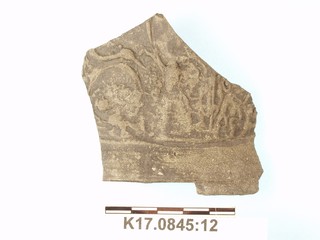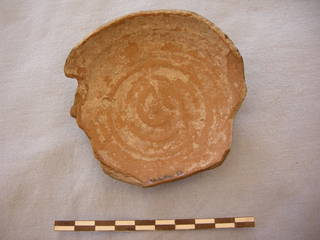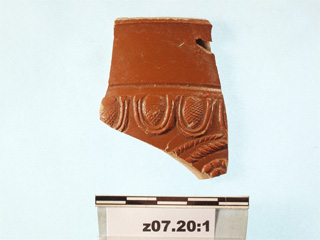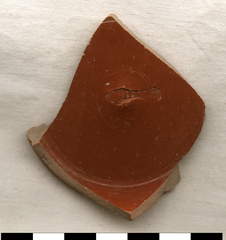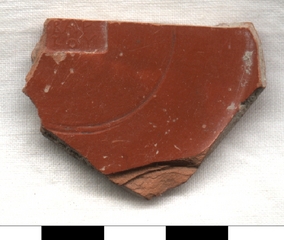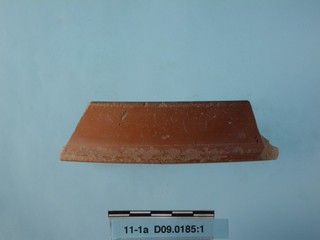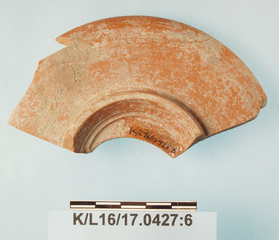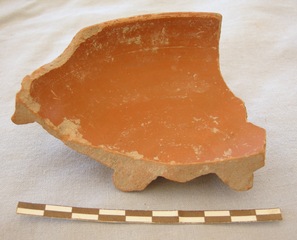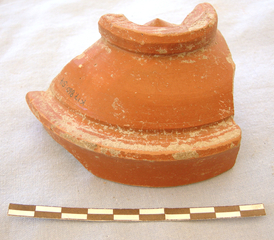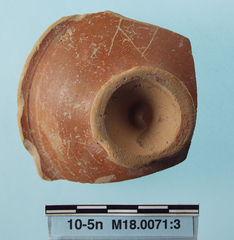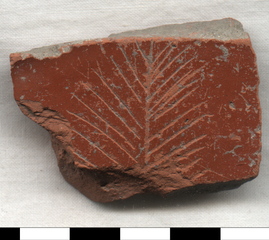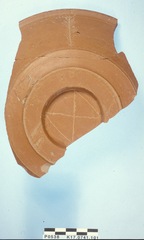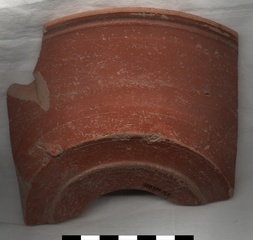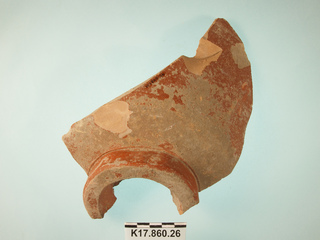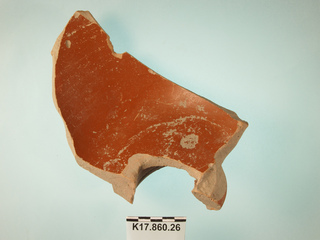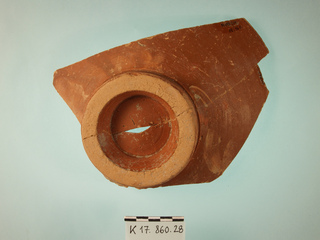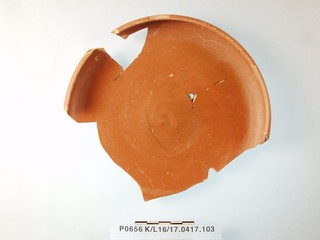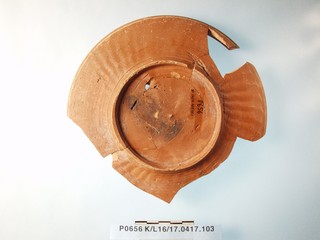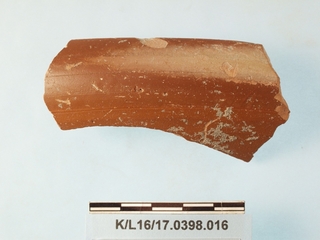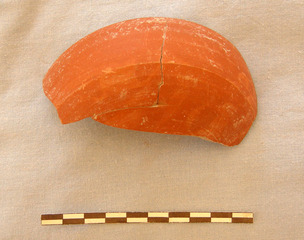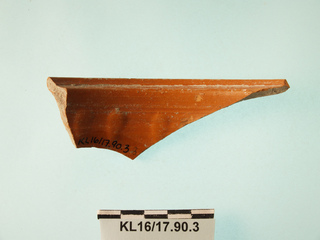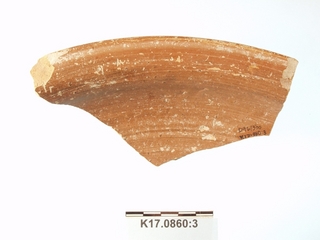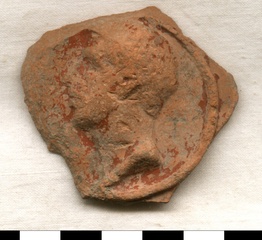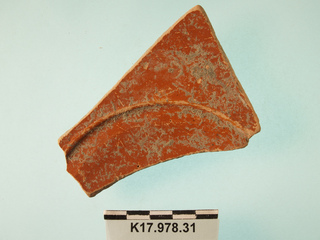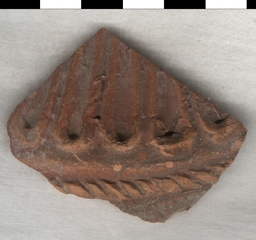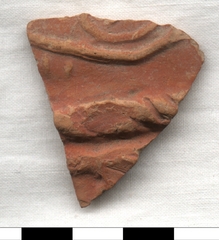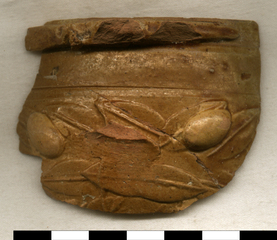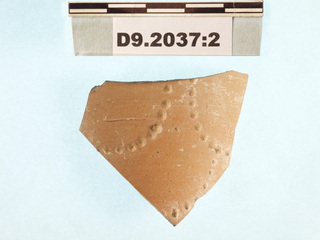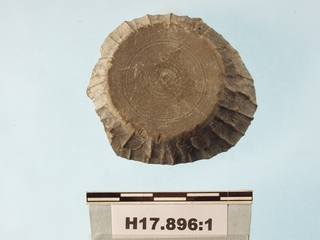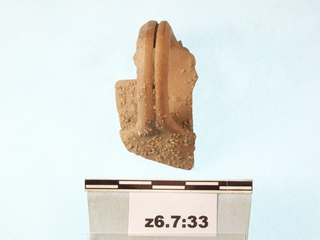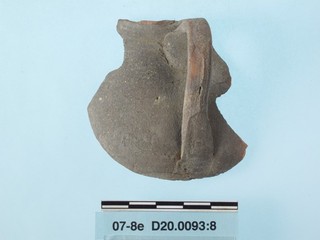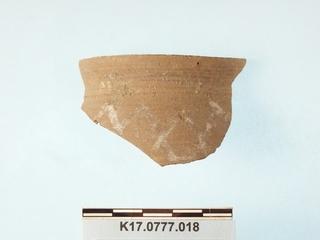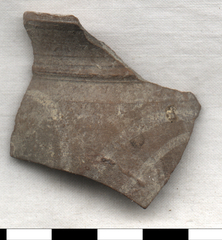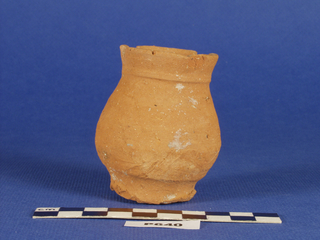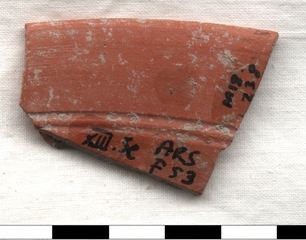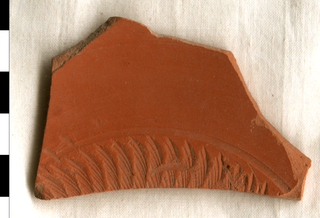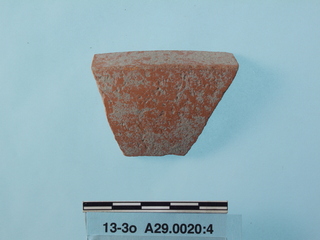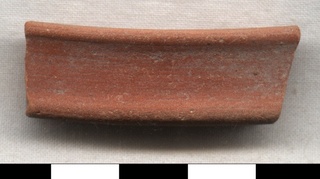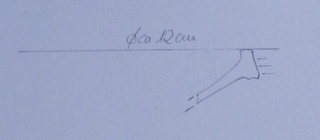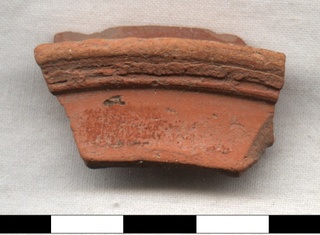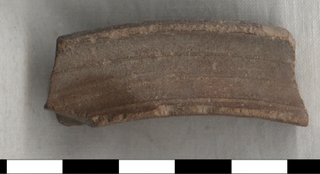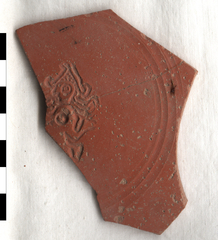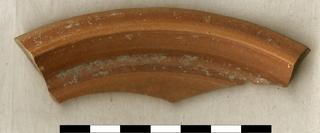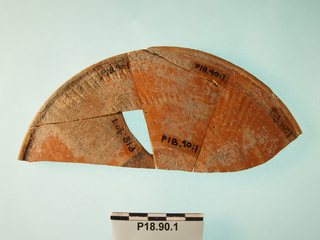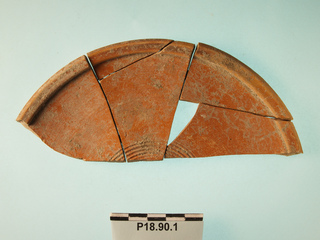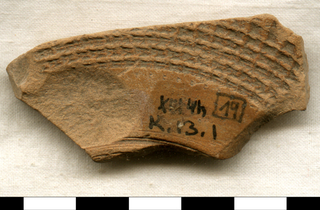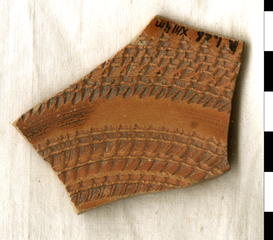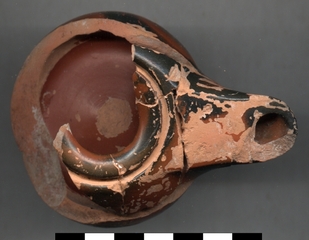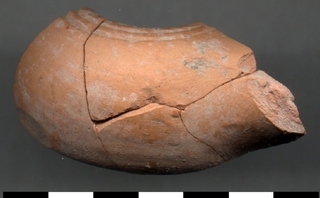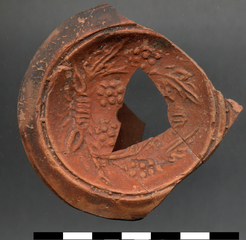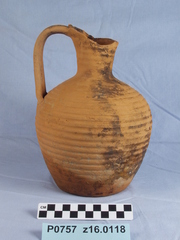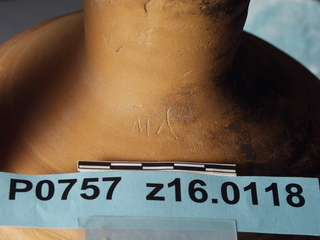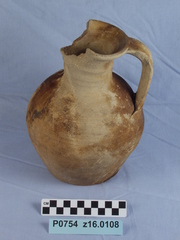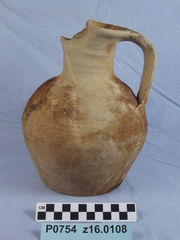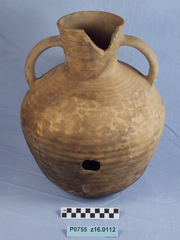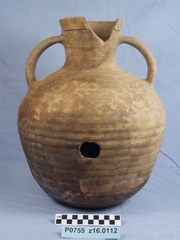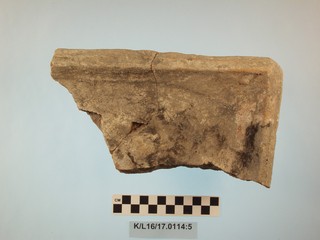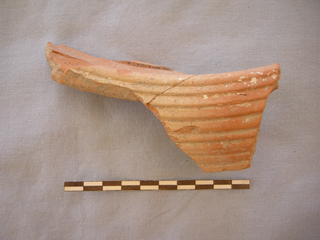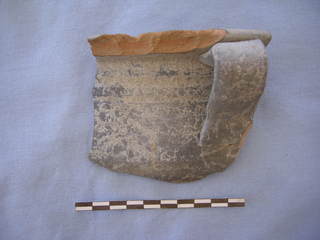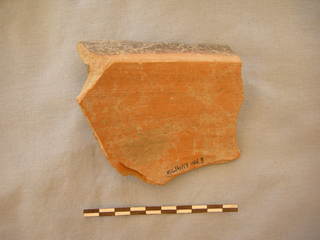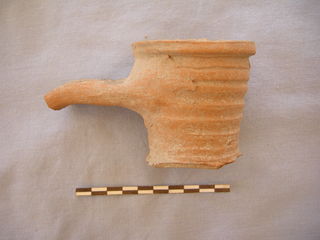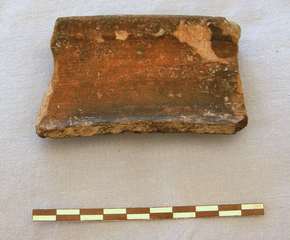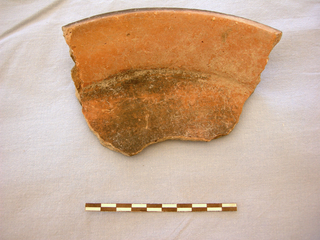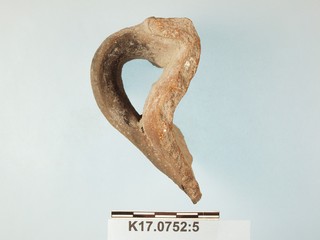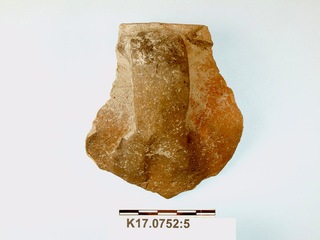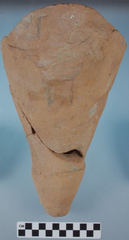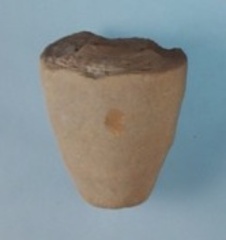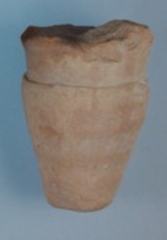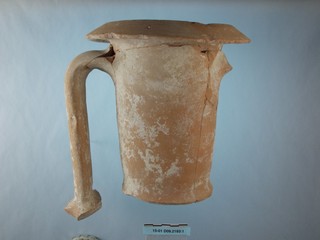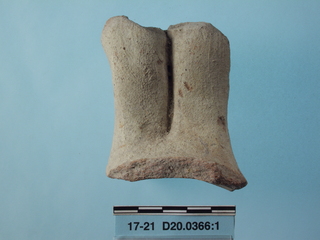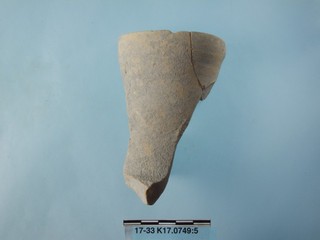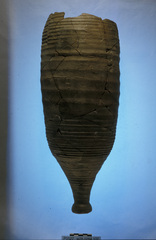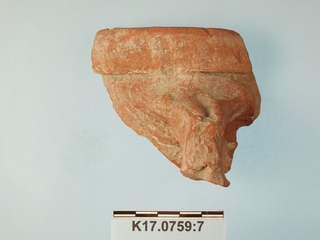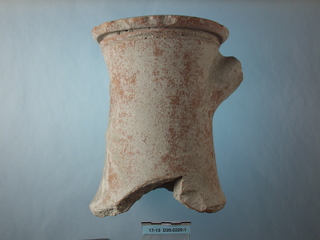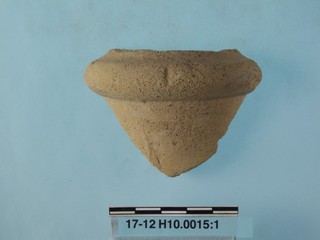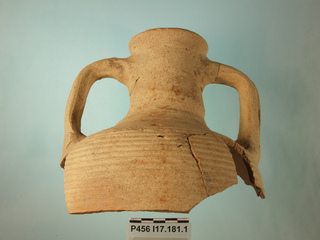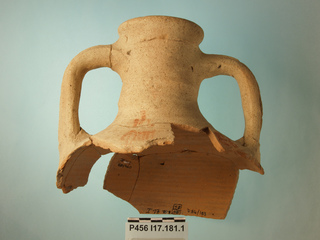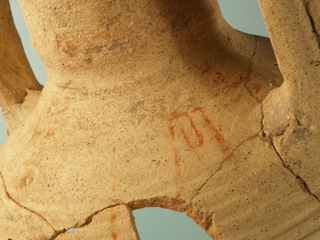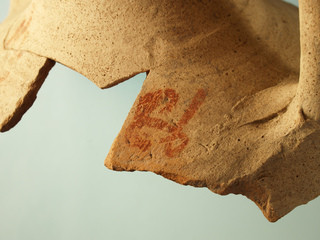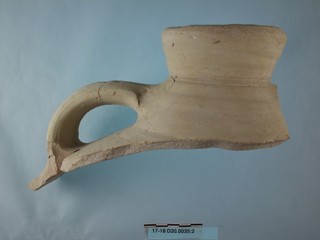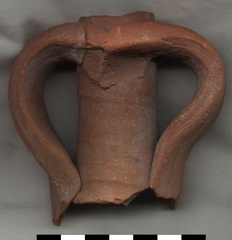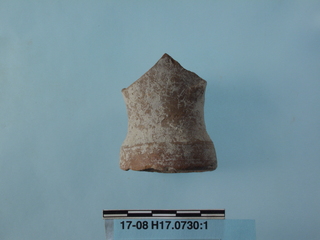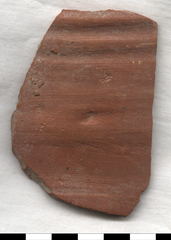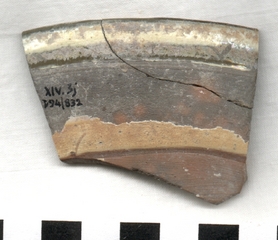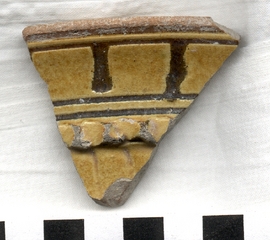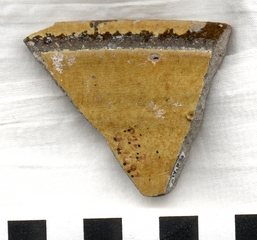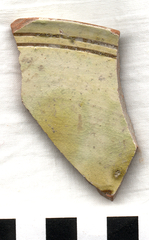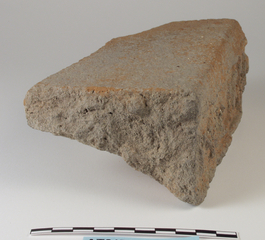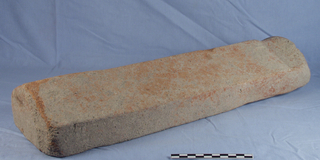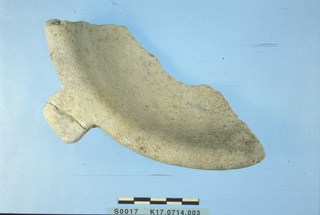Greek, Roman and Byzantine Pottery at Ilion (Troia):
Sebastian Heath and Billur Tekkök, Editors
All records
Please note that this is a public draft of work in progress
1. Kantharos
D20.0235:17. PH. 4.9; est. D.rim 10; Th. 0.5. Preserving 1/10 of rim. Stylized ivy decoration, ivy in tan, scrolls by incision. Pinkish red fabric, brownish black thick glaze.
Berlin 1999, 105, n.6, pl.13. Early Hellenistic Building (z6.388)
2. Bowl, incurved ledge rim. Local.
D20.0235:14. PH. 6; est. D.rim 15; Th. 0.6. Preserving 1/20 of rim. Traces of red slipped decoration on rim and wall. Micaceous brown fabric (2.5YR 5/4) with gold mica on surface, and body. Traces of handle.
3. Basin, ledge rim. Local.
D20.0235:21. PH. ; est. D.rim ; Th. 0.7. Preserving 1/10 of rim. Brown micaceous fabric peeling of the surface,low fired.
Berlin 1999, 107, n.19, pls.9, 14. (gray).
4. Dish, outcurving rim
D20.0262:1. PH. 3; est. D.rim . 16; Th. 0.5. Preserving 1/6 of rim with wall. Traces of rouletting interior. Gray fabric with thick black slip.Sardis (Rotroff 4th Century BC).
8. Late Protogeometric/Early Geometric Lekythos
P. H. .145. Th. .009-.012.
D09.3040:6. Several sections of joining body fragments and handle stub. Slightly worn. Upper and lower registers have triangles filled with uneven diagonal lines with occasional crossing lines. The triangles are fringed with dots; the middle section has horizontal bands. Matte black paint (Gley 2 3/5PB) on tan ground (10YR 7/4). Fabric: tan (7.5YR 7/4), white and black inclusions, some mica.
First published as no. 20 with references; see the same for stratigraphic context.
svg/D09.3040-6.jpg
9. East Greek Geometric Bowl Rim
K13.0029:1. SC01-1g. Two joining sherds. Lozenge in metope field. Join is to K13.0109.
, plate 61. East Greek workshops continued to produce bowl with geometric decoration into the 7th century. This particular motif appears on 'bird bowls', including those from north Ionian workshops (eg. :fig. 41); for discussion of the workshops producing the form see , pp. 9-10.
10. Archaic Bowl (c. early 6th century BC)
P. H. .033. Est. diam. rim 24. Th. .005.
D09.2916:5. Red (10R 4/8) bands and wavy lines on a pink/orange background (2.5YR 7/6) on both the interior and exterior. Fabric: pink with a lighter core (2.5YR 6/6), a few small black inclusions, a little mica.
First published as no. 142 with references; see the same for stratigraphic context.
svg/D09.2916-5.jpg
11. Protogeometric Gray Ware Cup
P. H. .037. Est. diam. rim .12 (1/8 preserved). Th. .002.
D09.3053:3. Single rim sherd. Gray (Gley 1 4/N) fabric and brown (5YR 4/4) layers; fine with some white inclusions and mica.
First published as no. 8 with references; see the same for stratigraphic context. The context is dated to ca. BC 1025-950.
12. Late Protogeometric Gray Ware Cup
P. H. .033. Est. diam. rim .12 (1/8 preserved). Th. .003.
D09.3053:3. Single rim sherd. Green/gray (2.5Y 6/2) fabric, fairly fine with white inclusions, mica. Dark gray (Gley 1 3/N) paint on interior and exterior surfaces.
First published as no. 30; see the same for stratigraphic context. The context is dated to ca. BC 950-800.
13. G2/3 Ware Cup or Bowl (700-675 BC)
Est. diam. rim .164.
D09.1802:1. SC01-2a. Single rim sherd. Cup or bowl with everted rim. Reddish yellow (5YR 6/6) fabric. Reddish yellow (7.5YR 7/6) slip. Painted motifs are dark brown (7.5YR 3/3). Monochrome glazed interior. Rim edge glazed. Thin right-facing step pattern below rim, bounded above and below with thin horizontal bands.
First published as no. 9, with further references.
14. G2/3 Ware Open Vessel (700-675 BC)
E09.0075:2. SC01-2f. Single sherd. Large carinated open form. Light red fabric (2.5YR 6/6). Slip is light reddish brown (5YR 6/4), painted bands are red (2.5YR 5/8). Monochrome glaze interior. Right facing step pattern above body carination. Immediately below carination are two parallel horizontal bands, the lower of which has a spiral hook preserved onthe right side.
First published as no. 13, with further references.
15. G2/3 Ware Jug (700-675 BC)
z07.0106:10. SC01-2c. Single sherd. Jug handle. Light red (2.5YR 6/8) fabric. Reddish yellow (7.5YR 6/6) slip. Painted motifs are red (2.5YR 4/6). Thick band of glaze at handle top where it joins the rim. An "X" below this and then a single vertical stroke running down the handle concavity.
First published as no. 15, with further references.
16. Wild Goat Style Plate or Stemmed Dish (c. 650-550 BC)
P. H. .25. Est. diam. rim 25. Th. .007.
D09.2902:1. Four joining pieces. Worn paint. Upper register has a ray design and part of a medallion. Middle register has squares alternating with dots. Center has floral decoration. Brown (2.5YR N/4) and red paint (10R 4/6) on interior. Exterior has orange bands (2.5YR 6/8). Fabric: orange/brown (5YR 6/6), some white and gray inclusions, mica. Type 1b.
First published as no. 131 with references; see the same for stratigraphic context.
D09.2902-1.jpg
17. East Greek Wild-Goat Style Plate (7th to 6th Century BC)
D09.1904:1. SC01-3a. Rim of plate. Back of deer or goat with various ornaments. Brown and maroon on tan ground.
18. East Greek Wild-Goat Style Dish (7th to 6th Century BC)
z07.0106:11. SC01-3b. Dish body fragment. Head of a grazing goat, segmented triangles.
19. East Greek Wild-Goat Style Jug (7th to 6th Century BC)
z06/07.0211:2. SC01-3c. Body fragment of jug. Goat or deer and possible rosette. Dark brown on tan ground.
20. East Greek Wild-Goat Style Body Fragment (7th to 6th Century BC)
D09.0104:1. SC01-3d. Single body fragment. Interlocking triangles. Dark brown on tan ground.
21. East Greek Wild-Goat Style Dish Body Fragment (7th to 6th Century BC)
z07.0106:12. SC01-3e. Single body sherd of dish. Stylized floral ornament. Dark brown and maroon on tan ground.
22. East Greek Eye Cup Rim (6th Century BC)
D09.2408:2. SC01-6d. Single sherd. Beige fabric with tiny voids and occasional white inclusions. Eye partially extent, rays at left.
23. Corinthian Jug Fragment (Late Seventh to Early Sixth Century BC)
Th. .006. L. .051. W. .07.
D09.0163:4. SC01-5c. Single sherd. Pale fabric. Black paint on plain ground, incised lines. Animal facing left with head down. Rossette and dots.
24. Unclassified Black-Figure Skyphos (early 6th century BC)
Th. .002.
D09.2908:18. Eight body sherds in two joining groups. Pink/orange (2.5YR 6/6) fabric with no visiable inclusions. Decoration shows the feet and part of the body of one figure, probably a siren and the paw of another figure, most likely a panther. Radial petal decoration in the bottom register. Black paint (7.5YR 3/2) with added purple (10R 4/4) on an orange ground (7.5YR 6/6). Interior has streak brown/black paint.
First published as no. 166; see this for parallels and stratigraphic context.
25. Black-Figure Kotyle Profile, Swan Group (6th century BC)
H. .056. Est. diam. rim .08 (1/5 preserved). Est. diam. base .04 (1/4 preserved). Th. .006.
A08/09.0019:1. SC01-4l. Two joining sherds preserve profile and start of handle. Very fine, reddish fabric with no visible inclusions. Flaring ring foot, horizontal handle just under rim. Black paint on plain ground. At left, head and body of swan partially extant; at right, rear and legs of swan. Vertical drops below rim. Interior thinly slipped in black.
Cf. , fig. 298, nos. 1-5 and 7-18.
26. Black-Figure Cup Base, Swan Group (6th century BC)
P. H. .035. Est. diam. base .042 (1/4 preserved). Th. .0036.
A08/09.0011:1. Single sherd with partial base and lower wall. Fine, reddish fabric with no visible inclusions. Low, flaring ring foot. Black paint on plain ground. Forepart of swan facing right visible at left, rear of another at right; birds are separated by three dots, two of which are streaked.
Cf. , fig. 298.
27. Black-Figure Cup Base, Swan Group (6th century BC)
P. H. .036. Est. diam. base .036 (entire preserved). Th. .002.
D09.2672:1. SC01-4k. Single sherd with complete base and lower wall. Fine, reddish fabric with no visible inclusions. Low, flaring ring foot. Black paint over plain ground on exterior. Lower part of three swans facing right extant. Birds are separated by vertical stacks of short, diagonal lines. Extant interior wall thinly slipped in black.
Cf. , fig. 298.
28. Black-Figure Cup Base, Swan Group (6th century BC)
P. H. .03. Est. diam. base .042 (1/4 preserved). Th. .0032.
D09.2672:2. SC01-4i. Single sherd with partial base and lower wall. Fine, reddish fabric with no visible inclusions. Low, flaring ring foot. Black paint over plain ground on exterior. Overlapping hanging arcs in vegetal motif. Extant interior wall slipped in black, interior floor is reserved.
Cf. , fig. 298.
29. Attic Black-Figure Plate Fragment (525-500 BC)
Th. .0064. L. .039. W. .054.
z06/07.0221:1. SC01-6m. Single sherd. Interior: Head of youth right with incised detail, fillet in added purple. Two dots at left. Two concentric circles at base of wall. Exterior: Extant surface black slip with reserved band.
30. Black-Figure Lid Fragment (6th century BC)
Th. .0048. L. .038. W. .041.
z07.0005:2. SC01-6b. Single sherd. Partially extant, draped figure running to right. Interior slipped black with single band of thinner slip extant.
31. Attic Red-Figure Krater (4th century)
P. H. .039. Th. .006. L. .063.
. P0681. Single small body sherd. Scene: nude bearded male, reclining, facing left, cloak fallen to waist, holding tortoise shell lyre in left hand. Right arm raised. Female figure to right of male, holding double flute. Technique: preliminary sketch, followed by contour line. Relief line of drapery and anatomical detail. Dilute glaze used for beard and tortoise shell. Added white for flutes and female's flesh.
First published as no. 2; see the same for stratigraphic context.
32. Attic Red-Figure Krater (4th century)
P. H. .048. Th. .005. L. .027.
. P0682. Single small body sherd. Scene: nude seated male facing 3/4 front, right arm extended, hand bent at wrist to support object. Technique: contour line. Relief line for staff and anatomical details.
First published as no. 3; see the same for stratigraphic context.
33. Attic Panathenaic Amphora (4th century BC)
Th. .021. L. .089. W. .091.
z08.0071:2. SC03-1b. Single fragment from shoulder, accretions on interior and exterior. Good Attic clay, one large black inclusion. Band of long tongues at top of shoulder. Raised arm of Athena and back of her helmet. Arm added white with four dilute glaze bracelets. Helmet with incision for detail. One added white snake or tie from aegis curls up from shoulder. Added white applied directly to clay surface. Red wash on surface, streak on interior.
, p. 176, no. 4.087 (336/5 B.C.). Cf. , pp. 256, 301 no. VIII.250, pl. 316: 6, which may be the same object.
34. Attic Panathenaic Amphora (4th century BC)
L. .065. W. .0995.
z08.0422:2. Single fragment, surface chipped. Attic clay. Belly of horse with foot of rider. Front foot of second horse at left. Incision for details. Added white band around horse’s mid-section. Incision does not respect black glaze. Wash on exterior surface.
Band indicates harnessing for a chariot, cf. , no. 4.080, pl. 118 (340/339 B.C.).
35. Attic Panathenaic Amphora Body Sherd (4th century BC)
z08.0461:3. Single sherd, from lower panel. Base line and black-glaze below. Wash on surface giving it a very smooth finish. Perhaps same vessel as z08.0422:2.
36. Attic Black-Glaze Small Bowl Profile (BC 475-425)
D09.0745:2. SC03-2m. Full profile preserved. Black glaze on all surfaces.
cf. Pl. 34 no. 941, Pl. 33 no. 845.
37. Attic Black-Glaze Bowl Rim (BC 410-380)
z07.0007:14. SC03-2r. Single rim sherd. Black glaze on all surfaces.
cf. Pl. 32, no. 803, 794.
38. Attic Black-Glaze Hydria Fragment (BC 375-350)
D09.1841:1. SC04-1a. Two joining body sherds. Black glaze on all surfaces. Horizontal garland in raised lines on exterior.
239, pl. 3.
39. Attic Black-Glaze Bolsal (350-300 BC)
P. H. .018. Est. diam. base .084 (4/5 preserved). Th. .004.
D09.2876:11. Three joining sherds, partially preserve foot and outer edge of floor. Attic clay, thick slightly lustrous black slip on interior and exterior. Scraped groove with miltos on interior face of foot. Groove on base of exterior wall. Two concentric rouletted circles on interior floor. At left in photograph.
First published as no. 51; see the same for stratigraphic context. no. 169, fig 13, pl 142.
40. Regional Black-Glaze Bolsal (late 4th century BC)
P. H. .018. Est. diam. base .065 (1/4 preserved). Th. .003.
D09.2896:10. Two joining sherds, foot and lower wall. Clean, bright, light pinkish brown fabric (10R 6/8). Mottled red-black slip on interior and exterior, underside reserved. At right in photograph.
First published as no. 50; see the same for stratigraphic context.
41. Regional Black-Glaze Fishplate (BC 300-275)
P. H. .018. Est. diam. rim .38 (1/5 preserved). Th. .008.
D09.1469:5. SC03-3a. Two joining sherds. Gray fabric, dark gray slip. Drooping rim. Incised band at turning of rim.
Cf. , A41.
42. Regional Fish Plate (before 225 BC)
Est. diam. rim .18.
L04.0346:1. Single rim sherd. Deep groove under the rim where it joins to the body. Fabric pinkish buff, dense, hard fired. Glaze greenish black mottled interior, flakes off in patches.
First published as no. 16; see the same for stratigraphic context.
L04.0346-1.jpg
43. Regional Fish Plate (ca. 225 BC)
Est. diam. rim .20.
L04.0316:5. Single body fragment, no joins. Body sags. Red slipped, slipped mottled into green on interior side. Frabic pinkish buff, slip pinkish red (between 10R 5/6 and 5/8). Slip flakes off in patches. Hard-fired, compact clay.
First published as no. 17, with citations; see the same for stratigraphic context.
L04.0316-5.jpg
44. Regional Fish Plate, Banded (ca. 225 BC)
Est. diam. rim .20.
K-L04.0085:13. Single fragment, rim partially broken. Black glaze banded. Fabric orange buff (5YR 7/6), underside not slipped.
First published as no. 18, with citations; see the same for stratigraphic context.
K-L04.0085-13.jpg
45. Regional Fish Plate Base (ca. 225 BC)
Est. diam. base .10.
y05.0019:11. Single base sherd, foot partially broken. Deep groove around depression. Black-glazed. Fabric over-fired to cream with hues of light pink.
First published as no. 1, with citations; see the same for stratigraphic context.
y05.0019-11.jpg
46. Regional Fish Plate Base, Banded (ca. 225 BC)
Est. diam. base .078.
K-L04.0085:8. Single base sherd. Deep groove around depression under the base where it is attached to the foot. Red slip. Fabric pinkish buff, dense, hard-fired. Slip partially flaked off.
First published as no. 19, with citations; see the same for stratigraphic context.
K-L04.0085-8.jpg
47. Regional Black Glaze Outcurved Rim Bowl (Late Hellenistic)
P. H. .022. Est. diam. rim .095 (completely preserved). Th. .0023.
K/L16/17.0461:7. Two joining sherds , complete except for modern chip. Compact fabric is light red (10R 6/8). The thin, brushed slip on all surfaces varies from dark red to black. It is these two sherds that indicate that the robbing of the Late Flavian House and the fill of the Early Second Century House were in close sequence.
48. Pale Porous Basin
D09.2376:1. SC21-1p. Single base sherd, discolored by ash on underside.
Cf. no. 157.
49. West Slope Style Cup (Hellenistic)
P. H. .081. Est. diam. rim .12 (1/3 preserved). Th. .0027.
D09.0147:1. SC04-4i. West slope style kantharos. Spool handle. Black slip. Incised lines below rim and below handle, schematic floral(?) pattern in between.
50. Westslope Style Kantharos Rim (Hellenistic)
P. H. .041. Est. diam. rim .8 (1/6 preserved). Th. .0025.
I17.0083:1. SC04-2a. Single sherd. Black slip. Garland with white ribbon and pink leaves partially extant.
Samothrace Karadima 1994, 198, fig. 3.
51. Pergamene Westslope Style Kantharos Rim (Hellenistic)
P. H. .084. Est. diam. rim .13 (1/12 preserved). Th. .006.
D09.0097:5. SC04-2c. Single sherd. Incised line lines below rim, white garland in between. Ribbon in white and pink below. Incised line below.
Schäfer PF2, 49, D55, pl. 14.
52. Pergamene Westslope Style Kantharos Rim (Hellenistic)
P. H. .086. Est. diam. rim .135 (1/6 preserved). Th. .0041.
D09.1494:5. SC04-4e. Single sherd. Red slip. Pair of incisions above and below white dots under rim. Hanging fillets with white and natural clay.
Schäfer PF2, D63,49, pl. 16 (form only).
53. Westslope Style Lagynos Body (Late 2nd Century BC)
Est. diam. .22.Th. .006.
A08/09.0064:46. SC04-4q. Four joining sherds. Red slip. Band of palm fronds in white. White band over and between incised lines near outer edge. Fired darker towards edge. Large void on surface to extant left.
Schäfer, PF2, D18, 47, pl. 12 (for the decoration), 150-100 B. C.
54. Moldmade Bowl Base (Hellenistic)
D09.1685:1. SC06-1a. Two joining sherds with base and lower wall. Black slip is partly worn off. Floral pattern.
pp. 17-18 dates "Floral bowls" to the late 3rd through mid-2nd centuries B.C. Similar piece cataloged at no. 279.
55. Moldmade Bowl Base (Hellenistic)
D09.2334:1. SC06-2f. Single sherd. Red slip. Rosette base, below floral band. Partially extant floral motif above.
56. Moldmade Bowl Rim (Hellenistic)
A08-09.0050:36. SC06-1g. Bands of egg and dart pattern.
Cf. Taf. 88, D63.
57. Moldmade Bowl Body Fragments (Hellenistic)
A08-09.0005:1. SC06-1c. Five joining sherds. Net pattern below band of hatching.
58. Moldmade Bowl Body Fragments (Hellenistic)
D09.1685:2. SC06-1b. Four joining sherds. Frieze of rural labor between floral motifs.
59. Moldmade Bowl Rim (Hellenistic)
D09.0926:1. SC06-2g. Single sherd. Red slip. Grapevine scroll beneath meander.
Cf. Taf. 86, D52.
60. Moldmade Bowl Rim (Hellenistic)
F28.0087:1. SC06-3y. Two joining sherds, almost full profile. Band of egg and darts. Pattern of nodules. Black glaze.
61. Moldmade Bowl Rim (Hellenistic)
D09.1685:3. SC06-3e. Two joining sherds. Garland(?) in field, egg-and-dart below rim.
62. Moldmade Bowl Rim (Hellenistic)
D09.1494:6. SC06-4f. Single sherd. Vertical ribbing below band of short diagonal strokes.
63. Moldmade Bowl Rim (Hellenistic)
D09.1517:1. SC06-4j. Single sherd. Repeated floral motif in field, below egg-and-dart.
64. Eastern Sigillata A Hayes Form 4 Profile (Late 2nd Century BC to Augustan)
P. H. .041. Est. diam. rim .24 (1/3 preserved).
K17.0937:26. Very fine fabric is somewhat pink for ware (7.5YR 8/4).Slip is dark red (10R 4/6).
p. 16, pl 1.
K17.0937-26.jpg
65. Eastern Sigillata A Hayes Form 4 Base (Late 2nd Century BC to Augustan)
P. H. .018. Est. diam. base .24 (1/3 preserved).
K/L16/17.0427:17. Compact pale fabric (7.5 8/4) and deep-red slip (10R 4/6). Two concentric circles of light rouletting on floor.
p. 16, pl 1.
svg/K-L16-17.0427-17.jpg
66. Eastern Sigillata A Base, near form 8 (Late 1st Century BC)
P. H. .016. Est. diam. base .11 (1/6 preserved). Th. .0045.
K/L16/17.0467:17. Single base sherd, hollow foot. Pale pink fabric (7.5YR 8/3), dark red slip (10R 4/4) of variable thickness. Light circular incision on floor.
p. 18 and tavola II.6.
svg/K-L16-17.0467-17.jpg
67. Eastern Sigillata A Hayes Form 9 Rim (BC 50 to 25 AD)
z07.0030:3. SC08-2n. Single rim sherd. Diameter is not recoverable but is large.
tavola II, no. 7.
z07.0030-3.jpg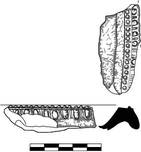
68. Eastern Sigillata A Hayes form 12 Base (40 BC to AD 10)
P. H. .015. Est. diam. base .011 (1/5 preserved). Th. .004.
K/L16/17.0120:7. Single sherd. Compact pale (10YR 8/3) fabric. Dark red (10R 4/6) slip partially preserved on all extant surfaces. Two bands of rouletting on floor. Spacer mark on base.
tavola II, no. 10.
svg/K-L16-17.0120-7.jpg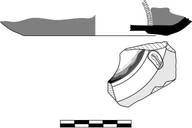
69. Eastern Sigillata A Bowl Base near Hayes Form 13a (late 1st century BC - early 1st century AD)
D09.0061:1. SC08-2u. Single sherd preserving half of foot. "Double dipping" streak visible across base.
p. 20, pl. 2.11.
D09.0061-1.jpg
70. Eastern Sigillata A Hayes Form 22a Rim (BC 150 to 50)
P. H. .0381. Est. diam. rim .10 (1/20 preserved). Th. .0054.
H17.0960:16. Single rim sherds. Pale fabric (7.5R 8/4) and deep-red slip (10R 4/6). Rounded rim offset slight from wall on exterior.
H17.0960-16.jpg
71. Eastern Sigillata A Hayes Form 22a Rim (BC 150 to 50)
P. H. .0381. Est. diam. rim .10 (1/7 preserved). Th. .0061.
H17.0798:11. Two joining rim sherds. Pale fabric (10YR 8/4) and deep-red slip (10R 4/6). Slip worn away below outer rim. Small offset under exterior of slightly everted rim.
H17.0798-11.jpg
72. Eastern Sigillata A Hayes Form 22b Rim (late 2nd BC to Augustan)
P. H. .034. Est. diam. rim .09 (1/5 preserved). Th. .0061.
K/L16/17.0427:18. Single rim sherd to initiation of base. Very fine pale brown (7.5YR 7/6) fabric has rare tiny dark inclusions. Thin red (10R 4/6 where darkest) slip on all surfaces but worn in places, There is a patch with thinner slip on the exterior (probably a thumbprint).
Cf. tavola III.13.
svg/K-L16-17.0427-18.jpg
73. Eastern Sigillata A Hayes Form 22 Foot (late 2nd BC to Augustan)
P. H. .029. Est. diam. base .049 (completely preserved preserved). Th. .0057.
K/L16/17.0467:18. Single base sherd of bowl with flaring foot. Fine pale brown (10YR 8/3) fabric with frequent tiny darker inclusions. Interior carries partially preserved red slip (10R 4/8). Exterior same color but exhibits drip marks and underside of base is unslipped. The fabric is a touch more granular than other ESA.
Cf. tavola III.12.
svg/K-L16-17.0467-18.jpg
74. Eastern Sigillata A Hayes Form 28 Rim
P. H. .0333.
z07.0028:6. SC08-2q. Single rim sherd, diameter not recoverable.
tavola IV, 10-12.
z07.0028-6.jpg
75. Eastern Sigillata A Hayes Form 29 Rim (Augustan and later)
P. H. .019. Est. diam. rim .18 (1/20 preserved). Th. .0054.
K17.0860:24. Single sherd. Pale fabric (7.5 8/4) and deep-red slip (10R 4/6).
K17.0860-24.jpg
76. Eastern Sigillata A Hayes Form 29 Base (Augustan and later)
P. H. .02. Est. diam. base .18 (1/20 preserved). Th. .004.
K/L16/17.0427:16. Single sherd. P.H. .02, est. D. bas. .10, Th. min. floor .004. Pale fabric (7.5 8/4) and deep-red slip (10R 4/6) normal for ware. Offset on lower face of rim.
svg/K-L16-17.0427-16.jpg
77. Eastern Sigillata A Hayes Form 43 Rim (BC 10 to 30 AD)
P. H. .039. Est. diam. rim .16 (1/20 preserved). Th. .006.
F28.0051:1. Single rim sherd.
tavola VI, 8.
F28.0051-1.jpg
78. Eastern Sigillata A Hayes Form 45 Profile (early to mid-1st century AD)
P. H. .035. Est. diam. rim .08 (1/3 preserved). Th. .0054.
K17.0860:50. Single sherd, profile. Fine pale (near 7.5YR 8/3) fabric with no visible inclusions. Deep red slip (10R 4/6 where thickest). Pronounced scratches and voids on surface. Double dipping streak.
p. 34, pl. 6.
K17.0860-50.jpg
79. Eastern Sigillata A Hayes Form 45 Cup Rim (early to mid-1st century AD)
K17.0777:20. SC08-2dd. Single sherd preserving concave rim and upper wall.
form 45; type 43b, p. 324.
K17.0777-20.jpg
80. Eastern Sigillata A Hayes Form 45 Cup Fragment (early to mid-1st century AD)
K/L16/17.0461:30. Single body fragment preserving top of wall and beginning of rim. Pale (7.5YR 8/3) fabric, extremely fine. Dark red (10R 4/8) slip, worn below carination.
svg/K-L16-17.0461-30.jpg
81. Eastern Sigillata A Base with Offsets Under Floor
P. H. .012. Est. diam. base .08 (1/3 preserved). Th. .0052.
z07.0029:4. SC08-2s. Single base sherd. Two offsets under base. Spacer mark visible on upper floor near center.
Offsets are a regular feature of ESA, cf. tavola IV, no. 13 (form 29) and tavola V, no. 1 (form 31).
z07.0029-4.jpg
82. Eastern Sigillata A Base with Concave Foot
D09.0157:2. SC08-2c. Two joining sherds.
83. Pergamene Juglet
C29.0329:2.
First published , no. 23.
84. Ephesian Gray Ware Platter (BC 50 to AD 50)
P. H. .024. Est. diam. rim .31 (1/16 preserved). Th. .009.
I18.0034:1. SC08-1d. Single rim sherd with beginning of floor.
Cf. F10,12 and 13; though those do not have such an articulated rim.
I18.0034-1.jpg
85. Ephesian Gray Ware Platter Rim, Mitsoupoulos-Leon F8 (BC 50 to AD 50)
P. H. .016. Est. diam. rim .32 (<1/20 preserved). Th. .01.
D09.2033:1. SC08-1c. Single rim sherd with beginning of floor.
F8.
D09.2033-1.jpg
86. Ephesian Gray Ware Platter Rim (BC 50 to AD 50)
P. H. .024. Est. diam. rim .31 (<1/20 preserved). Th. .0078.
y59.0008:1. SC08-1b. Single rim sherd with beginning of floor. Reddish tint to slip, perhaps from burning.
Cf. F2-F7.
y59.0008-1.jpg
87. Ephesian Gray Ware Platter Rim (BC 50 to AD 50)
K17.0777:41. Single rim sherd. P.H. est. .035, est. D. rim not recoverable, near .48(?), Th. rim .019. Compact gray (5Y 6/1) fabric with frequent tiny mica specs. Highly polished dark gray surface.
Cf. F2-F7.
K17.0777-41.jpg
88. Ephesian Gray Ware Platter Rim (BC 50 to AD 50)
P. H. .024. Th. .0011.
z07.0049:1. SC08-1a. Single rim sherd. Thickened rim with ovulos on outer face and rope inset on inner face.
z07.0049-1.jpg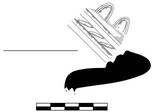
89. Gray Ware Plate (BC 50 to AD 50)
D08.0608:1. SC07-5d. Single floor sherd. Compact gray fabric, dark glossy slip on interior, unslipped outer surface. Single groove around center, single preserved ivy-leaf stamp around that, three bands of rouletting.
First published as no. 68. From disturbed layers above Augustan well-deposit.
90. Gray Ware Plate (BC 50 to AD 50)
Th. .0072.
D09.1969:9. SC08-1i. Single floor sherd, rouletting on upper surface.
91. Ephesian Gray Ware Plate Base (Early Roman)
K/L16/17.0467:13. P.H. .018, D. bas .12 (1/5 preserved), th. floor .005. Single base sherd. Plate with flat floor and ring foot. Dark gray fabric (2.5Y 4/1) with occasional angular white inclusions. Partially preserved dark gray (5B 2.5/1) slip on interior. Exterior plain.
svg/K-L16-17.0467-13.jpg
92. Molded Pyxis Base (Early Roman)
P. H. .071. Est. diam. base .13 (1/6 preserved). Th. .032.
K17.0845:12. Single sherd, lower wall and single applied foot. Dark gray (Gley 1 – 10Y 3/), slightly granular fabric with tiny white inclusions visible against the dark matrix. There are also rare large lime chunks, .002 in length, flattened on the surface or visible in the break, and a single large white chunk, 4.2mm, exploding in foot; single surface void. The surface is coated dark gray (Gley 1 N 3/) where not abraded. The decorative scheme is only partially restorable. A heron leans in from the left but only its long neck and head is preserved. It is pecking at a bunch of grapes. Beneath the heron’s neck is a long stem with further vegetal design below. This left part is relatively clear. The subject is unclear to the right. It seems to be a dense thicket of vines, no human or animal forms are recognizable. The only somewhat well-defined feature is a vertical cluster which starts as one line at its bottom but becomes two. The scene is reminiscent of early first century Italian motifs.
K17.0845-12.jpg
93. Gray Ware Jug Base (Early Roman)
P. H. .029. Est. diam. base .06 (completely preserved preserved). Th. .0031.
K/L16/17.0461:26. Single sherd of complete base, short grooved ring foot. Soft flakey brown (2.5YR 4/4) fabric, highly micaceous. Exterior surface is gray (10YR 4/1), darker and glossy where slip is best preserved. The interior has a spiral smoothing mark. It is noteworthy that the interior surface is very similar to the surfaces of micaceous water jars (MRA/LRA 3). This further indicates a south-west Anatolian source.
svg/K-L16-17.0461-26.jpg
94. Macedonian Gray Sigillata (Fourth Century)
P. H. 2.2. Est. diam. rim .12 (1/10 preserved). Th. .005.
D20.0183:16. Single sherd, ledge rim. Gray fabric highly micaceous, thin fine gray slip.
95. Italian Sigillata Conspectus Form 12.1 Rim (Mid- to Late Augustan)
P. H. .029. Est. diam. rim .30 (1/16 preserved). Th. .0039.
K/L16/17.0467:2. Single sherd. Pale pink fabric (2.5YR 7/6), deep red slip (10R 4/6) worn in places but otherwise evenly applied to achieve a high sheen.
Cf. form 12, p. 72, plate 11.
svg/K-L16-17.0467-2.jpg
96. Italian Sigillata Conspectus Form 12.5 Rim (Mid- to late Augustan)
P. H. .021. Est. diam. rim .18 (<1/20 preserved). Th. .0042.
K/L16/17.0467:1. Single sherd preserves 1/20 rim circumference. P.H. .021, D. rim 18, Th. .0042. FPale pink fabric (2.5YR 7/6), deep red slip (10R 4/6) worn in places but otherwise evenly applied to achieve a high sheen.
Cf. p. 72, plate 11.
svg/K-L16-17.0467-1.jpg
97. Italian Sigillata Chalice (Tiberian-Claudian)
z07.0020:1. SC09-2c. Two joining sherds. Hard-fired, orangish core. Very fine surface with chunks of lime on the surface.
First published as , no. 13. Cf. R 9.3.1, p. 178, plate 58.
z07.0020-1.jpg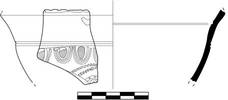
98. Italian Sigillata Conspectus Form 18.2.1 Rim
P. H. .03. Est. diam. rim .30 (1/20 preserved). Th. .0057.
K17.0129:1. SC09-2a. Single sherd with wall and beginning of floor. Reddish brown (2.5YR 5/6) fabric, very fine with no inclusions visible. Very glossy dark red (near 10R 4/8) slip on all surfaces, flaking in places.
Cf. form 18.
K17.0129-1.jpg
99. Italian Sigillata Conspectus Form 20.4 Rim (Domitianic)
P. H. .03. Est. diam. rim .295 (1/12 preserved). Th. .0044.
K/L16/17.0169:2. Two non-joining sherds with wall and beginning of floor. Reddish brown (2.5YR 6/3) fabric, very fine with occasional light inclusions. Very glossy dark red (near 10R 4/8) slip on all surfaces, flaking in places. Rouletting on upper and lower molding.
Cf. form 20.
svg/K-L16-17.0169-2.jpg
100. Italian Sigillata Conspectus Base 12
P. H. .03. Est. diam. rim .295. Est. diam. base .08 (1/12 preserved). Th. .0037.
M18.0435:1. Red (near 2.5YR 6/4) highly compact fabric with essentially no inclusions. Deep red (25.YR 4/8) slip on all surfaces, smoothed on interior, brushed on exterior. Two concentric incised grooves on floor, positioned just inside of high ring foot.
Cf. p. 158, Abb. 6. This type of foot is associated only with Conspectus form 20. Its relative height suggests a date in the second half of the first century.
svg/M18.0435-1.jpg
101. Italian Sigillata Conspectus Form 20.5.2 Rim
Est. diam. rim .165.
y07.0458:1.
Cf. form 20.5.2.
y07.0458-1.jpg
102. Italian Sigillata Hemispherical Cup, Cf. Conspectus Form 36 (1st Century AD)
P. H. .0175. Est. diam. rim .15. Th. .003.
K/L16/17.0434:21. Single rim sherd preserves 1/10 rim diameter. P.H. .0175, est. D. rim .15, Th. .003. Fine light reddish-brown (2.5YR 6/6) fabric with no inclusions observed. The slip is dark reddish brown (2.5YR 4/8) with white underslip visible where slip is flaking away.
Cf. p. 114, pl. 32..
svg/K-L16-17.0434-21.jpg
103. Italian Sigillata Flanged Bowl (1st Century AD)
P. H. .03. Est. diam. rim .06 (1/20 preserved). Th. .004.
K/L16/17.0434:28. Single rim sherd. Single rim sherd. Pale pink (5YR 7/4) fabric with no visible inclusions. Dark red (nearest 10R 4/8) slip smoothly applied to all extant surfaces but worn on outer face of rim. The slip is relatively glossy.
Cf. forms 23 and 34 (both 1st century).
svg/K-L16-17.0434-28.jpg
104. Italian Sigillata Conspectus 20.4 Plate Rim (Mid 1st Century AD)
z06.0017:3. SC09-2c. Single rim sherd. Legs of striding figure in appliqué extant on outer face of rim.
First published as , no. 12. Cf. 20.4, p. 86, plate 18; where this form is said to "the most common form of plate in contexts of the mid first century AD."
z06.0017-3.jpg
105. Italian Sigillata Conical Cup, cf. Conspectus Form 22 (early-mid 1st century AD)
P. H. .026. Th. .024.
K17.0071:22. Single rim sherd. Fine pale red (2.5YR 6/6) fabric with very rare tiny light inclusions. Slip is dark red (nearest 2.5YR 4/8). Some voids , one visible on surface (.005 in length).
First published as no. 4. Cf. form 22.
K17.0071-22.jpg
106. Italian Sigillata Conspectus Form 22 Type Base (perhaps Augustan)
. P0638. "CVB" in rectangular stamp.
First published as , no. 19. Cf. form 22. For stamp 2373 (near 36, without dot), C. Vibenius Faustus (Arezzo).
svg/P0638.jpg
107. Italian Sigillata Conspectus Form 22 Type Base (Tiberian)
. P0637. "HERMAI" in planta pedis.
First published as , no. 21. Cf. form 22. For stamp see 926, Hermaiscus (Pozzuoli); no. 18 for this potter is a planta pedis looking right with toes not separately rendered.
svg/P0637.jpg
108. Italian Sigillata Conspectus Form 23.2 Conical Cup (50-100)
P. H. .033. Est. diam. rim .07 (1/4 preserved). Th. .02.
K/L16/17.0100:6. Single rim sherd. Fine pale red (2.5YR 6/6) fabric with very rare tiny light inclusions. Slip is dark red (nearest 2.5YR 4/8). Molded double scroll on outer face of rim.
Cf. form 23.
svg/K-L16-17.0100-6.jpg
109. Italian Sigillata Cup with Everted Rim, cf. Conspectus 27.1 (Mid 1st Century AD)
P. H. .025. Est. diam. rim .10 (1/20 preserved).
K/L16/17.0474:12. Single sherd. Fine fabric is light red (10R 6/6). Dark red slip (10R 4/8) is evenly applied on all surfaces. The exterior is smoothed, the interior shows brush marks.
p. 100, pl. 25. Among the most common forms in the South Stoa deposit at Corinth.
svg/K-L16-17.0474-12.jpg
110. Italian Sigillata Conical Cup
P. H. .024. Th. .005.
K/L16/17.0427:20. Single carinated body fragment. Very pale red-yellow (5YR 7/6) fabric with occasional darker inclusions and voids. Thick and well-smoothed dark red (10R 5/8) slip on all surfaces.
svg/K-L16-17.0427-20.jpg
111. Italian Sigillata Cup with Everted Rim, cf. Conspectus 32.1.1
P. H. .019. Est. diam. rim .07 (<1/20 preserved).
z06.0017:2. SC09-2e. Single rim sherd. Fine fabric is light red (10R 6/6). Dark red slip (2.5YRR 4/8) is evenly applied on all surfaces. Three bands of rouletting on exterior surface, applied scroll on upper surface of rim.
First published as no. 10. form 32.1.1.
z06.0017-2.jpg
112. Italian Sigillata Chalice. Cf. Conspectus R2 or R3 (Augustan to Tiberian)
P. H. .046. Est. diam. rim .18 (1/8 preserved). Th. .0025.
K17.0848:1. Single sherd. Very fine, light red (2.5YR 6/6) fabric with no visible inclusions. Dark red (near 10R 4/8) slip, high gloss.
R2 or R3.
K17.0848-1.jpg
113. Italian Sigillata Bowl, cf. Dragendorff 29 or 37
P. H. .019. Est. diam. rim .07 (<1/20 preserved).
K/L16/17.0398:3. Single body sherd. P.H. .03, Th. .003. Very fine pale pink (2.5YR 5/4) fabric with occasional tiny white inclusions. The red (nearest 10R 5/8) slip is darker on the exterior where drips increase the thickness. The interior is polished smooth whereas the exterior is brushed below the line of molded decoration. The molded decoration consists of a single extant line of lop-sided six petalled leafs. Of the six present, four are, except for small chips, completely preserved. These show that at least two stamps were used in an ‘abab’ pattern. From the left stamp ‘a’ occupies positions 1 and 2. It is shorter than stamp ‘b’ but like it has a lower left petal that is more pronounced than its partner on the right, which is oriented more vertically and so merges with the middle petal. The alternation of stamps and their asymmetry may have given a more lively feel to the decoration of the vessel as a whole. It is noteworthy that a very fine and precisely executed incision on the interior lies at the same level as the base of the decoration on the interior.
svg/K-L16-17.0398-3.jpg
114. Uncataloged Italian Sigillata Body Sherd
K/L16/17.0169:12.
115. Eastern Sigillata Bi Footed Bowl Base (late 1st Century BC - early 1st Century AD)
P. H. .016. Est. diam. base .016 (<1/4 preserved). Th. .0035.
K/L16/17.0430:1. Complete base. Fine orange brown (2.5YR 6/8) fabric with tiny golden mica. Interior is covered with thick and very smooth orange (2.5YR 4/8) slip, thinner on exterior; underside of foot is plain. There is excess clay and surface voids on underside of base.
Cf. , nos. H73-83.
svg/K-L16-17.0430-1.jpg
116. Eastern Sigillata Bi Hayes Form 4 Rim (early 1st)
P. H. .024. Est. diam. rim .18.
K/L16/17.0427:5. Single rim sherd. Micaceous orange-brown (2.5YR 4/6) fabric, red (2.5YR 4/8) slip. Light rouletting under rim.
, tavola xi.13.
svg/K-L16-17.0427-5.jpg
117. Eastern Sigillata Bi Hayes Form 12 Rim (AD 50-75)
H. .026. Est. diam. rim .016 (<1/10 preserved). Th. .0047.
z06.0025:1. Single rim sherd. Downturned rim. Rouletting on outer face of rim.
, tavola XII.3. Shares characteristics with , no. H22.
z06.0025-1.jpg
118. Eastern Sigillata Bi Plate near Hayes Form 14 Rim (AD 50-100)
Th. .007.
z07.0052:3. Single rim sherd. Too small to recover diameter, stance provisional. High rim with external carination at meeting of floor and rim, two narrow grooves below interior rim.
Cf. , tavola XII.6; also , nos. 62 and 63; , no. H1. None of these have as sharp an external carination nor interior grooves.
z07.0052-3.jpg
119. Eastern Sigillata Bi Hayes near Form 14 Rim (AD 50-75)
Est. diam. rim near .015 (<1/20 preserved). Th. .0037.
K/L16/17.0461:11. Single small rim sherd preserving upper wall. Fine brown fabric (2.5YR 5/6) with frequent tiny golden mica. Flaking red (2.5YR 4/8) slip on all preserved surfaces. Small groove under interior rim.
, tavola XII.4.
svg/K-L16-17.0461-11.jpg
120. Eastern Sigillata Bi Hayes Form 22 Rim (Augustan)
H. .026. Th. .004.
z07.0029:1. Single rim sherd. Fine red (2.5YR 5/8) fabric with some mica. Slightly darker (2.5YR 6/8), thick and smoothed slip. Everted rim, upturned at outer edge.
, p. 57, tavola XII.16-17. , no. 36, , no. H95.
z07.0029-1.jpg
121. Eastern Sigillata Bi Cup Base, Cf. Hayes Form 31 (mid 1st century AD)
H. .0042. Est. diam. base .05 (1/6 preserved). Th. .0026.
K/L16/17.0461:2. Single base sherd, low rounded foot at edge of base. Red (2.5YR 5/8) fabric with frequent tiny mica, bright red (10R 4/8), thick and well smoothed slip.
, p. 60, tavola XIII.2.
122. Eastern Sigillata Bi Hayes Form 35 (mid 1st century AD)
H. .038. Est. diam. rim .086 (1/10 preserved). Th. .004.
K/L16/17.0120:5. Single sherd. Micaceous, very fine, brown (2.5YR 6/8) fabric. Flaking deep brown (2.5YR 4/8) slip on all surfaces, thicker under short rim.
, p. 60, tavola XIII.5.
svg/K-L16-17.0120-5.jpg
123. Eastern Sigillata Bi Hayes Form 40 Beaker Base (early first AD)
P. H. .017. Est. diam. base .07 (1/3 preserved). Th. .0027.
K17.0845:8. Single sherd, lower wall and floor. Micaceous brown (5YR 6/6) fabric, thick red (2.5YR 4/8) slip. Concentric grooves on underside and a single groove on lower exterior wall.
Cf. , p. 61, tavola XIII.12.
svg/K17.0845-8.jpg
124. Eastern Sigillata Bii Hayes Form 58 Profile (AD 50-125)
H. .031. Est. diam. rim .139. Est. diam. base .11.
. P0419. Almost complete. Soft fabric with shiny orangish slip, in some parts whitish (water irritation). Plate with low base and vertical rim. Double incision inside the rim; triple incised groove on the outside just above the base; central stamp with seven-petalled rosette in an indented circle; rouletting around the rim barely visible. From the Hadrianic deposits of the C29 well.
First published as no. 25. , p. 63, tavola 14.3.
svg/P0419.jpg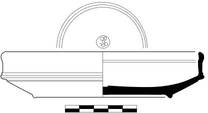
125. Eastern Sigillata Bii Hayes Form 58 Profile (AD 50-125)
H. .025. Est. diam. rim .12 (1/10 preserved). Th. .005.
D20.0093:2. Single rim sherd preserves profile. Soft, brown (2.5YR 6/8) fabric with frequent tiny mica. Slightly darker red slip (near 2.5YR 5/8) on exterior. Incised interior circle around base.
, p. 63, tavola 14.3.
D20.0093-2.jpg
126. Eastern Sigillata Bii Hayes Form 58 (AD 50-125)
H. .025. Est. diam. rim .14 (1/10 preserved). Th. .0043.
K17.0860:59. Single rim sherd. Soft, brown (5YR 6/6) fabric with frequent tiny mica. Flaking, red slip (near 10R 4/8) . Single incised line under rim.
, p. 63, tavola 14.3.
K17.0860-59.jpg
127. Eastern Sigillata Bii Hayes Form 58 (AD 50-125)
H. .026. Est. diam. rim .145 (1/8 preserved). Th. .0068.
K17.0860:60. Single rim sherd. Soft, reddish brown (2.5YR 6/8) fabric with frequent tiny mica. The thick darker slip (2.5YR 6/8) is flaking off.
, p. 63, tavola 14.3.
K17.0860-60.jpg
128. Eastern Sigillata Bii Hayes Form 58 Rim (50 to 125 AD)
P. H. .017.
K/L16/17.0474:5. Single rim sherd with part of floor. Compact brown (2.5YR 6/8) fabric with frequent golden mica. Dark red (2.5YR 4/8), flaking slip on all surfaces.
, p. 63, tavola XIV.
svg/K-L16-17.0474-5.jpg
129. Eastern Sigillata Bii Type 58 Base (AD 50 to 125)
P. H. .015. Est. diam. base .095 (1/5 preserved). Th. .0036.
K/L16/17.0427:2. Single base sherd. Micaceous orange-brown (2.5YR 4/6) fabric, red (2.5YR 4/8) slip is worn. Two incised grooves.
svg/K-L16-17.0427-2.jpg
130. Eastern Sigillata Bii Type 58 Base, fired black (AD 50 to 125)
P. H. .011. Est. diam. base .11 (1/5 preserved). Th. .0038.
K/L16/17.0100:26. Greenish gray (10YR 6/3) fabric with frequent mica. Thick polished black slip on all extant surfaces. Light groove outside of base on exterior.
svg/K-L16-17.0100-26.jpg
131. Eastern Sigillata Bii Type 58 Base
P. H. .011. Th. .0056.
K/L16/17.0427:15. Single base sherd. Micaceous orange-brown (2.5YR 4/8) fabric, dark red (10R 4/6) slip, flaking.
svg/K-L16-17.0427-15.jpg
132. Eastern Sigillata Bii Hayes Form 60b (100-150)
H. .032. Est. diam. rim .17 (1/10 preserved). Th. .004.
H17.0727:1. Single sherd preserves rim and wall to base. Soft, reddish brown (2.5YR 6/8) fabric with frequent tiny mica. Darker (2.5YR 5/8), thick slip on all preserved surfaces.
, p. 63, tavola 14.5-6. Cf. , no. 90 for date.
H17.0727-1.jpg
133. Eastern Sigillata Bii Hayes Form 60b (100-150)
H. .042. Est. diam. rim .20 (1/10 preserved). Th. .0055.
K17.0860:49. Single rim sherd. Soft, reddish brown (2.5YR 5/6) fabric with frequent tiny mica. Lighter (2.5YR 5/8) slip on all preserved surfaces.
, p. 63, tavola 14.7. Cf. , no. 89a for date.
K17.0860-49.jpg
134. Eastern Sigillata Bii Hayes Form 60b (100-150)
K17.0777:8. Single sherd preserves <1/20 of rim circumference. P.H. .034, est. D. near .28, Th. .007. Single rim sherd. Brown (2.5YR 6/8) micaceous fabric with red (10R 5/8 where darkest).
K17.0777-8.jpg
135. Eastern Sigillata Bii Hayes Form 61, fired black (AD 50-100)
H. .025. Est. diam. rim .20 (1/10 preserved). Th. .0035.
z08.0418:3. Two joining sherds preserve rim and part of floor. Gray () fabric with frequent mica. Dark gray, lustrous slip on all surfaces.
, form 61. Same profile at no. 78 (in red).
z08.0418-3.jpg
136. Eastern Sigillata Bii Hayes Form 66 Rim
Est. diam. rim .13.
C29.0473:1. Fabric was originally orange but now white; it had been burned or exposed to water.
First published as no. 31. , form 66, plate 14.17.
C29.0473-1.jpg
137. Eastern Sigillata Bii Hayes Form 73 Profile
H. .034. Est. diam. rim .081 (1/2 preserved). Est. diam. base .042.
. P0546. Upright rim has shallow grooves inside, a shallow groove outside just above the base, and a deep groove where the base stanfs. Thick, flaking bright orange slip. From the Hadrianic fill of the C29 well.
First published as no. 32. , form 73, plate 15.5.
svg/P0546.jpg
138. Eastern Sigillata Bii Hayes Form 76 variant (100-150 AD)
H. .042. Est. diam. rim .030 (<1/20 preserved). Th. .0063.
K/L16/17.0427:1. Two joining sherds sherd preserving complete profile. Micaceous orange-brown (2.5YR 4/6) fabric, red (2.5YR 4/8) slip. The distinctive features of the vessel are the ESB 76-type “hollow” base and the everted rim with rounded top that has two closely spaced grooves at its midpoint. The rim is also distinguished from the interior wall by a shallow offset. Likewise the floor and inner wall are separated by a groove. In general, the rim of this vessel suggests a large 55, whereas the base is good for a 76. An intermediate form would belong to the early 2nd century.
Cf. , p. 68-69; tavola XV.11.
svg/K-L16-17.0427-1.jpg
139. Eastern Sigillata Bii Hayes Form 76 (AD 100-150) variant
P. H. .022. Est. diam. rim near .26 (1/10 preserved). Th. .003.
K/L16/17.0398:10. Single sherd. Micaceous light red (2.5YR 6/8) fabric, deep red (2.5YR 4/8) soapy slip. Two grooves on upper face of rim. Identical rim form and treatment to K-L16-17.0427:1.
svg/K-L16-17.0398-10.jpg
140. Eastern Sigillata Bii Hayes Form 76 (100-150 AD)
H. .02. Est. diam. rim .024 (1/10 preserved). Th. .007.
K/L16/17.0467:7. Brown micaceous fabric (5YR 6/6), orange slip (10R 5/8) flaking in places and thickly applied under rim.
, p. 68-69; tavola XV.11.
svg/K-L16-17.0467-7.jpg
141. Eastern Sigillata B Bowl Base
z06.0007:32. SC09-1i. Single base sherd. Stamped floor.
142. ESC/Pergamene Hemispherical Bowl, Thin Wall
P. H. .042. Est. diam. rim .10 (1/4 preserved).
K/L16/17.0086:6. Two joining sherds, modern break. Very compact, light red (btw 10R 6/6 and 6/8) fabric with rare lime inclusions. Slip is red (10R 5/8) on interior and below stacking line on exterior. Above line it is darker (around 10R 4/4). A very well made piece, well fired, nice surface, etc. There is patch of thick slip on the exterior that has cracks in it.
no. 181 (Pergamene, ).
svg/K-L16-17.0086-6.jpg
143. Çandarli Loeschke Form 1 Plate Rim (AD 1-100)
D09.0185:1. SC11-1a. Single rim sherd.
p. 75, pl. XVI.16.
D09.0185-1.jpg
144. Çandarli Loeschke Form 1 Plate Rim (AD 1-100)
P. H. .013. Th. .01.
K/L16/17.474:6. Single body fragment with beginning of rim preserved. Fine reddish brown (2.5YR 5/8) fabric with occasional tiny white inclusions. Dark red (10R 5/8) slip on all surfaces. Small groove near outer edge of floor on exterior.
svg/K-L16-17.0474-6.jpg
145. Çandarli Loeschke Form 1 Plate Rim (AD 1-100)
P. H. .036. Est. diam. rim .25 (<1/20 preserved). Th. .01.
K/L16/17.0434:1. Single sherd, with high rim and floor. Compact light red (2.5YR 6/6) fabric with infrequent tiny light. The surface slip is fired orange (near 2.5YR 5/8) and smoothed, though unevenly applied.
p. 75 and pl. XVI.16.
svg/K-L16-17.0434-1.jpg
146. Çandarli Loeschke Form 1/6-Type Plate Base
K/L16/17.0461:6. Single base sherd, 1/8 preserved. P.H. .013, est. D. base .08, Th. floor .003. Fine light red fabric (2.5YR 6/8) with bright orange slip (near 10R 5/8) thickly applied on interior, thin and unsmoothed on extant exterior. Small void on upper surface of floor.
svg/K-L16-17.0461-6.jpg
147. Çandarli Loeschke Form 1/6-Type Plate Base
K/L16/17.0461:13. Single base sherd of plate with flat floor and flaring ring foot, base 1/10 preserved. D. ba. .08, Th. floor .003. Fine light red fabric (2.5YR 6/8) with bright orange slip (near 10R 5/8) thickly applied on interior, somewhat more thinly applied on extant exterior. Scratches on exterior.
svg/K-L16-17.0461-13.jpg
148. Çandarli Loeschke Form 6 Profile (Late first to Second AD)
H. .024. Est. diam. rim .10 (1/10 preserved). Th. .005.
K/L16/17.0120:1. Compact light red fabric (2.5YR 6/6) with very few inclusions, occasional tiny micaceous flakes in direct sunlight. Thick well-smoothed orange (near 2.5YR 5/8) slip on interior, thin to almost plain on exterior.
p. 75 and pl. XVII.1.
svg/K-L16-17.0120-1.jpg
149. Çandarli Loeschke Form 6 Profile (Late first to Second AD)
H. .023. Est. diam. rim .12 (1/10 preserved). Th. .001.
K/L16/17.0427:6. Fine light red (2.5YR 6/8) fabric with occasional tiny white inclusions. Darker slip (towards 2.5YR 5/8) is relatively orange for ware, extant on all surfaces, including underside of foot, thicker and smoothed on interior. Exterior shows narrow smoothing bands on curved wall and scratches closer to the base. Interior has two sets of concentric incised grooves on floor.
p. 75 and pl. XVII.1.
svg/K-L16-17.0427-6.jpg
150. Çandarli Loeschke Form 6 Rim (Late first to Second AD)
P. H. .026. Est. diam. rim .15 (1/5 preserved). Th. .006.
K/L16/17.0474:3. Singe rim sherd. Fine orange (5YR 6/6) fabric with occasional tiny light and dark inclusions. Smoothed dark orange slip (near 2.5YR 6/8) on interior. Exterior slip same but slightly thinner. Exterior shows distinct smoothing bands.
p. 75 and pl. XVII.1.
svg/K-L16-17.0474-3.jpg
151. Çandarli Loeschke Form 6 Rim (Late first to Second AD)
H. .021. Est. diam. rim .14 (1/8 preserved). Th. .004.
K/L16/17.0427:4. Single rim sherd. Fine light red (2.5YR 6/8) fabric with occasional tiny white inclusions. Darker slip (towards 2.5YR 5/8), thicker and smoothed on interior, brushed on exterior with subtle smoothing bands.
svg/K-L16-17.0427-4.jpg
152. Çandarli Loeschke Form 6 Rim
H. .022. Est. diam. rim .21 (1/20 preserved). Th. .004.
K/L16/17.0434:20. Single rim sherd. Light brown (5YR 6/6) fabric with rare tiny light inclusions. The thick red (2.5YR 5/8) slip has stick smoothing bands on the interior and exterior.
svg/K-L16-17.0434-20.jpg
153. Çandarli Loeschke Form 6 Base (50-100)
P. H. .011. Th. .004.
K/L16/17.0120:17. Single sherd. Fine light red fabric (2.5YR 6/6) with rare miniscule inclusions. Thick lustrous orange (near 2.5YR 5/8) slip, smoothed on interior, slightly thinner and less well smoothed on exterior.
svg/K-L16-17.0120-17.jpg
154. Çandarli Fragment, near Loeschke Form 6 (50-100)
K/L16/17.0434:3. Single body sherd preserving turn to rim and initiation of base. P.H. .020, Th. wall .005. Fine brown (2.5YR 5/8) fabric with very rare tiny light inclusions. The interior surface is bright orange (lighter than 2.5YR 5/8) and well smoothed but with stick smoothing bands on the extant inner surface of the rim. The exterior is thinly slipped, almost plain, below the rim. Stick smoothing bands on outer surface.There is a single band of rouletting on the interior above the circumference of the base.
svg/K-L16-17.0434-3.jpg
155. Çandarli Loeschke Form 9 Profile
K/L16/17.0114:17. Three joining sherds preserve profile. P.H., est. D. rim .15 (1/3 preserved), Th. wall .005. Heavily accreted sherd and damaged from leaching. Fabric has gone soft and pink, slip very worn and discolored. :42 is another non-joining sherd of this vessel.
svg/K-L16-17.0114-17.jpg
156. Candarli Loeschke Form 9 Bowl Rim (First to Second Century AD)
P. H. .029. Est. diam. rim .16 (1/10 preserved). Th. .005.
K/L16/17.0434:24. Single sherd. The light red (10R 6/8) fabric has occasional tiny white inclusions. The dark red (nearest 10R 5/8) is smoothed on the interior but shows fine brush marks on the exterior.
svg/K-L16-17.0434-24.jpg
157. Çandarli Loeschke Form 9 Rim (First to Second AD)
H. .021. Est. diam. rim .11 (1/5 preserved). Th. .006.
I17.0647:9. Single sherd to floor. Fine light red (10R 6/8) fabric with tiny light inclusions, no mica. Surface is dark red (10R 5/8), thick slip is variably applied. Interior and exterior have alternating spiraling bands of smoothed and unsmoothed slip.
p. 76 and fig. XVII.2.
I17.0647-9.jpg
158. Çandarli Loeschke Form 9 Base (First to Second AD)
P. H. .014. Th. .006.
K/L16/17.0120:12. Single sherd with part of floor and wall. Compact red fabric (10R 5/8) with few tiny white inclusions. Dark red (10R 4/6) slip on interior and exterior, worn in places.
p. 76 and fig. XVII.2.
svg/K-L16-17.0120-12.jpg
159. Candarli Loeschke Form 9 Bowl Base (First to Second AD)
P. H. .036. Est. diam. base .10 (1/10 preserved). Th. .006.
K/L16/17.0169:3. Compact red (10R 5/6) fabric with occasional small light, elongated inclusions. Red (near 10R 4/8) slip on all surfaces. Smoothed interior, brush marks on exterior.
p. 76 and fig. XVII.2.
svg/K-L16-17.0169-3.jpg
160. Candarli Loeschke Form 9 Bowl Base (50-125)
K/L16/17.0169:11. Light red fabric. Smooth slip on interior, now flaking. Very worn on exterior but was thinner than interior. Drawing is wrong.
svg/K-L16-17.0169-11.jpg
161. Candarli Loeschke Form 9 Bowl Base (50-125)
K/L16/17.0169:17. Single base sherd. P.H. .01, base diameter not recoverable, Th. .007. Light red (2.5YR 6/8) fabric. Well polished darker red (10R 5/8) slip on interior. Thinner on exterior.
svg/K-L16-17.0169-17.jpg
162. Candarli Loeschke Form 9 Bowl Rim (50-125)
K/L16/17.0427:289. Single rim sherd, 1/10 preserved. P.H. .0175, est. D. rim .19, Th. .003. Single rim sherd. Fine pale red (2.5YR 7/6) fabric with occasional tiny light inclusions. Red (10R 5/8 and lighter) slip of varying thickness on all extant surfaces.
svg/K-L16-17.0427-29.jpg
163. Çandarli Loeschke Form 15 Rim (AD 50 to 100)
H. .032. Est. diam. rim .09 (1/10 preserved). Th. .0039.
K/L16/17.0461:5. Single sherd. Compact light red fabric (2.5YR 6/8) with no visible inclusions, bright orange slip (near 2.5YR 5/8) thickly applied on interior surface, thinner under flange and on exterior.
svg/K-L16-17.0461-5.jpg
164. Eastern Sigillata C Bowl with Recurved Handle (Late 1st BC to early 1st AD)
K/L16/17.0398:1. P.H. .036, est. D. rim .20 (<1/10 preserved), Th. .003. Single rim and handle sherd. Fine pale brown (near 2.5YR 6/6) fabric with infrequent reddish inclusions and occasional tiny voids. The thick red (10R 5/8) slip is very smooth, though some brush marks are still visible, on the interior face of the rim. On the exterior the slip is equally thick but duller and brush are preserved around the handle attachments.
See no. 163 for comparanda and date.
svg/K-L16-17.0398-1.jpg
165. Çandarli Chalice or Modiolus
K/L16/17.0398:2. P.H. .054, est. D. rim .19 (<1/6 preserved), Th. wall min. .003. Single rim sherd. The light reddish-brown (near 2.5YR 6/6) fabric has only occasional small light inclusions. The slip is dark red (nearest 10R 4/6). It is thick and smoothed on the exterior, but thinner with brush marks on the interior. This form is not illustrated in Hayes 1986 but he does mention a Candarli modiolus on p. 74 where he sites J. Schafer (1968), p. 69-70. Italian “modioli” are 1st century. Apart from the relative fineness of the fabric, there is little to distinguish this sherd from the mainstream 2nd into 3rd century products.
svg/K-L16-17.0398-2.jpg
166. Çandarli Loeschke Form 15 Rim (AD 50 to 100)
H. .0356. Est. diam. rim .08 (<1/20 preserved). Th. .0051.
K17.0860:36. Single rim sherd. Somewhat brown (nearest 5YR 6/6) fabric, small golden mica. No other inclusions visible except under 10x when a few tiny lighter bits appear. Slip is red (near 2.5YR 4/8), thick and smooth on all surfaces. Brush marks are very clear on interior of rim. Tooled smoothing bands on wall. Exterior is relatively smooth, no scratches on wall.
K17.0860-36.jpg
167. Çandarli Loeschke Form 19 Rim (75 to 150 AD)
P. H. .042. Th. .004.
K/L16/17.0474:1. Single rim sherd with wall below flange. Compact light red (2.5YR 7/6) fabric with occasional small white inclusions. Darker red (near 2.5YR 4/8) slip on all preserved surfaces. Smooth interior, brush marks visible on exterior.
svg/K-L16-17.0474-1.jpg
168. Çandarli Loeschke Form 19 Flanged Bowl Rim
P. H. .035. Est. diam. rim .15 (<1/20 preserved). Th. .004.
K/L16/17.0456:1. Single small rim sherd, upper tip of rim is chipped but its shape is fully restorable. Compact light red (2.5YR 6/6) fabric with tiny dark inclusions and small elongated voids. Slip on interior is red (near 10R 5/8) and well smoothed, as is the outer rim above the flange. The exterior slip below the flange is thinner, scratches; thick cracking slip under flange. Horizontal groove on the outer face of the rim just above the flange. Subtle groove below flange on outer face, a side effect of smoothing under the flange.
p. 76, pl. XVII.4-6. Similar groove on outer face of rim at , no. 818.
svg/K-L16-17.0456-1.jpg
169. Çandarli Loeschke Form 19 Flanged Bowl Rim
P. H. .031. Est. diam. rim .072 (1/4 preserved). Th. .003.
K/L16/17.0114:21. Single sherd, rim with initiation of base. Light red (2.5YR 7/6) fabric with occasional rounded light inclusions and voids. Dark red (10R 4/8) slip on all surfaces. Thick and smooth on interior and above flange on exterior. Thinner with broad drip lines on exterior below flange, plain patch on exterior.
p. 76, pl. XVII.4-6.
svg/K-L16-17.0114-21.jpg
170. Çandarli Loeschke Form 19 Flanged Bowl Rim (75 to 150 AD)
P. H. .04. Est. diam. rim .075 (1/4 preserved). Th. .004.
K/L16/17.0114:22. Single sherd preserves profile. Light red (2.5YR 7/8) fabric with occasional rounded lime inclusions and occasional voids. Dark red (10R 4/8) slip on all surfaces. Thick and somewhat smooth on interior; thinner and uneven on exterior, especially under flange. Very near in fabric and surface appearance to :21.
p. 76, pl. XVII.4-6.
svg/K-L16-17.0114-22.jpg
171. Çandarli Loeschke Form 19 Flanged Bowl Rim
P. H. .046. Est. diam. rim .12 (1/5 preserved). Th. .005.
K/L16/17.0114:20. Single rim sherd including wall to base. Compact light red (2.5YR 7/8) fabric with occasional small lighter inclusions and infrequent tiny voids. Occasional gold mica. Dark red (10R 4/8) slip on all surfaces. Thick but poorly smoothed on interior and above flange on exterior. The thick slip extends irregularly below the flange.
p. 76, pl. XVII.4-6.
svg/K-L16-17.0114-20.jpg
172. "High Gloss" Çandarli Loeschke Form 19 Flanged Bowl Rim
P. H. .031. Est. diam. rim .115 (1/10 preserved). Th. .004.
K/L16/17.0114:19. Two joining sherds preserving rim and wall. Reddish-yellow color (7.5YR 7/6) of the fabric is the result of a nearly even mix of red and yellow particles, which are discernible at 10x magnification. No other inclusions were observed but occasional tiny voids are present. The dark red slip (near 10R 4/6) is thin with metallic sheen. Slight brush marks are visible on the interior, whereas the exterior below the flange exhibits more distinct banding and scratches.
svg/K-L16-17.0086-9.jpg
173. Çandarli Loeschke Form 19 Profile (75 to 150)
P. H. .058. Est. diam. rim .116 (<1/10 preserved). Th. .005.
K/L16/17.0146:8. Pale red (10R 6/6) fabric with rare tiny dark inclusions and infrequent voids. The dark red slip (near 10R 4/8) is thin with metallic sheen. The interior and outer face of the rim are well smoothed. The exterior is rougher and parts of the outer face of the base are plain where the slip did not drip down completely; underside of the base is only partially slipped. There is a large surface void on the underside of the base.
svg/K-L16-17.0146-8.jpg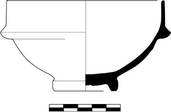
174. Çandarli Loeschke Form 19 Flanged Bowl Rim
P. H. .064. Est. diam. rim .18 (<1/10 preserved). Th. .0055.
K/L16/17.0114:23. Single rim sherd. Fabric is light reddish-brown (2.5YR 6/6) with frequent pale inclusions that create a “mottled” effect. The slip is dark (darker than 10R 4/8) and shiny, close to Italian Sigillata but not so even. No mica. It is worn away on much of the extant outer rim, a common occurrence with this Candarli variant. The slip is evenly applied below the exterior flange and has the same sheen but the surface of the vessel is less carefully smoothed as scratches are visible. There are two incised lines on the inner wall of the vessel placed at a level just above the lower edge of the outer flange.
p. 76, pl. XVII.4-6.
svg/K-L16-17.0114-23.jpg
175. Çandarli Loeschke Form 19 Flanged Bowl Profile (75 to 150 AD)
M18.0073:1. SC11-2q. Single sherd preserving profile. Patches of thin slip on exterior.
p. 76, pl. XVII.4-6.
svg/M18.0073-1.jpg
176. Çandarli Loeschke Form 19 Flanged Bowl Profile (75 to 150)
K17.0071:20. SC11-1t. Single sherd preserving profile. Fugitive slip on outer face of rim. Patches on ring foot are reserved. Large surface voids on exterior.
p. 76, pl. XVII.4-6.
K17.0071-20.jpg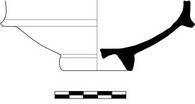
177. Çandarli Loeschke Form 19 Flanged Bowl Rim
K/L16/17.0114:26. Single sherd partially preserving rim above flange. P.H. .026. Light red (10R 6/6) fabric with occasional tiny light inclusions - some of which are highly reflective - and occasional voids. Thin red (2.5YR 4/8) slip, evenly applied with metallic sheen, though not quite "high gloss". Wear on outer rim above flange.
svg/K-L16-17.0114-26.jpg
178. Çandarli Loeschke Form 19 Flanged Bowl Rim
P. H. .025. Est. diam. rim .11 (1/8 preserved). Th. .003.
K/L16/17.0112:11. Single rim sherd. Compact reddish-brown (2.5YR 6/8) fabric with rare tiny inclusions. Darker red (10R 5/8) slip on all extant surfaces. There are broad smoothing bands visible on the interior and exterior. Cf. Slane 1994, no. 3 for similar profile and fabric dated to 3rd century.
svg/K-L16-17.0112-11.jpg
179. Çandarli Loeschke Form 19 Flanged Bowl Rim
P. H. .031. Est. diam. rim .12 (1/20 preserved). Th. .0041.
K/L16/17.0112:12. Single rim sherd. Compact red (10R 6/6) fabric, few tiny white inclusions. Red (2.5YR 4/8) slip on all extant surfaces. Wide smoothing bands visible on all surfaces.
svg/K-L16-17.0112-12.jpg
180. Çandarli Loeschke Form 19/Hayes Form 3 Flanged Bowl Rim
P. H. .031. Est. diam. rim .20 (<1/12 preserved).
K/L16/17.0118:5. Single sherd. Compact red (2.5YR 6/6) fabric with frequent tiny light, elongated inclusions. The red (near 10R 5/8) slip is evenly applied on all extant surfaces. Broad smoothing bands on both interior and exterior.
svg/K-L16-17.0118-5.jpg
181. Çandarli Hayes Form 3 Flanged Bowl Rim (2nd Century AD)
P. H. .044. Est. diam. rim 12 (1/8 preserved). Th. .008.
K/L16/17.0086:18. Single sherd. Light red (2.5Yr 6/6) fabric with rare tiny light inclusions. Slip is (10R 4.5/8) and generally thick. Rim is poorly formed at top
svg/K-L16-17.0086-18.jpg
182. Çandarli Loeschke Form 19 Flanged Bowl Rim (75 to 150)
H. .051. Est. diam. rim .11 (1/3 preserved). Th. .0046.
K17.0860:33. Two joining sherds, profile. Light red (10R 6/8) fabric with mostly frequent lime but also darker bits and frequent very small voids. Mica on surface. Slip is red (10R 5/8), slightly smoother and thicker on interior.
K17.0860-33.jpg
183. Çandarli Loeschke 19 Flanged Bowl Profile (2nd Century AD)
Est. diam. rim .12. Est. diam. base .055.
I17.0893. P0241. Nearly complete small bowl. Compact orange fabric.
184. Çandarli Loeschke Hayes Form 3 Flanged Bowl Rim (Third Century AD)
H. .052. Est. diam. rim .12 (1/5 preserved). Th. .0039.
K17.0860:54. Single sherd, profile. Light red (2.5YR 6/6) fabric with tiny lime and other varied tiny inclusions. Occasional very small voids. Occasional gold mica. Dark red (10 4/6 where thickest) red slip, which is smooth and slightly glossy on interior. The exterior slip is mostly thinner but there is a patch where it is very thick and dark, particularly under the flange. There is a very fine line incised on the interior.
K17.0860-54.jpg
185. Çandarli Loeschke 19/Hayes Form 3 Flanged Bowl (2nd/3rd Century AD)
I17.0893. P0241. Lower part of small bowl.
186. Çandarli Hayes Form 3 Rim (late 2nd to 3rd century)
P. H. .035. Est. diam. rim .12 (<1/20 preserved). Th. .003.
K/L16/17.0398:18. Single rim sherd. Pale red (2.5YR 7/6) fabric with only tiny light inclusions and frequent small voids. The red (10R 5/8) slip is most thickly applied to the interior surface and outer rim above the flange, smoothed in bands. Below the flange the slip is thinner and only partially smoothed. Tooling under rim.
svg/K-L16-17.0398-18.jpg
187. Çandarli Hayes Form 3 Rim (late 2nd to 3rd century)
P. H. .026. Th. .004.
K17.0845:9. Single rim sherd, diameter not recoverable. Light red fabric (2.5YR 6/8) with small light and other dark inclusions, small voids. Pronounced outer edge of flange. The red (between 10R 4/8 and 5/8) slip is equally applied on all extant surfaces.
svg/K17.0845-9.jpg
188. Çandarli Hayes Form 3 Rim (late 2nd to 3rd century)
P. H. .025. Est. diam. rim .13 (1/10 preserved). Th. .0045.
K17.0777:7. Single sherd. Compact light red (10R 6/6) fabric with few light inclusions and occasional gold mica also visible on the surface. Unpolished thick red (10R 5/8) slip on all extant surfaces.
K17.0777-7.jpg
189. Çandarli Loeschke Form 20 Bowl Rim
P. H. .019. Est. diam. rim near .12 (<1/20 preserved). Th. .006.
K/L16/17.0120:2. Single sherd. Fine red (5YR 7/6) fabric, showing mix of redder and yellower grains. Red slip (2.5YR 5/8) on all surfaces. Brush marks on interior, smoothing bands on exterior.
svg/K-L16-17.0120-2.jpg
190. Çandarli Loeschke Form 20 Rim (First to Second AD)
P. H. .0331. Est. diam. rim .12 (<1/10 preserved). Th. .0036.
K/L16/17.0461:4. Single rim sherd. Compact light red fabric (5YR 7/6) with lustrous orange slip (near 2.5YR 5/8) thickly applied on all surfaces, exterior scratched.
svg/K-L16-17.0461-4.jpg
191. Çandarli Loeschke Form 20 Rim
K/L16/17.0148:2. P.H. .023, est. D. rim .078 (>1/6 preserved), Th. wall .0025. Single rim sherd. The fine light red (10R 6/6) fabric has rare tiny dark inclusions. The red (near 10R 5/8) slip is smooth on the interior. The exterior is thinner and the scratches on the vessel surface show through.
svg/K-L16-17.0148-2.jpg
192. Çandarli Loeschke Form 20 Rim
P. H. .036. Est. diam. rim .125 (1/7 preserved). Th. .0046.
K/L16/17.0086:21. Single sherd. Compact light red (5YR 7/6) fabric. Surface slip is red (2.5YR 5/8 and lighter). Exterior has light scratches and banding, interior is well smoothed.
svg/K-L16-17.0086-21.jpg
193. Çandarli Loeschke Form 23 Lid (AD 50 to 100)
P. H. .041. Est. diam. rim .11 (1/10 preserved). Th. .004.
K/L16/17.0114:8. Compact light red (2.5YR 6/6) fabric with few inclusions. Red (near 10R 5/8) slip is poorly preserved on pocked surface.
svg/K-L16-17.0114-8.jpg
194. Çandarli Loeschke Form 25 Rim (1st Century AD)
P. H. .034. Th. .006.
I17.0844:2. SC11-1c. Single rim sherd. Thick slip on all surfaces.
, no. 985.
I17.0844-2.jpg
195. “Bright Orange” Candarli Loeschke Form 26a Bowl (50-100)
P. H. .020. Est. diam. rim .10 (<1/20 preserved). Th. .003.
K/L16/17.0120:3. Single sherd, wall to initiation of floor. Fine orange fabric (2.5YR 7/6), bright orange (near 10R 5/8) slip on all surfaces. Scratches on exterior. Groove under exterior rim.
svg/K-L16-17.0120-3.jpg
196. Çandarli Rim, near Loeschke Form 26a
P. H. .027. Est. diam. rim .15 (1/8 preserved). Th. .0033.
K/L16/17.0461:16. Single sherd preserving wall and minimal part of floor. Fine red fabric (2.5YR 5/6) with orange interior surface (2.5YR 5/8 and lighter). Exterior surface is incompletely slipped, reserved towards base, and shows smoothing bands and scratches.
Cf. no. 770, "Loeschke type 26a (forerunner)".
svg/K-L16-17.0461-16.jpg
197. Çandarli Hayes Form 26a Bowl Base (50-100)
P. H. .05. Est. diam. base .10 (<1/20 preserved). Th. .009.
K/L16/17.0120:4. Single sherd. Fine fabric, pale pink (5YR 6/8) with occasional darker inclusions. Dark red slip (2.5YR 4/8) slip on all surfaces. Incised concentric circles on interior floor above base. A shallow offset indicates that the floor was smoothed with a broad tool whereas the walls show brush marks. High quality slip for ware.
svg/K-L16-17.0120-4.jpg
198. "High Gloss" Candarli Loeschke Form 26a/b Bowl (50-100)
Est. diam. rim .21 (<1/20 preserved). Th. .0035.
K/L16/17.0114:2. Three sherds, two joining, preserve profile. Pale (5YR 7/4) fabric with distinct lighter mottling. Occasional angular white inclusions up to .005 in length are also present. The slip is dark red (near 10R 4/6) with a high sheen on the interior and was evenly applied to all surfaces, it is now worn on the exterior below the rim, as is typical for highly fired Candarli. An incised circle is preserved on the interior floor above the base. It is partially obscured by a distinct “spacer” mark.
svg/K-L16-17.0114-2.jpg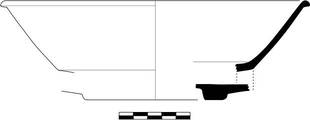
199. Candarli Loeschke Form 26a Bowl (50-100)
H. .05. Est. diam. rim .23 (1/4 preserved). Est. diam. base .10 (1/2 preserved). Th. .0049.
K17.0937:1. SC11-2ee. Two joining sherds, complete profile. Light red (2.5YR 6/8) fabric with rare tiny white inclusions, frequent mica. Large lime chunks, .002 in diameter, are visible in breaks and on surface (perhaps from post-depositional spalling?). Elongated voids, particularly near foot. Thick red (10R 5/8) slip on interior is smoothed, exterior matte and thinner. Conserved. Lightly incised groove around center of floor, very light groove on lowest wall.
K17.0937-1.jpg
200. Candarli Loeschke Form 26a/b Bowl (50-100)
H. .05. Est. diam. rim .23 (1/4 preserved). Th. .005.
K/L16/17.0114:10. Two joining sherds preserve profile. The compact reddish (2.5YR 7/6) fabric has rounded light inclusions ranging from tiny to <.005. Surface is encrusted and pitteed, surviving slip is red (near 10R 5/8). The form of the base is interesting. From one perspective it is a fine L26a with distinct ring foot. From another you can see the potter merging the outer face of the base with the lower exterior wall, that is creating a profile that is well on the way to being an L26b.
svg/K-L16-17.0114-3.jpg
201. Candarli Loeschke Form 26 Type Base
x07.0187:1. Incised palm leaf partially preserved on floor.
x07.0187-1.jpg
202. Candarli Loeschke Form 26 Bowl Rim
K/L16/17.0118:4. Single sherd preserves <1/12 circumference of rim. P.H. .018, est. D. rim near .16 (rim damaged), Th. .004. Fine red (2.5YR 6/6) fabric with infrequent tiny dark and occasional light inclusions. Red (near 10R 5/8) slip is thickly applied to the interior and well smoothed. The exterior slip is thinner and carries thin brush marks. Large voids under rim.
svg/K-L16-17.0118-4.jpg
203. Candarli Loeschke Form 26 Bowl Rim
K/L16/17.0118:6. Single sherd preserves 1/12 circumference of rim. P.H. .025, est. D. rim .16, Th. .025. Fine red (2.5YR 6/8) fabric with tiny white inclusions as well as some darker. Red (10R 5/8) slip is thick and smooth on interior, uneven and thinner on the exterior, also less well smoothed.
svg/K-L16-17.0118-6.jpg
204. Candarli Hayes Form 2
P. H. .047. Est. diam. rim .28 (1/12 preserved). Th. .005.
H17.0883:6. SC11-2f. Red (2.5YR 6/8) fabric with occasional light inclusionss. Darker slip (10R5/6) is smoothed on interior, thinner and matte on exterior. Radial smoothing marks on exterior.
205. Çandarli Hayes Form 2 Profile (Second to Third Century)
P. H. .053. Est. diam. rim .22 (1/8 preserved). Th. .006.
K17.0688:2. P0538. Three joining sherds preserving profile; sherds have been conserved. Compact red (10R 7/8) fabric with occasional light bits, mica visible on surface. Darker red (10R 5/8) slip; interior smoothed, exterior shows light brush lines. Two grafiti on exterior: "double-axe" in hollow base and palm frond on wall.
206. Candarli Hayes Form 2
P. H. .01. Est. diam. rim .12 (1/12 preserved). Th. .0045.
K/L16/17.0112:13. Single rim sherd. Compact red (10R 6/8) fabric with occasional tiny white inclusions, some voids, golden mica visible on surface. Red (near 10R 6/8) slip on all surfaces, thinner patch extant on exterior well below rim.
svg/K-L16-17.0112-13.jpg
207. Candarli Hayes Form 2
Est. diam. rim Not recoverable (small).
K17.0389:1. Single small rim sherd. Light red (2.5YR 6/6) fabric with occasional light inclusions. Darker red slip on extant surfaces. Two grooves are preserved near the rim on this small sherd.
K17.0389-1.jpg
208. Çandarli Hayes Form 2 (Bowl) Profile (Second to Third Century AD)
H. .054. Est. diam. rim .25 (1/7 preserved). Th. .0045.
K17.0177:1. SC11-2e. Single sherd preserving profile. Compact red (2.YR 6/6) fabric, darker red (2.5YR 5/8) slip on all surfaces. Interior slip is smoothed, exterior less so. Incised groove under rim. Spacer mark on interior floor and on exterior at lower carination. Excess clay on lower exterior wall.
p. 78, pl. XVIII.2.
K17.0177-1.jpg
209. Çandarli Hayes Form 2 Bowl Rim
P. H. .019. Est. diam. rim .20 (<1/10 preserved). Th. .006.
K17.0845:5. Single rim sherd. Light red (10R 6/6) fabric with frequent small light and dark inclusions and occasional voids up to .0035 in height. Gold mica visible in the fabric and flattened on the surface. The interior surface is worn but extant slip is dark for Candarli (between 10R4/4 and 4/6). The exterior is thinly slipped, unsmoothed, and lighter (10R 5/4) than the interior. Possibly burned.
svg/K17.0845-5.jpg
210. Çandarli Hayes Form 2 Bowl Rim
P. H. .02. Est. diam. rim ~.30 (1/10 preserved). Th. .0045.
K17.0845:6. Single rim sherd. Light reddish-brown (2.5YR 6/6) fabric with frequent small light inclusions. The red (10R 5/8) slip is thickly applied to the interior surface and well polished. The exterior slip is thinner with scratches.
svg/K17.0845-6.jpg
211. Çandarli Hayes Form 2 Bowl Rim
P. H. .013. Est. diam. rim .22 (1/20 preserved). Th. .004.
K17.0777:25. Single rim sherd. Reddish brown (5YR 6/6) fabric with occasional elongated lime and other darker inclusions and occasional tiny mica. The darker reddish brown (10R 4/4) slip is worn, particularly on the exterior surface. Rare voids. An example of the ‘worn slip’ variant of Candarli.
Cf. nos. 954-961.
K17.0777-25.jpg
212. Çandarli Form Loeschke 27 Rim (AD 50-150)
P. H. .045. Est. diam. rim .20 (<1/20 preserved). Th. .008.
K17.0696:5. Single rim sherd. Light red (2.5YR 6/6) fabric with only occasional elongated light inclusions. Red (2.5YR 5/8) slip on all surfaces, smoothed on interior, brushed on exterior.
Cf. nos. 975 and 976.
K17.0696-5.jpg
213. Çandarli Form Loeschke 41 Rim (2nd Century AD)
P. H. .039. Est. diam. rim .20 (<1/10 preserved). Th. .007.
K/L16/17.0427:3. Single rim sherd. Light red (2.5YR 7/6) with angular white and darker inclusions. Thin red (2.5YR 5/7) slip on all surfaces. Thickened, slightly inturned rim.
Cf. nos. 566-576. See also TS015, identified as a Loeschke 42. An ESC version of ESB Hayes 76.
svg/K-L16-17.0427-3.jpg
214. Çandarli Hayes Form 1 variant Rim (2nd - early 3rd Century)
P. H. .052. Est. diam. rim .25 (1/8 preserved). Th. .004.
K/L16/17.0419:1. Single sherd. Compact pale (5YR 7/6) fabric with tiny white and fewer tiny black inclusions. The dark red interior slip (between 10R 4/4 and 4/6) is evenly applied and smooth. The exterior slip is very much thinner, beginning at the outer face of the rim, where it is wearing through.
svg/K-L16-17.0419-1.jpg
215. Çandarli Hayes Form 1 variant Rim (2nd - early 3rd Century)
K17.0777:6. P.H. .025, est. D. rim .18, min. th. wall .0056. Single sherd. Light red (10R 6/6) fabric, very rare tiny light inclusions. Smoothly brushed darker red (10R 4/8) slip on interior. Slip is slightly thinner and no thin brush marks on exterior.
K17.0777-6.jpg
216. Çandarli Hayes Form 1 Rim (2nd - early 3rd Century)
P. H. .02. Est. diam. rim .25 (1/20 preserved). Th. .0054.
K17.0777:12. Compact light red (2.5 YR 6/6) fabric with tiny white inlcusions. Darker slip (10R 4/6). Slip is thin on all extant surfaces.
K17.0777-12.jpg
217. Çandarli Hayes Form 1 Base (2nd - 3rd Century)
P. H. .128. Est. diam. base .0958 (1/2 preserved).
K17.0860:26. Single base sherd. Pale pink (near 5YR 7/4) fabric with tiny varied, mostly light bits and occasional small reddish inclusions. Small voids, some elongated and up to .004 in length. Red (10R 4/8) slip is smoothed on interior with bands visible; thinner, matte on exterior with a few, short patches almost plain. Distinct groove between heavy foot and wall. Two spacer impressions on interior floor, both .0142 in diameter.
K17.0860-26.jpg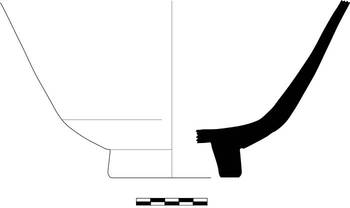
218. Çandarli Hayes Form 1 (Cf. Knossos 6) Base (2nd - 3rd Century)
P. H. .078. Est. diam. base .0966 (completely preserved). Th. .0059.
K17.0860:28. Two joining base sherds. Pale red (5YR 7/4) fabric with elongated and sub-rounded light, mostly calcareous, inclusions. Frequent very small irregular and elongated voids. Chip taken near base. Surface is darker red (10R 4/6). Thick and smoothed on interior. Exterior is thinner and is well smoothed only in wide bands. There is a floral stamp at the center of the floor but the design is not restorable. There is a single concentric circle around this central stamp. Two closely spaced incised lines on exterior. Two impressions of circular spacers are extant. One is .0125 in diameter, the other is .0142. The smaller has two chunks of the spacer adhering in the impression. The fabric of the spacer fragment is basically normal Candarli red (near 2.5YR 5/6, but small and hard to read). [N.B. the spacer may well have been fired many times so its is not necessarily indicative of much.] The slip and interior incised concentric groove go under the larger space remnant. This suggests that the bowl was brought to a “leather hard” stage when groove was “cut” and slip was applied. Then the piece was stacked in a kiln with spacers between the pieces. There is also a single spacer outline on the bottom of the ring foot. The diameter of this is not recoverable but may be near .0125. All the slip has worn off the bottom of the ring foot.
K17.0860-28.jpg
219. Çandarli Bowl Base
P. H. .033. Est. diam. base .09. Th. .004.
K/L16/17.0474:2. Base with high ring-foot, curved wall. Compact light red (2.5YR 6/6) fabric with occasional small white inclusions. Darker red (near 2.5YR 4/8) slip on all preserved surfaces. Smooth interior, brush marks visible on exterior.
See no. 20 for a Candarli base of similar form.
svg/K-L16-17.0474-2.jpg
220. Çandarli Hayes Form 4 Rim (200-300)
H. .034. Est. diam. rim .20 (1/12 preserved). Th. .005.
K/L16/17.0100:18. Single rim sherd. Compact red (2.5YR 5/6) fabric, no inclusions, occasional elongated voids; darker (10R 5/6) red slip on all surfaces.
p. 78, pl. XVIII.4.
svg/K-L16-17.0100-18.jpg
221. Çandarli Hayes Form 4 Profile (200-300)
H. .033. Est. diam. rim .17 (1/2 preserved). Th. .002.
K/L16/17.0417. P0656. Five joining fragments preserving complete profile. Fine red (2.5YR 7/6) fabric with occasional small white inclusions and more common small voids. All surfaces carry a dark red (between 10R 5/8 and 4/8) slip. The interior is smoothed though visibly thinner in places and the same treatment is applied to the rim above the carination. Below that the slip is more often thinner and less smooth. The body of the vessel here shows both scratches as well as irregular radial ridges – “turning mards” - that may be intentional but may also be the result of a too lightly applied smoothing instrument. There is a light smoothing spiral near the center of the floor on the interior.
p. 78, pl. XVIII.4.
svg/P0656.jpg
222. Çandarli Hayes Form 4 Rim (200-300)
P. H. .029. Est. diam. rim .19 (<1/12 preserved). Th. .003.
K/L16/17.0417:15. Single sherd. Compact light red (2.5YR 6/8) fabric with occasional light inclusions. Slip is poorly preserved but was dark red.
svg/K-L16-17.0417-15.jpg
223. Çandarli Hayes Form 4 Rim (200-300)
P. H. .03. Est. diam. rim .17 (<1/10 preserved). Th. .004.
K/L16/17.0104:1. Single rim sherd. Compact light red (2.5YR 7/6) fabric with red (2.5YR 4/8) slip. Very few inclusions. The slip has worn away on an uneven band approx. .015 from the upper lip. This may indicate a stacking line.
svg/K-L16-17.0104-1.jpg
224. Çandarli Hayes Form 4 Rim (200-300)
K17.0777:23. P.H. .03, D. rim not recoverable (<1/20 preserved), Th. .045. Single rim sherd. Light red (10R 6/6) fabric with frequent small lime inclusions, occasional gold mica. Unpolished thick red (10R 5/8) slip on all extant surfaces.
K17.0777-23.jpg
225. Çandarli Hayes Form 4 Rim (200-300)
K17.0777:31. P.H. .024, est. D. rim .20 (<1/10 preserved), Th. min. wall .004. Single rim sherd. Light red (10R 6/6) fabric with occasional lime tiny darker inclusions, and frequent tiny gold mica. Red (10R 5/8) slip is evenly applied on all surfaces. Stick smoothing bands visible beneath carination on exterior.
K17.0777-31.jpg
226. Çandarli Hayes Form 4 Rim (200-300)
P. H. .024. Est. diam. rim .14 (<1/20 preserved). Th. .004.
K/L16/17.0419:2. Compact reddish (2.5YR 6/6) fabric with few small dark as well as light inclusions. Red (10R 5/8) slip on all surfaces, smoother on interior.
svg/K-L16-17.0419-2.jpg
227. Çandarli Hayes Form 4 Rim (200-300)
H. .034. Est. diam. rim .28 (1/12 preserved). Th. .006.
K/L16/17.0398:16. Single rim sherd. The light red (2.5YR 6/6) fabric has frequent angular and elongated lime/white inclusions with frequent elongated voids. Occasional golden mica, including some flattened on surface. The interior slip is the normal dark red (near 10R 4/6) but the exterior is overfired above the slight carination that introduces the rim. A patch just under the rim is pale pink (2.5YR 8/2) with the rest being darker than normal (10R 4/4). This section carries a slight metallic sheen in comparison to the lower part. The lighter/normal red section below the carination was protected from this overfiring by being in a stack. The interior of the rim shows relatively broad stick smoothing bands. The exterior is smoother in parts but has unsmoothed strips between broader smoothed bands. There are also three long horizontal scratches on the exterior whereas none are present on the interior.
p. 78, pl. XVIII.4.
svg/K-L16-17.0398-16.jpg
228. Çandarli Hayes Form 4 Rim (200-300)
K/L16/17.0398:15. Single rim sherd preserves <1/20 circumference. P.H. .031, est. D. near .25, Th. wall .007. Fine red (10R 6/6) fabric with small and tiny white inclusions, as well some varied dark. There are frequent small voids. The dark slip (near 10R 4/6) is evenly applied to all surfaces.
svg/K-L16-17.0398-15.jpg
229. Çandarli Hayes Form 4 Rim (200-300)
K/L16/17.0398:17. Single sherd preserving <1/10 of circumference. P.H. .037, est. D. rim .30, Th. .006. The fine red (2.5YR 6/6) fabric has frequent tiny light and some darker inclusions as well as frequent elongated voids. The dark red (nearest 2.5YR 4/8) slip is evenly and thickly applied to both the interior and exterior with only faint traces of smoothing in bands.
svg/K-L16-17.0398-17.jpg
230. Çandarli Hayes Form 4 Base (200-300)
P. H. .016. Est. diam. base .12 (<1/10 preserved). Th. .0025.
K/L16/17.0417:7. Single sherd. Compact light red (near 2.5YR 6/6) fabric with lime as well as tiny black inclusions. Smooth but somewhat unevenly applied red (between 10R 5/8 and 4/8) slip on preserved interior. Much thinner slip on exterior, which also shows scratch marks.
svg/K-L16-17.0417-7.jpg
231. Çandarli Hayes Form 4 Base (200-300)
P. H. .026. Est. diam. base near .10 (<1/20 preserved). Th. .006.
K17.0845:4. Single base sherd. Compact fabric, unevenly fired with slightly brown (2.5YR 6/6) core in relation to the brighter (2.5YR 6/8) surrounding clay, difference is subtle. Occasional inclusions consist predominantly of rounded or elongated light bits. No mica. Occasional voids. The red (near 10R 5/8) slip is polished on the interior but not on the exterior which exhibits scratches.
svg/K17.0845-4.jpg
232. Çandarli Hayes Form 4 Base (200-300)
K17.0777:26. P.H. .021, est D. bas. ~.18 (1/10 preserved), Th. floor .035. Single base sherd. Light red (near 2.5YR 6/6) fabric with small lime inclusions and gold mica. Smoothed red (10R 5/8) slip on interior, much thinner on exterior which has scratches.
K17.0777-26.jpg
233. Çandarli Hayes Form 4 Base (200-300)
K17.0777:27. P.H. .024, est. D. bas. .24 (<1/10 preserved), Th. floor .0035. Single base sherd. Light red (2.5YR 6/6) fabric with relatively few inclusions apart from gold mica. Slip slightly darker (2.5YR 5/8) Occasional large voids up to .014 in length.
K17.0777-27.jpg
234. Çandarli Hayes Form 5 Profile (3rd Century)
H. .034. Est. diam. rim .126. Est. diam. base .06. Th. .006.
w28.0245. P0628. Nine mendable fragments, conserved. Bright matt red/orange slip (between 2.YR 5/6 and 5/8) and red fabric (between 2.5YR 5/6 and 6/6) with traces of surface mica. Deep smoothing marks on exterior.
First published as no. 143, with photograph on pl. 22.
svg/P0628.jpg
235. Çandarli Bowl Rim
P. H. .045. Est. diam. rim .10. Est. diam. base .0055. Th. .006.
K/L16/17.0427:19. Single rim sherd. Compact light brown (2.5YR 6/6) fabric with frequent small white inclusions. Uneven dark red (10R 5/4) slip on all surfaces. Some mica visible on surface. This piece is intrusive and belongs with the immediately overlying post-use fills.
nos.859-868 dates this version from the late 1st to the mid-3rd. If that beginning is too early then this piece is intrusive and belongs with the immediately overlying post-use fills.
svg/K-L16-17.0427-19.jpg
236. Çandarli Hayes Form 5 Rim
P. H. .041. Est. diam. rim .11 (1/3 preserved). Th. .002.
K17.0777:11. Two joining rim sherds. Light red (2.5YR 6/6) fabric with many small light inclusions and small golden mica visible on surface. The darker red (2.5YR 5/8) slip is evenly applied to all surfaces, except for a few lighter patches below the carination on the exterior. The interior is consistently smoothed, the exterior less so. The exterior also has stick smoothing bands, which are more distinct beneath the carination.
K17.0777-11.jpg
237. Çandarli Hayes Form 5 Rim
P. H. .039. Est. diam. rim .16 (1/10 preserved). Th. .002.
K17.0777:32. Single rim sherd. Compact light red (2.5YR 6/6) fabric few lime inclusions and frequent tiny golden mica flakes visible on surface. The evenly applied smooth slip is darker red (2.5YR 4/8) on the exterior than it is on the interior (2.5YR 5/8).
K17.0777-32.jpg
238. Pontic Sigillata Bowl Hayes III (late 1st to early 2nd century AD)
P. H. .038. Est. diam. rim .16 (1/20 preserved). Th. .005.
K18.0010:29. SC09-3a. Single sherd, profile. Very fine reddish-brown (2.5YR 6/8) with only tiny lime inclusions. The thick bright orange slip is thicker on and under the rim, and is cracking in both places. [Note exterior profile needs to be adjusted.]
Cf. p. 93, tavola XXIII. Similar profile at no. 149; no. 1481.
K18.0010-29.jpg
239. Pontic Sigillata Bowl
P. H. .035. Est. diam. rim .15 (1/4 preserved). Th. .0037.
K-L16-17.0090:3. Single rim sherd. Fine reddish-orange fabric (2.5YR 6/8) with few tiny inclusions but a single observed void. Bright orange (nearest 2.5YR 5/8 but more orange) slip more thickly applied on interior. One row of stamped leaves above incised groove on exterior wall.
K-L16-17.0090-3.jpg
240. Pontic Sigillata Cup with Garland Decoration
Th. .0037.
K17.0937:49. Two joining body sherds. Stance uncertain. Compact fabric with feint reddish (2.5YR 6/8) core turning slightly more brown towards surfaces. Occasional small voids, essentially no other visible inclusions. Thin matte darker orange (around 2.5YR 5/8) slip on preserved surfaces, even darker in thicker patches. Decorated with garland appliqué.
Cf. , nos. 1474-1477; p. 143 and fig. 4.5e.
K17.0937-49.jpg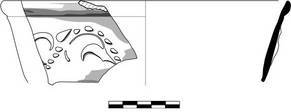
241. Pontic Sigillata Cup with Thorn Decoration
Th. .0037.
K17.0140:1. SC09-3b. Single rim sherd. Slip thicker and darker under rim and in patches on exterior. Slip also extends over rim interior (indicated by gray on illustration). Three extant vertical applied "thorns".
K17.0140-1.jpg
242. Unclassified Sigillata Jug Base, Pontic? (Early Roman)
K17.0777:39. P.H. 2.1, D. base .041, min. th. wall .003. Single base sherd. Fine light red (10R 6/8) fabric with almost no inclusions except occasional lime in voids. Most of the extant surface is coated and nicely smoothed. There is a trace of slightly more orange slip just below the break. This piece has all the markers of a well made piece of pottery: smoothed, sharp edges, well fired, few inclusions, etc. It isn’t ARS as the fabric is too compact.
K17.0777-39.jpg
243. “Brown Slip” Sigillata Plate Base (Early Roman)
P. H. .021. Est. diam. base .08 (<1/10 preserved). Th. .004.
K/L16/17.0427:25. Single sherd, ring foot. Fine brown (5YR 6/6 and slightly redder) fabric with rounded white (lime?) and smaller angular inclusions. Extant interior floor is slipped and varies in color from red to very dark reddish brown (10R 5/8 to 3/3). The slip is thickly applied but not very well smoothed with small bumps remaining under the slip. There are two interior concentric bands of rouletting just inside and outside the circumference of the base.
svg/K-L16-17.0427-25.jpg
244. “Brown Slip” Sigillata Deep Bowl
P. H. .062. Est. diam. rim .31 (<1/3 preserved). Th. .0089.
K/L16/17.0118:1. Single rim sherd with body to below widest part, outer rim is chipped. Compact, hard brownish-red (2.5YR 6/8, lighter towards exterior) fabric with frequent angular white inclusions and some darker. The interior is coated with thick brown (2.5YR 5/8 below carination, darker above) slip, narrow smoothing bands on the interior. Exterior is ridged below the carination so that the dark brown (2.5YR 4/3) slip is absent from wear at each ridge’s peak.
svg/K-L16-17.0118-1.jpg
245. “Brown Slip” Sigillata Bowl (Early Roman)
P. H. .087. Est. diam. rim .41 (1/10 preserved). Th. .0084.
K17.0860:3. Single large rim sherd. Light brown fabric (5YR 6/6) is compact with occasional rounded white inclusions (.004 in size) and other angular bits of similar size; there are also tiny bits visible at 10x. Thick brown slip (just lighter than 5YR 4/6) on all surfaces. Surfaces are brushed and darker where slip is thickest. As usual for the ware, there are “flattened bumps” under the interior slip, which is darkest over bumps. Two grooves on exterior wall.
246. “Brown Slip” Sigillata Deep Bowl (Early Roman)
P. H. .04. Th. .008.
K/L16/17.0474:11. Single body fragment of carinated basin. Slightly coarse brown (2.5YR 6/8) fabric with small light inclusions. Interior slip is brown (10R 4/3) where thickest but the ridges and bumps typical of this ware generally show through the slip. The thin slip on the exterior is light orange (2.5YR 6/6) and also varies with the surface of the vessel. Interior is prominently ridged above carination, whereas the most prominent ridges on the exterior are below the carination.
nos. 46-48.
svg/K-L16-17.0474-11.jpg
247. “Brown Slip” Sigillata Deep Bowl
P. H. .0051. Th. .0089.
K/L16/17.0467:10. Single body sherd, carinated with ridges on lower section. Pink fabric (5YR 7/6), dark brown (5YR 3/2) slip varying in thickness and almost absent at peaks of ridges ridges. Bumps under slip as typical for ware.
svg/K-L16-17.0467-10.jpg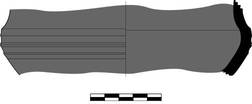
248. “Brown Slip” Sigillata Bowl (Early Roman)
P. H. .037. Est. diam. base .16 (<1/10 preserved). Th. .008.
K/L16/17.0434:2. Single base sherd. Compact, hard, well-fired light red (2.5YR 6/6) fabric with some varied tiny inclusions and occasional tiny voids. The interior surface has a “bumpy” reddish-brown slip (2.5YR 5/8 and darker) that shows the unevenness of the vessel surface. The plain exterior surface is fired to consistent light brown (7.5YR 7/6) and is quite well smoothed except for the occasional bit of excess clay or surface void. The groove and ridge that set the base off from the exterior wall are sharply defined.
svg/K-L16-17.0434-2.jpg
249. “Brown Slip” Sigillata Bowl, Recurved Handle
P. H. .051. Est. diam. rim .285 (1/20 preserved). Th. .0065.
K17.0860:42. Single rim sherd with handle. Light red (2.5YR 7/8) “regional type” fine fabric. Interior slip is unsmoothed so slightly ‘bumpy’. It is dark red-brown (5YR 3/3). The exterior is encrusted but possible a little lighter. There are ridges below the handle and the slip is distinctly thinner at the top of these.
K17.0860-42.jpg
250. Unclassified Late Hellenisti/Early Roman Red Slip Plate
P. H. .021. Est. diam. base .14 (<1/10 preserved). Th. .004.
K/L16/17.0120:19. Single base sherd with ring foot and part of sloping floor. Fine light brown (7.5YR 6/4) with very few tiny inclusions. The pattern of firing on the interior floor is distinctive,. A central area is dark red (near 10R 2.5/1). A thinner ring, presumably the trace of the base of the next vessel in the stack, is a lighter red (2.5YR 4/8), whereas the outermost preserved ring is an intermediate brown (2.5YR 4/4). None of these colors is very consistent with outermost band showing the most variability. The exterior is generally brown (2.5YR 4/4) but is lighter in patches where the slip is thinner. The underside of the ring foot is almost unslipped.
svg/K-L16-17.0120-19.jpg
251. Lesbian Sigillata(?) Portrait Bowl (later 1st Century BC to Augustan)
. P0639. Single sherd. Thin, fugitive slip on pinkish fabric. Portrait left.
Cf. , , p. 97-98, and .
252. Lesbian Sigillata(?) Bowl
H. .034. Est. diam. base .11. Th. .0039.
K17.0978:31. Single base sherd. Soft, fine pink (2.5YR 7/6) fabric with tiny angular light inclusions. Thin red (10R 5/8) matte slip on extant interior. Exterior plain. Ridge separates wall from floor on interior. Slight offset inside of this ridge. Groove separating base from floor on exterior.
K17.0978-31.jpg
253. Lesbian Sigillata(?) Bowl Rim
H. .027. Est. diam. rim .11 (1/10 preserved). Th. .005.
K/L16/17.0427:26. Single rim sherd. Fine pale red/light brown (5YR 7/6 and redder) fabric with frequent tiny white inclusions. The now worn, thin and red (10R 5/8) slip is very thinly, but evenly, applied to all extant surfaces. Thickened, outturned rim, slight interior carination dividing wall and floor.
svg/K-L16-17.0427-26.jpg
254. Unclassified Sigillata Bowl, ESC L9 Imitation? (Early Roman)
P18.0058:1.
255. Unclassified Sigillata Bowl (Early Roman)
H. .02. Est. diam. base .08 (<1/10 preserved). Th. .004.
K/L16/17.0427:24. Single sherd. Compact, hard reddish-brown (2.5YR 6/8) fabric with tiny angular inclusions of varied lightness just visible to the naked eye. The red (10R 4/6) slip does not completely hide the slight smoothing ridges on the interior, but is otherwise thick in places. Surface is pocked but slip may not have been highly polished. The exterior is plain. Flaring, well-made ring foot. One band of circular rouletting on the interior floor.
svg/K-L16-17.0427-24.jpg
256. Unclassified Sigillata Bowl Base (Early Roman)
H. .028. Est. diam. base .06 (1/5 preserved).
K/L16/17.0427:22. Single base sherd. Fine pink (2.5YR 7/6) fabric with occasional tiny varied inclusions and one .001 bit of lime observed in extant part of vessel. Thick, smoothed red (near 10R 4/6) slip on interior, thinner application of same on exterior. Rouletting on interior floor. Flaring false-ring foot. Slight offset on exterior wall at base.
Cf. , nos. 1165 and 1342 on plate 56.
svg/K-L16-17.0427-22.jpg
257. Unclassified Sigillata Bowl Base (Early Roman)
H. .028. Est. diam. base .08 (1/10 preserved).
K/L16/17.0427:23. Two joining sherds preserve base and lower wall. Fine brown (5YR 6/6) fabric with occasional tiny darker inclusions. Thick, well-smoothed red (between 10R 5/8 and 4/8) slip on interior, thinner on exterior.
Cf. , nos. 1165 (but no rouletting).
svg/K-L16-17.0427-23.jpg
258. Unclassified Sigillata (near ESC) Flanged Bowl Rim
K/L16/17.0118:10. P.H. .029, , Th. .004. Fine red (2.5YR 6/6) fabric with occasional rounded light inclusions and rare voids. Slip is browner than usual (2.5YR 4/8) and on the interior is relatively shiny, as is true of the outer rim above the flange. Below the flange the slip is thinner and less carefully smoothed. There is a shallow groove and the meeting of the outer face of the rim and flange.
svg/K-L16-17.0118-10.jpg
259. Unclassified Sigillata (near ESC) Bowl Base
K/L16/17.0118:12. P.H. .016, D. bas. .037 (completely preserved), Th. .003. Single base sherd. Fine light brown (5YR 7/6) fabric with no visible inclusions but occasional large voids. Brownish-red (between 2.5YR 5/8 and 4/8) slip is thickly and smoothly applied to the interior. The exterior slip is thinner and less even with scratches visible on extant surfaces. Obviously related to ESC in form and appearance but distinguishable from the normally available productions on the basis of fabric and surface details.
svg/K-L16-17.0118-12.jpg
260. Unclassified Sigillata Bowl
K/L16/17.0132:6. PP.H. .024, est. D. bas. .056 (less than 1/2 preserved), Th. wall .035. Single base sherd. Fine, hard fired, pale brown (7.5YR 6/6) fabric with rare tiny white inclusions. Interior surface has a smooth red (2.5YR 5/6) slip on it. The extant exterior is most reserved but shows that the upper wall was slipped. In addition there is a single dot of unintentional slip near the base.
svg/K-L16-17.0132-6.jpg
261. Unclassified Sigillata Beaker(?) Fragment (Early Roman)
H. .042. Th. .004.
K/L16/17.0427:27. Single body fragment, stance and orientation uncertain. Fine Reddish-brown (2.5YR 6/8) fabric with infrequent, tiny, both light and dark, inclusions visible at 10x magnification. The extant surfaces are covered with a thick brown (10R 5/6) slip that retains some bands of fine brush marks but is otherwise smoothed. A band of rouletting is partially preserved below carination that separates the upper and lower walls.
Cf. , plate 60 for similar surface treatment in Assos "Lokale Ware".
svg/K-L16-17.0427-27.jpg
262. Unclassified Late Hellenistic/Early Roman Red Slip Bowl
P. H. .013. Est. diam. base .041 (completely preserved). Th. .003.
K/L16/17.0120:18. Single sherd with entire base and lower wall. Fine reddish brown (10R 6/8) somewhat micaceous fabric with occasional tiny light and other inclusions. Preserved interior surface entirely covered with dark red (10R 4/8) slip which is somewhat smoothed and distinct from fabric. Exterior is unevenly slipped with most of underside plain. Floor of vessel bears stamped decoration, four 10-leaf palmettes from somewhat crude stamp, surrounded by a single preserved band of fine rouletting.
svg/K-L16-17.0120-18.jpg
263. Unclassified Late Hellenistic/Early Roman Red Slip Conical Foot
K/L16/17.0169:18. Single sherd preserves complete base. P.H. .02, D. base .056. Compact light red (2.5YR 7/6) fabric with occasional small white inclusions. Some small mica, though not as much as ESBi. Thin, unevenly applied orange (10R 5/8 where thickest) slip. Distinctive features are the incised line which imitates/evokes the molded levels of an LHell/ER Pergamene Sigillata cup and the “spiral smoothing” of the underside of the foot.
svg/K-L16-17.0169-18.jpg
264. Unclassified Early Roman near Sigillata Bowl Base
K/L16/17.0461:22. P.H. .028, Est. d. bas. .056, 2/5 preserved, Th. .005. Single sherd of base and lower wall. Gray fabric (10Y 5/1) with frequent small white inclusions and gold mica visible on surface. Interior surface fired an uneven brown (5YR 4/3), exterior brown and red (2.5YR 6/6). There are smoothing marks on both the interior and exterior. It is the consistent application of slip that makes this "near-sigillata", but the dullness of the polish and the surface-visible mica that also keep it out of the full sigillata category.
svg/K-L16-17.0461-22.jpg
265. Unclassified Early Roman Sigillata-like Bowl/Cup Rim
P. H. .021. Est. diam. rim .12 (1/8 preserved). Th. .0027.
K/L16/17.0467:9. Single rim sherd with short outturned triangular rim, thin wall. Exterior shows uneven bands from irregular smoothing with flat instrument, as well as a deforming bulge; interior shows uneven smoothing marks. Hard and fine pink fabric (2.5YR 7/6) with occasional miniscule white inclusions. Exterior thinly slipped, ranging in color from brown (2.5YR 4/3) to orange (2.5YR 6/8) and holding a metallic sheen in places. Interior slipped and fired to a consistent bright orange (10R 5/8). AKA “Spalling Ware”.
svg/K-L16-17.0467-9.jpg
266. Unclassified Early Roman Sigillata-like Bowl/Cup Rim
P. H. .033. Est. diam. rim .11 (1/4 preserved). Th. .003.
K/L16/17.0474:4. Single sherd, out turned rim. Compact pink (2.5YR 6/6) fabric with occasional tiny white inclusions. Thin orange-red (10R 5/8 and lighter) interior slip is unevenly applied. Exterior slip is more uneven, bare in places, and, where present, ranges from dark brown (10R 3/2) to same as interior. Rim is a short everted triangle and body is slightly carinated. AKA “Spalling ware”
svg/K-L16-17.0474-4.jpg
267. Pergamine/Candarli Bowl Rim
P. H. .024. Est. diam. rim .09 (1/10 preserved). Th. .0025.
K/L16/17.0474:13. Single rim sherd. Fine light brown (2.5YR 6/6) fabric with occasional tiny white inclusions. Red (near 10R 4/8) slip on all surfaces. Exterior is smooth, interior shows brush marks. There is slight clumping of clay just under the rim, a side-effect of smoothing with a broad bladed instrument.
svg/K-L16-17.0474-13.jpg
268. Unclassified Early Roman Sigillata-like Bowl Rim
K/L16/17.0467:4. ~P.H. .049,D. rim not recoverable but probably between .20 and .30, th. .0062. Single rim sherd of bowl with thickened, slightly outturned rim. Compact brown fabric (2.5YR 5/8) with occasional small white inclusions. Exterior slipped and fired brown (2.5YR 4/3) with red patch near bottom of sherd. Interior fired orange (10R 5/8), brush marks are visible.
svg/K-L16-17.0467-4.jpg
269. Unclassified Early Roman Sigillata-like Plate Base
K/L16/17.0467:5. P.H. .019, D. ba. .059 (1/3 preserved), Th. floor .003. Single base sherd with stepped ring foot. Fine pink/red (2.5YR 7/8) fabric. Dark reddish brown (10r 4/4) slip on interior, very worn in places. Concentric circles incised on interior aligned with base.
svg/K-L16-17.0467-5.jpg
270. Unclassified Early Roman Sigillata Bowl/Cup Base
K/L16/17.0467:8. Not cataloged
271. Unclassified Early Roman Red-Slip Thin-wall Cup/Jug
P. H. .031. Est. diam. rim .12 (<1/10 preserved). Th. .003.
K/L16/17.0434:26. Single rim sherd. Light red (10R 6/6) fabric with very infrequent tiny inclusions. Thick red (near 10R 4/8) not highly polished slip that shows horizontal smoothing bands near the rim. Cf. Tekkok 2001, no. 42.
svg/K-L16-17.0434-26.jpg
272. Unclassified Early Roman Red-Slip Thin-wall Cup/Jug
P. H. .018. Est. diam. rim .085 (<1/20 preserved). Th. .0035.
K/L16/17.0456:4. Single rim sherd. Compact red (2.5YR 6/6) fabric with no discernible inclusions. Deep red (2.5YR 4/6) slip is thickly applied and has obvious stick smoothing marks. Cf. Tekkok 2001, no. 42.
svg/K-L16-17.0456-4.jpg
273. Unclassified Early Roman Red-Slip Thin-wall Cup/Jug
P. H. .02. Est. diam. rim .07 (1/20 preserved). Th. .035.
K/L16/17.0474:15. Single rim sherd. Soft compact pink (2.5YR 8/4) fabric with occasional tiny, light inclusions. The thin red (10R 5/8) slip is only partially preserved. Slight offset at junction of rim and wall.
svg/K-L16-17.0474-15.jpg
274. Unclassified Early Roman Sigillata Plate, Upturned Rim
K/L16/17.0148:1. P.H. .025, est. D. rim .27 (<1/10 preserved), Th. floor .007. Single rim sherd. The fine pale reddish-brown (5YR 7/6) fabric has numerous small voids but only occasional small rounded white inclusions. The slip is probably discolored from exposure to heat, it is currently near 10R 5/8 on the interior and darker with patches of gray on the exterior. The surfaces do, however, retain their original smoothness. A distinguishing feature of the form is the offset marking the interior floor from the rim.
svg/K-L16-17.0148-1.jpg
275. Knidian Relief Ware Jug
D20.0023:17. Slightly granular orange red fabric (2.5YR 5/6) with thick matte slip.
p. 331, B485, fig.61, type b., type b.
svg/D20.0023-17.jpg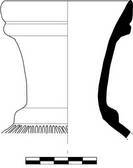
276. Knidian Relief Ware Jug
P. H. .043. Est. diam. rim .085. Th. .008.
D20.0068:4. Single sherd, 1/10 of shoulder. Fluted tongues on the shoulder ending with robe pattern. Pinkish/brown fabric with matt orange/red slip mottled into black.
p. 329, B484, fig.61; , pl.22a; type Ia; , Type A; Bailey 1979, Group (c).
svg/D20.0068-4.jpg
277. Knidian Relief Ware Jug with Silenus Face
P. H. .067. Th. .0025.
K/L16/17.0114.101. P0672. Single sherd. This fragment partially preserves the face of a bearded Silenus. The fine fabric is fired reddish brown (2.5YR 6/8) except where thickest in which case there is a faint gray (near Gley 2 – 10BG 6/1) core. There are occasional tiny light and dark inclusions and a single lime chunk, .001 across, is visible in the extant portion of the vessel. On the exterior is a white underslip over which a red slip is unevenly applied. At its darkest, in the wrinkle under the right cheek or in the moustache, the slip is near 2.5YR 5/8, elsewhere the slip ranges from bright orange to very pale as the white underslip shows through more distinctly. The interior is plain and shows the strokes by which the clay was pushed into the mold. The relief of this piece is relatively high with a maximum depth of .031 from the tip of the nose to the whiskers of the right part of the moustache. The mouth, nose and right cheek are present as well as the right side of the figure’s moustache. The right eye and the very top of the beard are only partially preserved. The line that defined the iris is extant at both points where it intersected the lower eyelid. No details of the left side beyond the mouth and part of the moustache are extant.
See P189 for similar complete cup.
278. Bowl with relief decoration, Regional
P. H. .032. Th. .008.
D20.0053:15. Single body sherd. Traces of a snake and linear decoration. Pinkish buff (5YR 6/6) limey fabric with fine silver mica.
279. Knidian Relief Ware Jug
D20.0017:37. Single sherd.
280. Roman Period Lead Glazed Skyphos (BC 50 - 10 AD)
Est. diam. rim .010 (1/5 preserved). Th. .0026.
z06.0017:38. SC09-3q. Brown glaze with relief decoration. Upper and lower handle stubs preserved at rim and on wall.
281. Roman Period Lead Glazed Skyphos (BC 50 - 10 AD)
P. H. .038. Est. diam. rim .085. Th. .0034.
K17.0860:2. Single rim sherd with beginning of horizontal handle at rim. Brownish green glaze (nearest 2.5Y 5/6). Light reddish brown (5YR 5/4) fabric. Angular lime inclusions, one as large as .004, otherwise small to tiny.
Cf. form 1.
K17.0860-2.jpg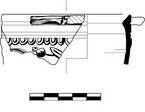
282. Thin wall cup/jug Base
P. H. .017. Est. diam. base .035 (completely preserved).
K/L16/17.0474:9. Slightly granular brown (2.5YR 5/8) fabric with occasional angular white inclusions. Surface unslipped, scratched.
svg/K-L16-17.0474-9.jpg
283. Imported Semi-slipped Thin-Wall Cup/Jug
P. H. .05. Est. diam. rim .07 (1/8 preserved). Th. .0027.
K/L16/17.0146:7. Single rim sherd with upper body and just a hint of one handle stub preserved. Fine light brown (5YR 6/6) fabric with frequent small lime and varied darker bits, occasional large silver mica flakes. The wash is thin, and dripping down the interior. Exterior slip color is red (10R 5/8).
svg/K-L16-17.0146-7.jpg
284. Dot-decorated Beaker (150 - 50 BC)
D09.2037:2. SC07-7j. Single body sherd. Dotted arcs on exterior surface.
Cf. Form I, Group A, plates; plates 1 and 55.
285. Thin Walled Cup Rim (late Republican to Augustan)
H17.0916:16. SC07-7h. Single rim sherd. Micaceous yellowish/buff fabric (7.5 YR 6/4-6/6). Very thin walls. Swelling rim.
Cf. form 4; nos. 36 and 37, illustrated on plates 4 and 57; also plate 100. no 3 (from the Ciacchi excavation House of Livia).
svg/H17.0916-16.jpg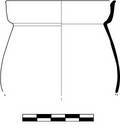
286. Thin Walled Beaker (1st Century AD)
M18.0478:1. P.H. .0513, est. D. rim .09 (<1/12 preserved), th. wall .0019. Grey (GLEY1 5/) core with angular quartz and rounded lime inclusions. Interior surface and lower outer surface are light red (around 2.5YR 5/8). Gray band below rim on exterior. Rim has distinct exterior groove making for a very delicate bead at lip.
M18.0478-1.jpg
287. Thin Walled Cup, "Thorn Ware" (Early 1st Century AD)
P. H. .029. Est. diam. rim .06 (1/5 preserved). Th. .0012.
M18.0478:2. Single rim sherd with upper body and handle stub. Cleanly fired red (2.5YR 5/6) fabric with relatively few tiny light inclusions. Applied barbotine decoration. Finely articulated rim. A small amount of excess clay over rim.
Cf. Form IV and VII, no. 84; plates 8 and 59; perhaps transitional to Tiberian form LI. Cf. no. 288.
M18.0478-2.jpg
288. "Thorn Ware" Thin Walled Cup Base (1st Century BC and Later)
H17.0896:1. Single base sherd. Added decoration starting at base.
First published as , no. 35.
H17.0896-1.jpg
289. Sanded Ware Cup Rim (1st Century AD)
P. H. .065. Est. diam. rim .095 (<1/20 preserved). Th. .003.
K/L16/17.0461:17. Single rim to lower body preserved. Bowl with high walls, rounded towards base. Fine pink (10R 7/6) fabric, very slightly lighter and finer than K/L16/17.0467:03 but both are probably from the same source. Red slip (near 10R 4/8) on interior and exterior. Sand particles unevenly spaced below slip.
svg/K-L16-17.0461-17.jpg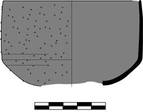
290. Sanded Ware Cup Handle (Early to Mid-first Century AD)
Z06.0007:33. SC09-3m. Single sherd with handle. Sand on lower extant exterior.
First published as , no. 29. Cf. Form XLII.
svg/z06.0007-33.jpg
291. Sanded Ware Bowl Rim (Mid-first Century AD?)
I17.0757:2. SC09-3j. Single rim sherd. Sand on exterior below reserved band.
See examples at B459 for similar form and sanding.
svg/I17.0757-2.jpg
292. Sanded Ware Cup (Mid-first Century AD)
K/L16/17.0467:3. Est. P.H. .023, est. D. ~.11 (1/6 preserved), th. 004. Single body fragment with inflection just preserved. Orange fabric (2.5 YR 6/6) with occasional white inclusions, red slip (10R 4/6) on interior and exterior. Sand particles unevenly spread over the exterior, under slip.
svg/K-L16-17.0467-3.jpg
293. Sanded Ware Cup Base (Mid-first Century AD)
K/L16/17.0434:22. P.H. .011, est. D. bas. ~~.005 (>1/5 preserved), Th. floor .015. Single base sherd. Pale brown (7.5YR 6/4) fabric with small angular and elongated yellow inclusions. The exterior has applied sand under a thin brown (7.5YR 4/3) slip. The interior slip is slightly darker (7.5YR 4/4) and smoothed.
svg/K-L16-17.0434-22.jpg
294. Unclassified/Regional Thin-wall Cup/Jug
P. H. .063. Est. diam. rim .07 (<1/20 preserved). Th. .0015.
K/L16/17.0120:10. Single sherd with rim and handle. Fine reddish brown (10R 5/8) fabric with occasional angular white inclusions. Surface weak red/gray (near 2.5YR 5/3). From a first century AD pit.
Near , nos. 50 and 51.
svg/K-L16-17.0120-10.jpg
295. Thin Walled Jug Rim and Handle (1st and 2nd century AD)
H. .046. Est. diam. rim .08. Th. .003.
C29.0039:1. Single fragment preserving complete handle, upper wall, and small part of rim. Light brown fabric.
First published as , no. 43; see page p. 319 for fabric description.
svg/C29.0039-1.jpg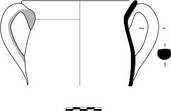
296. Thin Walled Jug Rim and Handle (1st and 2nd century AD)
D20.0093:8. SC07-8e. Single fragment preserving complete handle, upper wall, and broken rim.
For form see , form LXVIII, no. 431, pls. 46,85, form extends to late 2nd c. A.D. at Troia.
297. Unclassified Late Thin-Walled Cup/Jug
K17.0777:5. P.H. .017, D. base .025, min. th.wall .004. Single base sherd. Fabric is red (2.5 YR 6/8) with very thin more brown (5YR 6/3) core. Surface is plain with low ridges spiraling towards base. There is also a smear distorting the base. The base itself is indistinct from the wall. This feature and the relatively thick wall distinguish this piece from the better made NW Aegean thin-walled vessels of the third century, though by fabric it may be their successor.
K17.0777-5.jpg
298. Unclassified/Regional Thin-wall Cup Rim
K/L16/17.0427:8. P.H. .018, est. D. rim .09 (<1/10 preserved), Th. .002. Single rim sherd. Brown (10R 5/8) fabric with frequent white inclusions. Extant exterior fired gray, interior same as fabric.
svg/K-L16-17.0427-8.jpg
299. Unclassified Thin-wall Cup Rim and Handle, Gray on Orange
P. H. .075. Est. diam. rim .13 (1/8 preserved). Th. .0025.
K/L16/17.0434:10. Single sherd with rim and handle. Red (2.5YR 6/8) fabric with occasional sub-angular light and dark inclusions, as well as some tiny bits. Fired evenly except for thin gray core in thickest part of rim. Interior is same color as fabric. Exterior surfaces fired to reddish gray (near 2.5YR 5/2). Strap handle is .017 in width. Found in late 1st/early 2nd century AD fill.
svg/K-L16-17.0434-10.jpg
300. Unclassified Thin-wall Cup Rim and Handle
K/L16/17.0434:27. P.H. .056, est. D. rim GET (<1/20 preserved), Th. wall .002. Single sherd with rim and handle. The fine red (2.5YR 5/8) fabric has relatively few inclusions, all light, in the rim and handle so this may be from a less-well represented source. Surface of the handle is thin gray (around 2.5YR 5/3). Slight offset in transition from rim to wall. Rectangular handle is .01 in width.
svg/K-L16-17.0434-27.jpg
301. Phocaean(?) Thin-wall Cup Rim
K/L16/17.0434:31. P.H. .015, est. D. rim .11 (1/10 preserved), min. th. wall .0023. Single rim sherd. Fine light red (2.5YR 6/8) fabric with only occasional tiny inclusions, inclusing golden mica flakes. Surface plain. Distinct collar below flaring rim.
svg/K-L16-17.0434-31.jpg
302. Unclassified/Regional Thin-wall Cup/Jug Rim, Gray Band on Red
P. H. .024. Est. diam. rim .08 (1/10 preserved). Th. .0015.
K/L16/17.0461:29. Single rim sherd with handle stump and upper wall. Outturned rim with single ridge on exterior face. Slightly gritty, brown fabric (2.5YR 5/8) with frequent tiny white inclusions. Core of handle is gray. Exterior surface gray, interior same as fabric.
svg/K-L16-17.0461-29.jpg
303. Regional Thin-wall Cup/Jug Rim
P. H. .035. Est. diam. rim .08 (1/5 preserved). Th. .002.
K/L16/17.0114:38. Single rim sherd with handle stump preserved. Orange red (2.5YR 6/8) fabric with angular light inclusions. Exterior gray, interior plain.
svg/K-L16-17.0114-38.jpg
304. Regional Thin-wall Cup/Jug Rim
K/L16/17.0144:12. P.H. .021, est. D. rim 10 (1/7 preserved), Th. wall .002. Single rim sherd. Red (2.5YR 6/8) fabric with tiny light inclusions, exterior surface gray.
svg/K-L16-17.0144-12.jpg
305. Regional Thin-wall Cup/Jug Rim
P. H. .017. Est. diam. rim .08 (1/6 preserved). Th. .005.
K/L16/17.0112:14. Single rim sherd. Red (2.5YR 6/8) fabric, white inclusions, outer surface gray Collar under rim.
svg/K-L16-17.0112-14.jpg
306. Regional Thin-wall Cup/Jug Rim
K/L16/17.0132:8. P.H. .036, est. D. .09 (less than 1/7 preserved), Th. wall .002. Single rim sherd. Red (2.5YR 6/8) fabric with small light inclusions, exterior surface gray (near 2.5YR 5/2), interior surface plain.
svg/K-L16-17.0132-8.jpg
307. Thracian(?) Thin Walled Jug/Cup Rim (3rd century AD)
P. H. .044. Est. diam. rim .07 (1/4 preserved). Th. .0015.
K17.0777:17. Rim sherd and one joining body fragment, modern break. Fine red (2.5YR 5/6) fabric with occasional lime chunks visible on surfaces. The exterior surface is fired weak red (2.5YR 5/2), the interior is plain. The exterior partially preserves two readable letters written in thin white paint: πε. A third, at the right, is extant only as a partially preserved vertical stroke. The neck has only a slight offset above the turn from wall to rim.
Cf. no. 19, for painted cup dated to 3rd century; this piece is said to be Italian on the basis of fabric. A complete vessel of this type is illustrated at , p. 71.
svg/K17.0777-17.jpg
308. Thracian(?) Thin Walled Jug/Cup Rim (3rd century AD)
P. H. .038. Est. diam. rim .066 (1/3 preserved). Th. .0015.
K17.0777:18. Single rim sherd. Unevenly fired fabric with red (2.5YR 5/6) core and frequent small light inclusions and occasional large chunks of lime, one of which would have been visible on both interior and interior but is now dislodged. Coated interior and exterior surfaces are fired weak red (2.5YR 5/3). The normal offset above the turn from wall to rim is here a low band just at the base of the neck. A single row of partially preserved crossing brushstrokes formed part of a encircling band of hatching.
Cf. no. 19, for painted cup with diamond pattern dated to 3rd century; this piece is said to be Italian on the basis of fabric. A complete vessel of this type is illustrated at , p. 71. Similar decoration on LRB 11a, which is said to be Attic.
svg/K17.0777-18.jpg
309. Thracian(?) Thin Walled Jug/Cup Rim (3rd century AD)
D20.0093:9. Single rim sherd. Unevenly fired fabric with red (2.5YR 5/6) core and frequent small light inclusions and occasional large chunks of lime, one of which would have been visible on both interior and interior but is now dislodged. Coated interior and exterior surfaces are fired weak red (2.5YR 5/3). Slight offset between rim and body. Two spirals or sets of concentric circles in thin white paint are partially preserved; horizontal line above.
310. Unclassified/Regional Thin-wall Cup/Jug Base
P. H. .029. Est. diam. base .036 (complete preserved). Th. .0025.
K/L16/17.0417:11. Single sherd with complete base. The fine fabric is unevenly fired to brown (2.5YR 5/6 and browner) with frequent small white inclusions and occasional mica on surface. The surface near the base is dirty brown (2.5YR 5/4) with the beginnings of a “gray zone” starting at .018 above the bottom of the vessel. This part is fired very weak red-brown (2.5YR 5/2). A band of .0045 high white dots, of which 7 are at least partially preserved, separates the lower lighter colored area from the higher, darker one.
Dotted decoration is well-known on thin-walled vessels. Cf. fig. 4.7m and plate 40j. Cf. FiE VIII/6 K749
svg/K-L16-17.0417-11.jpg
311. Thin Walled Jug Rim and Handle (3rd Century AD?)
P. H. .056. Est. diam. rim .08 (<1/10 preserved). Th. 0.25.
K17.0867:1. Single sherd with rim and handle. Light brown (5YR 5/6), soft, slightly granular fabric with rounded lime and other dark inclusions, as well as gold mica flakes in the fabric and on the surface. The surface is otherwise plain. Very distinct from the standard regional fabric.
K17.0867-1.jpg
312. Unclassified Thin-Wall Cup/Jug
K/L16/17.0398. P0640. String marks under the base. Lines on surface. Dark orange fabric between 5 yr 4/4 and 5/4. Gold and silver mica, with occasional black stones less than 0.005m and lumps of clay.
svg/P0640.jpg
313. Unclassified Thin-wall Cup/Jug Base, "Orange over Gray Core"
P. H. .017. Est. diam. base .04 (1/3 preserved). Th. .004.
K/L16/17.0120:9. Gray core (2.5Y 3/1); very thin, orange (2.5YR 5/8) surface. Hard, compact fabric. Frequent small white inclusions occurring more often than in regional examples. Scratches on exterior surface. This is near the variant with the “thin orange layer on gray core”.
svg/K-L16-17.0120-9.jpg
314. Unclassified Thin-wall Cup/Jug, Orange over Gray Core
K/L16/17.0434:5. P.H. .014, est. D. bas. .036 (1/2 preserved), Th. .002. Single base sherd. Hard gray (Gley 1 – N 3/) fabric with frequent tiny light inclusions visible against the dark background. The unsmoothed interior and smoothed exterior surfaces are fired reddish-brown (2.5YR 5/6).
svg/K-L16-17.0434-5.jpg
315. Unclassified Thin-wall Cup/Jug Base, Imported Gray over Orange
P. H. .016. Est. diam. base .036 (complete preserved). Th. .0015.
K/L16/17.0427:28. Single base sherd. Compact and hard, brown (2.5YR 6/8) fabric with tiny light inclusions just visible to the eye. Interior surface plain. Extant exterior surface fired dark gray (Gley 1 – N 3/), a distinguishing feature of the piece is that this gray layer is extremely thin (essentially unmeasurable). There is a distinct swirl at the base of the interior. This vessel is distinct from the usual ER banded "gray-band-on-red" thin-walled cups.
svg/K-L16-17.0427-28.jpg
316. Unclassified/Regional Thin-wall Cup/Jug Base
P. H. .013. Est. diam. base .036 (nearly complete preserved). Th. .0025.
K/L16/17.0427:41. Single base sherd. Light red (2.5YR 6/8) fabric with predominantly light angular inclusions and occasional dark bits. Surface is thinly coated/self-slipped. No gray zone preserved. The construction of the base is sloppy, with an application of a smoothing tool having created an uneven offset between base and wall.
svg/K-L16-17.0427-41.jpg
317. Unclassified/Regional Thin-wall Cup/Jug Base
P. H. .023. Est. diam. base .05 (1/8 preserved). Th. .0024.
K/L16/17.0427:42. Single base sherd. Dark-red/brown (2.5 4/8) fabric with frequent light angular inclusions. Surface plain (discolored black near base). Smoothing scratches and careless stick marks on exterior surface.
svg/K-L16-17.0427-42.jpg
318. Unclassified/Regional Thin-wall Cup/Jug Base, Gray Band on Red
P. H. .005. Est. diam. base .05 (1/3 preserved). Th. .0021.
K/L16/17.0427:43. Single base sherd. Brown (10R 5/8) fabric with frequent white inclusions. Surfaces plain but with darker red (10R 5/4) upper band.
svg/K-L16-17.0427-43.jpg
319. Unclassified Thin-wall Cup/Jug
K/L16/17.0434:6. P.H. .016, est. D. bas 03 (1/5 preserved), Th. wall .002. Single base sherd. Red (2.5YR 6/8) fabric with tiny light angular inclusions and occasional elongated quartz. “Gray zone begins .009 above bottom of vessel.
svg/K-L16-17.0434-6.jpg
320. Unclassified Thin-wall Cup/Jug
K/L16/17.0434:7. P.H. .014, est. D. bas. .037 (1/2 preserved), Th. wall .002. Single base sherd. Gray core, 2.5YR 5/8 towards surfaces. Surface is red (2.5 YR 5/8). Few inclusions, all tiny.
svg/K-L16-17.0434-7.jpg
321. Unclassified Thin-wall Cup/Jug
P. H. .022. Est. diam. base .036 (completely preserved). Th. .002.
K/L16/17.0434:8. Single base sherd. The dark gray (7.5YR 4/1) fabric has frequent tiny white inclusions and occasional larger angular ones up to .001 in length. The exterior surface is fired dull red (10R 5/4) whereas the interior is brighter (10R 5/6). A gray zone begins .015 from the bottom of the vessel. While not overly distinct from the Regional Gray on Red variety of this form, this vessel is sufficiently different to warrant the caution of leaving it unclassified.
svg/K-L16-17.0434-8.jpg
322. Unclassified Thin-wall Cup/Jug
K/L16/17.0434:9. P.H. .023, est. D. bas. .05 (1/10 preserved), Th. .003. Single base sherd. Dark brown (2.5YR 4/8) fabric with relatively few tiny white inclusions. Exterior surface is coated and dull red (10R 5/6) with some scratches on extant part. Interior is plain with relatively pronounced smoothing spiral.
svg/K-L16-17.0434-9.jpg
323. Unclassified Thin-wall Cup/Jug, Orange with Plain Surfaces
P. H. .008. Est. diam. base .036 (completely preserved). Th. .0014.
K/L16/17.0434:19. Single base sherd. Compact, hard cleanly-fired red (2.5YR 5/8) fabric with no visible inclusions. Surfaces plain, some scratches on interior. Exterior base is sharply defined from floor. Broad smoothing spiral on interior base, some scratches on exterior. Distinct from regional products by construction of base and extreme thinness.
svg/K-L16-17.0434-19.jpg
324. Unclassified Thin-wall Cup/Jug
K/L16/17.0434:29. P.H. .023, est. D. bas. .05 (1/10 preserved), Th. .003. Single base sherd. Dark brown (2.5YR 4/8) fabric with relatively few tiny white inclusions. Exterior surface is coated and dull red (10R 5/6) with some scratches on extant part. Interior is plain with relatively pronounced smoothing spiral.
svg/K-L16-17.0434-29.jpg
325. Phocaean(?) Thin-wall Cup/Jug
K/L16/17.0434:30. P.H. .002, est. D. base .03 (1/3 preserved), min. th. wall .0023. Single base sherd. Fine red (2.5YR 6/8) fabric with tiny light and dark angular inclusions and some small voids, occasional golden mica flattened on plain, scratched surface.
svg/K-L16-17.0434-30.jpg
326. Unclassified/Regional Thin-wall Cup/Jug Rim, Gray-on-Orange
P. H. .029. Est. diam. base .08 (2/3 preserved). Th. .0028.
K/L16/17.0461:10. Single base sherd with rounded lower wall. Slightly gritty, hard reddish brown (2.5YR 5/6) fabric with frequent angular white and darker inclusions, golden mica visible on surface. Unslipped. Surface shows distinct smoothing bands and scratches.
svg/K-L16-17.0461-10.jpg
327. Unclassified/Regional Thin-wall Cup/Jug Base, Gray-on-Orange
P. H. .022. Est. diam. base .06 (1/4 preserved). Th. .004.
K/L16/17.0461:12. Single sherd of base and lower wall. Slightly gritty, hard fabric fired gray at core, brown (2.5YR 5/6) at surface, frequent angular white bits, golden mica visible on surface. Surface plain. Similar fabric and surface to K/L17/0461:10.
svg/K-L16-17.0461-12.jpg
328. Unclassified/Regional Thin-wall Cup/Jug Base, Gray-on-Orange
P. H. .046. Est. diam. base .058 (1/5 preserved). Th. .0014.
K/L16/17.0461:28. Single sherd preserving wall to upper body. Base is sharply defined. Compact reddish brown fabric (10R 5/8) with tiny white inclusions, very little mica. Lower part of body is indistinguishable from fabric, upper part fired gray. Exterior surface shows distinct smoothing bands and scratches.
svg/K-L16-17.0461-28.jpg
329. Unclassified/Regional Thin-wall Cup/Jug Base, Gray-on-Orange
K/L16/17.0114:35. P.H. .023, D. bas. .035 (completely preserved, not regular), Th. wall .003. Single base sherd with portion of lower wall. Orange red (2.5YR 6/6) fabric with frequent angular white inclusions. Scratches and voids on surface.
svg/K-L16-17.0114-35.jpg
330. Unclassified/Regional Thin-wall Cup/Jug Base, Gray-on-Orange
K/L16/17.0114:37. P.H. .023, est. D. bas. ~.037 (3/4 preserved), Th. wall .025. Single base sherd with part of lower wall. Red (2.5YR 6/8) fabric with white inclusions, some flattened on surface and highly reflective. Scrathches and voids on surface. No “gray zone” preserved.
svg/K-L16-17.0114-37.jpg
331. Unclassified/Regional Thin-wall Cup/Jug Base, Gray-on-Orange
K/L16/17.0114:39. P.H. .037, D. bas. ~.034 (completely preserved), Th. wall .003. Two joining base sherds with wall just past widest point. Orange red fabric (2.5YR 4/6) with few tiny inclusions. “Gray zone” begins .014 from bottom of vessel. Base is near circular but slightly irregular.
svg/K-L16-17.0114-39.jpg
332. Unclassified/Regional Thin-wall Cup/Jug Base, Gray-on-Orange
K/L16/17.0114:34. P.H. .015, est. D. bas. ~.045 (1/3 preserved). Th. .003. Single base sherd with part of lower wall. Orange red (2.5YR 6/8) fabric with white inclusions. “Gray zone”begins .007 above bottom of vessel.
svg/K-L16-17.0114-34.jpg
333. Unclassified Thin-wall Cup/Jug Base
K/L16/17.0118:7. P.H. .009, est. D. bas. ~.05 (1/4 preserved), Th. wall .0025. Single base sherd. Fine dark red (2.5YR 5/6) fabric with frequent small angular white inclusions. There is occasional surface silver mica. The fabric color is slightly darker than normal for the clearly regional products. Surface near base is plain. A “gray zone” begins .0095 above bottom of vessel. The distinction between the lower red and upper gray is relatively sharp on this piece. Addtionally, the exterior surface is smoothed and does not show the usual scratches.
svg/K-L16-17.0118-7.jpg
334. Unclassified Thin-wall Cup/Jug Base
K/L16/17.0118:8. P.H. .019, est. D. .04 (1/2 preserved), Th. .002. Single base sherd. Fine red (2.5YR 4/8) fabric with slight gray core at turn of wall into base where sherd is thickest. The usual small white angular inclusions are present. There is no “gray zone” but the exterior surface is scratched with voids. The base is less distinct than in other pieces and there is a slight offset/ridge on its underside.
svg/K-L16-17.0118-8.jpg
335. Unclassified Thin-wall Cup/Jug Base
K/L16/17.0118:9. P.H. .011, est. D. bas .055 (1/4 preserved), Th. .002. Single base sherd. Fine red (2.5YR 5/8) fabric with the usual white, angular inclusions. No gray zone but exterior surface is scratched. Well defined base.
svg/K-L16-17.0118-9.jpg
336. Unclassified Thin-wall Cup/Jug Base
K/L16/17.0118:11. P.H. .02, est. D. base .03 (1/4 preserved), Th. .002. Single base sherd. Fine red (2.5YR 5/8) fabric with usual white angular inclusions. No gray zone but exterior surface is scratched.
svg/K-L16-17.0118-11.jpg
337. Unclassified Thin-wall Cup/Jug Base
K/L16/17.0148:5. Single base sherd. P.H. .019, est. D. base .04 (1/3 preserved), th. .0027. The fabric is very near in color (2.5YR 5/8) and inclusions (angular white bits) to the regional products. The interior surface is plain. But the exterior surface is fired dull red (2.5YR 5/4). It has scratches. Also, the base is relatively indistinct from the wall.
svg/K-L16-17.0148-5.jpg
338. Unclassified Thin-wall Cup/Jug Base, Gray-on-Orange
K/L16/17.0148:6. P.H. .012., est. D. bas. .035 (3/5 preserved), Th. wall .015. Single base sherd. The fine red (2.5YR 5/8) fabric has few tiny white inclusions. The coated surface is dull reddish-brown (2.5YR 5/4) and relatively smoothed. The surface color, few inclusions, and lack of scratches are what most clearly distinguish this vessel from the normal ‘Regional Gray on Red Thin Wall Ware’.
svg/K-L16-17.0114-34.jpg
339. Unclassified Thin-wall Cup/Jug Base, Gray-on-Orange
K/L16/17.0112:9. P.H. .017, est. D. base .032 (1/2 preserved), th. wall .004. Single base sherd. The fabric is standard red (2.5YR 6/8) with small white inclusions. No gray zone. The distinct foot is unusual and the wall is thick for the base diameter. Scratches on plain exterior surface.
svg/K-L16-17.0112-9.jpg
340. Unclassified Thin-wall Cup/Jug Base, Gray-on-Orange
P. H. .035. Est. diam. base .04 (2/5 preserved). Th. .002.
K/L16/17.0112:5. Single base sherd. The slightly granular red (10R 5/8) fabric has been discolored towards the interior surface and is now dark brown. The exterior is heavily encrusted but seems to be the normal gray on top of red combination. The gray zone is .018 above the bottom of the vessel. Five small iron “chunks” stuck on interior surface.
svg/K-L16-17.0112-5.jpg
341. Unclassified/Regional Thin-wall Cup/Jug Base, Gray-on-Orange
P. H. .041. Est. diam. base .039 (complete preserved). Th. .002.
K/L16/17.0417:12. Two joining sherds preserve complete base. Compact red (2.5 YR 6/8) fabric with tiny white inclusions. The “gray zone” begins .014 above bottom of vessel.
svg/K-L16-17.0417-12.jpg
342. Jug Base (Late Roman?)
P. H. .052. Est. diam. base .0332 (completely preserved preserved). Th. .0018.
M18.0478:3. Single sherd, base and wall to widest diameter. Evenly fired light red (2.5YR 6/8) fabric with occasional lime chunks (some on visible on surfaces) and only tiny light and dark inclusions best visible at 10X magnification in addition to the chunks. Exterior surface is coated light reddish brown (around 2.5YR 6/4) with distinct spiral tooled before coating. Interior is plain.
M18.0478-3.jpg
343. Uncataloged African Red-Slip Fragment, Hayes 50?
K/L16/17.0112:8.
344. Uncataloged African Red-Slip Fragment, Hayes 67 or Other Thicker Plate?
K/L16/17.0112:15.
345. African Red-Slip Hayes Form 45a Rim (230-320)
Est. diam. rim .32 (1/20 preserved). Th. .0028.
K/L16/17.0084:1. Single, rim sherd. Compact, hard, well-fired light-red (near 2.5YR 6/6) fabric with only tiny inclusions. Thick bright reddish-orange (just redder than 2.5YR 5/8) slip on all surfaces. Single row of rouletting extant on upper surface of rim, with single incision just inside of outer edge. [[drawing sheet needs to be scanned and traced]]
For form see p. 62.
346. African Red-Slip Hayes Form 45a Rim (230-320)
Est. diam. rim near .30 (<1/20 preserved). Th. .004.
K/L16/17.0417:8. Single, small rim sherd. Compact, hard, well-fired light-red (near 2.5YR 6/6) fabric with only tiny inclusions. Thick bright reddish-orange (just redder than 2.5YR 5/8) slip on all surfaces. Single row of rouletting extant on upper surface of rim, with single incision just inside of outer edge. Body sherd K/L16-17.0417:9 is identical in details of fabric and surface treatment.
For form see p. 62.
svg/K-L16-17.0417-8.jpg
347. Uncataloged African Red-Slip Hayes Form 45a Rim (230-320)
K17.0777. Small sherd.
For form see p. 62.
348. African Red-Slip Hayes Form 45a Base (230-320)
P. H. .007. Est. diam. base .11 (<1/20 preserved). Th. .003.
K/L16/17.0417:5. Small base sherd. Slightly granular fabric, sherd discolored by burning. A band of rouletting is partially preserved on the interior just inside the circumference of the base.
For form see p. 62.
svg/K-L16-17.0417-5.jpg
349. African Red-Slip Hayes Form 45a Base (230-320)
P. H. .008. Est. diam. base .11 (<1/10 preserved). Th. .0035.
K/L16/17.0417:6. Small base sherd. Slightly granular fabric. Thick slip on all extant surfaces.
For form see p. 62.
svg/K-L16-17.0417-6.jpg
350. African Red-Slip Hayes Form 45a Base (230-320)
P. H. .0075. Est. diam. base .10 (1/8 preserved). Th. .0025.
K17.0777:10. Single base sherd. Slightly granular reddish-brown (2.5YR 5/8) fabric with tiny lime inclusions. The unpolished orange slip on all surfaces is very near in color to fabric.
For form see p. 62.
K17.0777-10.jpg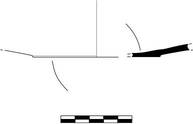
351. African Red-Slip Hayes 50a Rim (AD 230-320)
Th. .004.
K/L16/17.0100:17. Single rim sherd. Red (10R 5/8) fabric with no visible inclusions. Slip slightly redder than fabric. This sherd was recovered in third century pits and represents the first phase of ARS imports at Ilion.
For form see p. 69.
svg/K-L16-17.0100-17.jpg
352. African Red-Slip Hayes 50a Rim (AD 230-320)
Th. .004.
I17.0647:2. Single small rim sherd. P.H. ~.03, Th. .003. Fine reddish-brown (10R 5/8) fabric with no visible inclusions. Surface is very polished and only slightly darker than the fabric.
I17.0647-2.jpg
353. African Red-Slip Hayes 50 Type Base (AD 230-320)
P. H. .045. Th. .0025.
K17.0845:7. Single sherd with initiation of vestigial base. Compact orange (near 10R 6/8) fabric with occasional small, light inclusions. Slip is slightly darker on interior.
svg/K17.0845-7.jpg
354. African Red-Slip Hayes 50a late Profile (AD 300-360)
P. H. .047. Est. diam. rim .28 (1/20 preserved). Est. diam. base .185 (about 1/8 preserved). Th. .006.
D20.0183:15. Single sherd, profile. Pinkish red fabric with matte red slip, exterior thin slip.
355. African Red-Slip Hayes 53 Rim (AD 320-450)
P. H. .021. Est. diam. rim .19 (1/10 preserved). Th. .0025.
M18.0192:6. SC13-3h. Single rim sherd. Red (btw. 2.5YR 5/6 and 6/6) fabric is compact with essentially no inclusions. The unpolished slip is very close in color to the fabric. Slip is distinctly thinner on the extant exterior. There are three closely spaced interior grooves.
For discussion of this form see . See also p. 78.
M18.0192-6.jpg
356. African Red-Slip Hayes 53 Rim (AD 320-450)
P. H. .021. Est. diam. rim .19 (1/10 preserved). Th. .004.
M18.0238:1. SC13-3e. Single sherd. Slightly flaring rim. Fine, red fabric (10R 6/8) with only very occasional small light chunks. Slip only slightly darker than fabric. The interior slip is lightly brushed with some brush marks still showing. The exterior is mostly unslipped but for the drip marks, exterior shows brush marks. Two interior grooves.
For form see p. 78.
M18.0238-1.jpg
357. African Red-Slip Hayes 53 Rim (AD 320-450)
P. H. .022. Est. diam. rim .20 (1/20 preserved). Th. .0025.
I17.0647:3. Single rim sherd. Reddish-brown fabric (near 2.5YR 5/8) with occasional tiny lime inclusions. Surface is slightly lighter than fabric. Brushed on interior, near plain on exterior. There are two closely spaced grooves on the interior.
I17.0647-3.jpg
358. African Red-Slip Hayes 53b Wall Fragment (AD 370-430)
Th. .0043.
M18.0099:3. P.H. .027, est. D. rim .20 (<1/24 preserved), th. .004. Single rim sherd. Somewhat granular red (near 10R 5/8) fabric with varied tiny bits, mostly light. Slip is slightly darker. Two incised lines on interior.
M18.0099-3.jpg
359. African Red-Slip Hayes 53 Wall Fragment (AD 320-450)
Th. .0043.
M18.0267:6. SC13-3gg. Single sherd. Circle of rouletting around central floor partially extant on interior.
For form see p. 78.
360. African Red-Slip Hayes 53 Rim (AD 230/40 - 300)
P. H. .052. Est. diam. rim .34 (1/10 preserved). Th. .006.
D20.0183:5. Single sherd. Circle of rouletting around central floor partially extant on interior.
For form see p. 78.
361. African Red-Slip Hayes 58 Rim (AD 290-375)
P. H. .042. Est. diam. rim .34 (1/4 preserved). Th. .0052.
K17.0752:1. P0537. Five joining sherds preserving profile past vestigal foot. Orange-red (near 10R 6/8), visibly granular fabric with occasional angular, light inclusions. All extant surfaces slipped and fired slightly darker. Very lightly smoothed. Two light grooves on upper rim.
svg/K17.0752-1.jpg
362. African Red-Slip Hayes 59 Rim (AD 320-420)
P. H. .0026. Est. diam. rim .25 (1/24 preserved). Th. .005.
M18.0099:6. Single rim sherd. Orange-red (near 10R 6/8) visibly granular fabric with angular light inclusions. All extant surfaces slipped and fired slightly darker.
For form see p. 96.
svg/M18.0099-6.jpg
363. African Red-Slip Hayes Form 60 Rim (4th Century AD)
P. H. .032. Est. diam. rim .35. Th. .007.
H17.0050:3. Single sherd with rim and part of floor. Compact fabric, thin smooth slip interior and partially on exterior.
For form see p. 100.Cf. no. 128.
H17.0050-3.jpg
364. African Red-Slip Hayes Form 61a Rim
Est. diam. rim .20 (1/12 preserved).
A29.0020:4. SC13-3o. Single rim sherd.
For form see p. 100.
svg/A29.0020-4.jpg
365. African Red-Slip Hayes 67 Rim (AD 360-470)
P. H. .028. Est. diam. rim .30 (1/10 preserved). Th. .0065.
K17.0816:1. Single rim sherd. Slightly granular orange (10R 6/8) fabric with frequent angular inclusions (light, reddish, and darker). Slightly darker slip. Single groove on upper rim.
For form see p. 112.
svg/K17.0816-1.jpg
366. African Red-Slip Hayes 67 Rim (AD 360-470)
P. H. .018. Est. diam. rim .19 (1/12 preserved). Th. .0039.
M18.0099:2. Single rim sherd. Visibly granular fabric with tiny white inclusions and some lime exploding on surfaces. Thick smoothed slip on interior, thin under rim, and plain onto lower wall. Shallow incised line just inside of upper rim.
For form see p. 112.
svg/M18.0099-2.jpg
367. African Red-Slip Hayes 68 Rim (after AD 425)
P. H. .037. Est. diam. rim near .30 (1/20 preserved). Th. .0039.
I17.0754:2. Single rim sherd. Fine reddish-brown (near 2.5YR 6/6) fabric with occasional sub-angular calcareous inclusions. The interior darker red (near 10R 5/6) slip shows narrow, .002, stick smoothing marks whereas the exterior is brushed and slightly rough. Upper faces of rim are distinctly separated. Light groove at outermost edge.
For form see p. 116.
svg/I17.0754-2.jpg
368. African Red-Slip Hayes form 71 Rim (AD 375-450)
P. H. .052. Est. diam. rim .20 (1/10 preserved). Th. .002.
M18.0099:1. Two joining rim sherds with upper wall. Compact red (2.5 YR 6/8) fabric with only occasional tiny light inclusions and very small voids. Slightly darker slip on interior and over rim. Drip marks on exterior.
M18.0099-1.jpg
369. African Red-Slip near Hayes 72/5 Rim (AD 400-450)
P. H. .01. Est. diam. rim .13 (1/10 preserved). Th. .004.
M18.0001:4. Single rim sherd. Slightly granular orange (2.5YR 5/8) fabric. Darker red (10 5/8) slip.
Cf. p. 120 and 124. Also near form 73, particularly forms B643 and B644.
M18.0001-4.jpg
370. African Red-Slip Hayes 74 Rim (AD 450 to 475)
P. H. .023. Est. diam. rim near .12 (1/4 preserved). Th. .004.
I17.0532:4. Single rim sherd. Bright reddish-brown (10R 6/8) fabric with occasional lime inclusions. Same color interior slip is thick and bright. The wall of the vessel is smoothed whereas the upper face of the rim shows overlapping stick smoothing marks. These continue to the outer face of the rim where they become the distinct ridges that are one indication of the form. The exterior is plain except for drip marks.
For form see p. 124.
I17.0532-4.jpg
371. African Red-Slip Hayes Form 87b Rim (Late 5th to Early 6th Century AD)
H. .063. Est. diam. rim .44.
P18.0093:1. Almost completely preserved plate, twenty-six joining sherds leave two gaps and missing sections at rim and base. There is some chipping of the interior surface, though in general the slip is very well preserved; patches of plaster adhere to the interior of one group of joining sherds, to exterior of another (see photographs). Vessel has been conserved.Broad sloping walls with thickened rim and short triangular foot. Slightly granular fabric, fired red throughout (btw. 2.5YR 6/8-5/8) with occasional lime inclusions and some reddish bits. Smooth slip on interior surface is slightly darker red (10R 5/8), drip marks over rim, exterior largely plain.From deposits associated with the aftermath of the early sixth century AD earthquake.
For form see p. 135.
svg/P18.0093-1.jpg
372. African Red-Slip Hayes 87b Rim (Late 5th to Early 6th Century AD)
P. H. .019. Est. diam. rim perhaps .35.
P18.0061:1. Single rim sherd. Slightly granular fabric, fired red (10R 5/8) with some lime. Smooth slip is slightly darker red (10R 5/6) on all extant surfaces.
373. African Red-Slip Hayes 87c Rim (Late 5th to 6th Century AD)
P. H. .0095. Est. diam. rim not recoverable.
K17.0068:34. SC13-3q. Single small sherd. Hooked profile under rim. Granular dark red fabric with bright orange slip.
For form see p. 135.
K17.0068-34.jpg
374. African Red-Slip Hayes 91d Rim (late 6th through 7th century AD)
P. H. .02. Est. diam. rim .15 (1/10 preserved). Th. .0045.
u14.0001:1. Slightly granular fabric with lime inclusions, orange (2.5YR 5/8). This is very late ARS. The thick polished orange (off munsell, too orange for 2.5YR) slip is now very worn. The flange is somewhat unusual, being sharply tooled underneath so that it has a round profile. The upper rim is also slightly everted.
For form see p. 140. The profile is similar to type 54 (= Hayes 91d), p. 179, which is dated to the seventh century.
svg/u14.0001-1.jpg
375. African Red-Slip Hayes 104c(?) Base (Sixth Century AD)
P. H. .014. Th. .0052.
P18.0001:1. Single sherd, low foot. Slightly granular fabric with lime inclusions, orange (2.5YR 5/8).
For form see p. 160 and fig. 30.23.
376. African Red-Slip Stamped Floor, Style A(ii) - (AD 350-420)
Th. .0063.
K17.0681:16. SC13-2u. Single sherd. Ring of palmettes, surrounded by groove.
Cf. fig. 38, nos g-i (types 3 and 4).
377. African Red-Slip Stamped Floor, Style A(ii) - (AD 350-420)
Th. .0063.
H17.0056:1. SC13-2q. Single sherd. Palmettes surrounded by concentric circles, with grooves between bands and outside of concentric circles.
Cf. fig. 38 for palmettes, fig. 40 j-l for concentric circles.
378. Phocaean Red-Slip Rim, Unclassified Flanged Bowl
Est. diam. rim .13.
P18.0061:3. Compact orange-red (2.5YR 6/8) fabric. Thin slip is somewhat darker red (10R 5/6 where thickest).
379. Phocaean Red-Slip Hayes Form 1a Rim (late 4th to early 5th century AD)
P. H. .029. Est. diam. rim .12. Th. .003.
I17.0647:4. Single sherd. Fine light red (2.5YR 6/6) fabric with occasional tiny lime inclusions and small elongated gaps. Worn surface is darker (10R 5/6) with thin slip. The slip is thinner and a touch darker above the carination.
Cf. , p. 325 and fig. 65.1-2.
I17.0647-4.jpg
380. Phocaean Red-Slip Hayes Form 1a Rim (late 4th to early 5th century AD)
P. H. .036. Est. diam. rim .16. Th. .004.
I17.0647:5. Single sherd. Light red (2.5YR 6/8) fabric with small lime inclusions, occasional darker bits. Surface is mostly lighter red (10R 5/6) but darker above the carination. Light scratches on lower exterior wall.
Cf. , p. 325 and fig. 65.1-2.
I17.0647-5.jpg
381. Phocaean Red-Slip Hayes Form 1 Rim (late 4th to early 5th century AD)
P. H. .037. Est. diam. rim .17. Th. .0035.
I17.0829:1. Single sherd. Fine light red (10R 6/6/) fabric with frequent small and tiny lime inclusions. There is a single extant chuck of lime, .0035 in diameter, exploding on the outer surface. Thin red and unsmoothed (10R 5/8) slip on all surfaces, except outer face of rim where darker (10R 4/2 to 5/3) from stacking. Slight carination on outer face.
Cf. , p. 325 and fig. 65.3.
I17.0829-1.jpg
382. Phocaean Red-Slip Hayes Form 1 Rim (late 4th to early 5th century AD)
P. H. .037. Est. diam. rim .21. Th. .0044.
M18.0099:15. Single sherd, broad rim with flat upper face. Red fabric with occasional sub-angular lime (.003), rare mica, and other tiny bits. Surface slip is fired to essentially the same color as fabric with only slight discoloration on outer rim from stacking.
Cf. , p. 325 and fig 65.
svg/M18.0099-15.jpg
383. Phocaean Red-Slip Hayes Form 1a Base (late 4th to early 5th century AD)
P. H. .028. Est. diam. base .05 (1/5 preserved). Th. .004.
I17.0647:6. Single base sherd. Fine light red (2.5YR 6/8) fabric with occasional tiny lime inclusions. Interior surface is worn away. Exterior is variable but mostly dull red (10R 5/6). Exterior has frequent scratches.
Cf. , p. 325 and fig. 65.1.
I17.0647-6.jpg
384. Phocaean Red-Slip Base, cf. Form 1
I17.0734:1. Single base sherd.
I17.0734-1.jpg
385. Phocaean Red-Slip Base, cf. Form 1
P. H. .035. Est. diam. base .11 (1/5 preserved). Th. .0045.
K17.0752:7. Single base sherd. Fabric is light red (2.5YR 6/8) without excessive lime. Matte surface is red (10R 5/8).
Cf. , p. 325 and fig. 65.2.
K17.0752-7.jpg
386. Phocaean Red-Slip Hayes 1d Profile (last quarter 5th century)
P. H. .0425. Est. diam. rim .17 (1/5 preserved). Th. .0052.
M18.0045:4. SC12-2a. Four joining sherds preserve wall profile. Dark band under rim from uneven stacking in kiln.
svg/M18.0045-4.jpg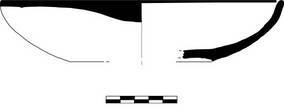
387. Phocaean Red Slip Ware Hayes Form 1d (400-425)
P. H. .032. Est. diam. rim .20 (1/20 preserved). Th. .006.
D20.0183:13. Single sherd. Pinkish buff with matte orange/red slip flaked off the surface.
388. Phocaean Red-Slip Hayes Form 2a Rim
P. H. .05. Est. diam. rim .30. Th. .005.
I17.0647:1. Fine light red (10R 6/8) fabric with very frequent lime inclusions up to .0025 in diameter but mostly smaller. Surface is mostly light red (10R 5/8) but darker near outer edge of rim and on lower face.
Cf. , p. 327 and fig 66.1.
svg/I17.0647-1.jpg
389. Phocaean Red-Slip Rim Hayes Form 2d (late 4th century AD)
P. H. .015. Est. diam. rim .20 (1/12 preserved). Th. .0047.
K17.0696:15. Single sherd. Frequent tiny lime inclusions. Orange red fabric (2.5YR 6/8). Thick matte slip (10R 6/8).
Near no. 1244, this variant, with flat rim, extends the typology in .
svg/K17.0696-15.jpg
390. Phocaean Red-Slip Rim, early Hayes Form 3 variant (Mid-5th Century AD)
P. H. .03. Est. diam. rim .26 (1/12 preserved). Th. .006.
K17.0736:8. Reddish-brown (2.5YR 6/8) fabric with frequent lime and some voids. Matte slip is generally darker (10R 5/8), particularly on outer face of rim. The underside of the rim is tooled flat.
Same rim form as no. 1254. Cf. p. 76 and plate 55.
K17.0736-8.jpg
391. Phocaean Red-Slip Rim, variant of Hayes form 3c
P. H. .037. Est. diam. rim .17 (1/8 preserved). Th. .0057.
M18.0099:4. Single rim sherd. Red (near 2.5YR 6/8) fabric with frequent tiny light bits and small elongated voids. Slip is redder (near 10R 6/8) with outer flange overfired in darker and near white patches. The tooling that created the flange left a groove between rim and wall on exterior.
Similar form, though with more flaring wall and rim, published at no. 221; see also , p. 82.
M18.0099-4.jpg
392. Phocaean Red-Slip Hayes 3b? (late Fifth century AD)
P. H. .047. Est. diam. rim .030 (1/8 preserved). Th. .003.
K17.0736:9. Single sherd, high rim flat on top with slight hook, thickened upper wall. Light red (2.5YR 6/8) compact fabric with frequent small lime inclusions. Surface is only slightly darker than fabric, outer face of rim ranges to dull red (2.5YR 6/4). Plain outer rim.
Near to no. 1262, but no rouletting on outer rim, which is more often the case on type c.
K17.0736-9.jpg
393. Phocaean Red-Slip Hayes Form 3c Rim
P. H. .033. Est. diam. rim .28 (1/8 preserved). Th. .003.
K18.0032:5. SC12-4c. Three joining rim sherds. Fabric pale red (2.5YR 6/8), occasional tiny lime inclusions. Thinly slipped, interior smoothed only in separated bands, other surfaces unsmoothed. Inner rim fired to pale red (2.5YR 6/8), outer rim very pale in part. Two light bands of rouletting on exterior rim, one each at top and bottom of rim.
svg/K18.0032-5.jpg
394. Phocaean Red-Slip Hayes Form 3c Rim
P. H. .039. Est. diam. rim .21 (1/20 preserved). Th. .003.
K18.0032:14. SC12-4s. Single rim sherd. Fabric fired to pale red (2.5YR 8/6) with some small lime inclusions and occasional larger chunks. Slip is only slightly darker than fabric, more so on outer rim. No rouletting. Two exterior grooves.
svg/K18.0032-14.jpg
395. Phocaean Red-Slip Hayes 3e Rim (AD 475-525)
P. H. .037. Est. diam. rim .21 (1/8 preserved). Th. .0026.
K18.0032:10. SC12-4e. Two joining rim sherds. Very frequent lime, 10R 6/8. Slip is 10R 5/8, not darker on outer face. No rouletting.
K18.0032-10.jpg
396. Phocaean Red-Slip Hayes 3e Rim
K18.0032:12. SC12-4p. Single rim sherd. Single sherd. Fabric red (10R 6/6), occasional lime. Inner rim (10R 5/6), outer face darker. Three bands of rouletting.
K18.0032-12.jpg
397. Phocaean Red-Slip Hayes 3f Rim (AD 500-550)
P. H. .020. Est. diam. rim .15 (1/12 preserved). Th. .005.
K18.0032:20. SC12-4kk. Single sherd. Fabric pale red (2.5YR 6/8) with some small lime inclusions. No rouletting on rim.
svg/K18.0032-20.jpg
398. Phocaean Red-Slip Hayes 3f Rim
P. H. .013. Est. diam. rim .11 (1/20 preserved). Th. .0027.
K18.0032:17. SC12-4aa. Single rim sherd. Fabric fired to pale red (10R 6/8), with some small lime inclusions. Slip slightly darker than fabric (10R 5/8), much darker on outer face. No rouletting, but there are ridges.
svg/K18.0032-17.jpg
399. Phocaean Red-Slip Small Hayes 3f Rim
P. H. .018. Est. diam. rim .12 (1/20 preserved). Th. .004.
D20.0053:17. Single rim sherd. Pinkish buff fabric with matte red slip.
400. Phocaean Red-Slip Hayes form 3f Rim
P. H. .019. Est. diam. rim .14 (1/20 preserved). Th. .0031.
K18.0032:30. SC12-4aa. Fabric pale red (2.5YR 6/8) with some small lime inclusions. Matte slip is same color as fabric except on outer face of rim where it is fired slightly darker. No rouletting on rim.
K18.0032-30.jpg
401. Phocaean Red Slip Ware Hayes Form 3f (525-550)
P. H. .022. Est. diam. rim .24 (1/20 preserved). Th. .006.
D20.0183:12. Pinkish red fabric with matte red slip.
402. Phocaean Red-Slip Hayes form 3 Rim (450-475)
P. H. .016. Est. diam. rim .12 (1/20 preserved). Th. .006.
D20.0056:10. Orangish buff fabric with orange slip.
403. Phocaean Red-Slip Hayes form 3 Base
P. H. .026. Est. diam. base .137 (1/3 preserved). Th. .005.
D20.0183:4. Four sherds, three joining, preserve base and lower wall. Pinkish buff fabric with fine orange/red slip. Stamp at center, Greek cross with double outline.
p. 367, 71f, fig.79. (Group II).
404. Phocaean Red-Slip Hayes form 5b Rim (1st Half Sixth Century AD)
P. H. .013. Est. diam. rim .25 (1/12 preserved). Th. .0084.
K18.0032:6. SC13-1a. Single sherd. Matte orange slip. Rouletting on ledge rim. Occasional lime chunks on surfaces.
, p. 339 and fig. 70.3.
svg/K18.0032-6.jpg
405. Phocaean Red-Slip Hayes form 6 Rim (Early 6th Century AD)
P. H. .021. Est. diam. rim .25 (1/12 preserved). Th. .0041.
K18.0032:27. The slightly granular red (2.5YR 6/8) fabric has lime inclusions, with two large lime chunks near surface The slip is quite thick and bright (slightly darker than 2.5YR 6/8). The outer face of the rim is darker.
, p. 341 and fig. 70.2.
K18.0032-27.jpg
406. Phocaean Red-Slip Hayes form 6 Rim (Early 6th Century AD)
P. H. .044. Est. diam. rim .25 (1/10 preserved). Th. .0035.
N18.0020:1. Single rim sherd. Fabric fired to light red (10R 6/6) with frequent calcareous inclusions. Surface coated on all surfaces, brushed smooth, and fired to just darker than fabric (10R 5/6). Elongated voids
, p. 341 and fig. 70.2.
N18.0020-1.jpg
407. Phocaean Red-Slip Hayes form 8 Rim (late 5th century AD)
C29.0001:1. SC13-3d. Single sherd. Light reddish brown (5YR 6/4) fabric with only occasional small lime bits. Interior surface is dull reddish brown (2.5YR5/4). Upper face of the rim is comparatively brown (5YR 5/3) and the exterior surface is darker (5YR 4/2). Two offset ridges on rim.
, p. 342 and fig. 70.1.
C29.0001-1.jpg
408. Phocaean Red-Slip Hayes form 8 Rim (late 5th century AD)
Est. diam. rim .14 (1/3 preserved). Th. .0028.
G27.0004:1. Single rim sherd, downturned rim with ridges. Fabric fired to red (2.5YR 6/8) with small light inclusions. Surface thinly slipped and brushed, same color as fabric.
, p. 342 and fig. 70.1.
svg/G27.0004-1.jpg
409. Phocaean Red-Slip Hayes form 8 Rim (late 5th century AD)
Est. diam. rim .14 (1/4 preserved). Th. .02.
O18.0014:1. Single rim sherd, rounded outer edge of downturned rim. Fabric fired to red (2.5YR 6/8) with occassional small light inclusions. Surface thinly slipped and brushed, fired to darker red (10R 5/6), darker under rim.
Cf. , p. 342 and fig. 70.
O18.0014-1.jpg
410. Phocaean Red Slip Ware Hayes Form 3/10a (6th Century AD)
H. .063. Est. diam. rim .30 (1/3 preserved). Th. .006.
D20.0061:1. Six sherds, in two joining groups of three each, nearly all of profile. Pinkish buff fabric with matte orange slip, fired cream around rim. The profile varies so that a slight offset under the rim is visible along a portion of the extant circumference.
Cf. , p. 343 and fig. 71.4.
svg/D20.0061-7.jpg
411. Phocaean Red-Slip Hayes form 10c Rim (7th century AD)
P. H. .02. Est. diam. rim .30 (1/20 preserved). Th. .0049.
G27.0001:1. Single rim sherd. Fabric fired to light red (2.5YR 6/6) with frequent calcareous inclusions. Surface coated on all surfaces, brushed smooth, and fired to just darker than fabric (towards 5/6). One large chunk of lime seen just under surface, now visible on surface.
Cf. , p. 343 and fig. 71.12.
G27.0001-1.jpg
412. Phocaean Red-Slip Stamped Floor (Fifth Century AD)
I17.0558:3. SC13-2t. Two joining sherds. Stamped figure in headdress (mitre?), concentric grooves.
Cf. Group II, p. 346.
413. Phocaean Red-Slip Stamped Floor (late Fifth AD to early 6th Century AD)
I17.0558:1. SC13-2n. Single sherd. Stamped cross at center of floor, flaring arms, 'rho' to right, pendents below arms.
Cf. motif 67 (p. 364) in Group III, fig. 78j for stamp. Flaring arms "tend to be early".
414. Late Roman Light-Colored Ware Rim
P. H. .029. Est. diam. rim .15 (1/8 preserved). Th. .0036.
A07.0158:1. SC13-4j. Very fine pale (7.5YR 8/3, towards 8/4) fabric with no inclusions individually discernible by eye and only tiny darker specs at 10x mag. Surface thinly slipped, brushed smoothed. Mostly fired to pale light brown (5YR 6/6) with darker patches under rim. Preserved rim has nine notches at outer edge.
svg/A07.0158-1.jpg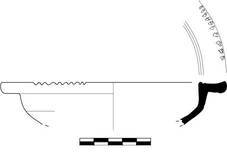
415. Late Roman Light-Colored Ware Rim
P. H. .021. Est. diam. rim .15 (1/8 preserved). Th. .0036.
K17.0736:1. SC13-4f. Very fine pale (7.5YR 8/3, towards 8/4) fabric with no inclusions individually discernible by eye and only tiny darker specs at 10x mag. Surface thinly slipped, brushed smoothed. Slip is light brown (5YR 6/6), though darker where thickest.
Near CF183.
K17.0736-1.jpg
416. Late Roman Light-Colored Ware Profile
Est. diam. rim .16 (1/2 preserved).
P18.0090:1. Five joining sherds. Compact pale brown (7.5YR 6/6) fabric. Thinly applied slip is predominantly red (2.5YR 6/6) with darker areas. Areas of the outer face of the rim have the "warm brown" tone characteristic of many vessels of this ware. Concentric circles around center of interior floor. Extant exterior wall bears smoothing marks that vary in depth and width.
P18.0090-1.jpg
417. Late Roman Light-Colored Ware Base
Th. .0031.
K13.0001:19. SC13-4h. Very fine pale fabric. Surface thinly slipped, light brown. Rouletting on base.
418. Late Roman Light-Colored Ware Base
Th. .0026.
R01.0026:1. SC13-4m. Very fine pale fabric. Surface thinly slipped, light brown. Rouletting on base.
419. Attic Lamp, Howland Type 23d (345-275 BC)
P. H. .024. Th. .005. L. .063.
. L0307. Two joining frags preserve about 3/4 circum rim, small piece of side wall. Attic clay, thick lustrous black slip in and out, scraped groove inside rim and then scraped circle inside groove. Diam filling hole 0.02.
First published as no. 173, with references; see the same for stratigraphic context. Cf. type 23d.
420. Attic Lamp, Howland Type 25a (375-260 BC)
H. .048. Th. .007. L. .105.
. L0310. Five joining frags preserve complete profile, entire base and nozzle, most of lower wall, 1/3 circum of upper wall and rim. Attic clay, fully fired, mottled red and black slip in and out, base reserved. Scraped groove around rim.
First published as no. 177, with references; see the same for stratigraphic context. Cf. type 25a.
421. Attic Lamp, Howland Type 24c (420-290 BC)
P. H. .032. Th. .005. L. .069. W. .02.
. L0313. Four joining fragments preserve about 1/4 of circumference rim to beginning of nozzle and bottom of wall. Attic clay, red slip in. Outside wet smoothed and pared. Two grooves on outer edge of rim.
First published as no. 180 (with parallels under no. 179); see the same for stratigraphic context. Cf. type 25a.
422. Lamp (late 1st to early 2nd century AD)
P. H. .035. L. .089. W. .076.
C29.0338. L0162. Nearly complete, bottom and handle are missing. Plain discuss with small fill hole in center, around which are traces of burning. Scrolled lugs attached tot he rim on both sides. Pink fabric (between 2.5YR 6/6 and 7/6) with powdery silver mica inside. Matt pink slip (between 2.5YR and 5/6 and 5/8).
First published as , no. 116. Cf. From the Hadrianic fill of the C29 well.
svg/L0162.jpg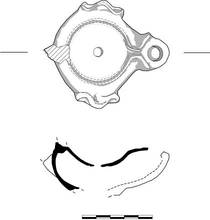
423. Lamp (Claudian)
P. H. .025. L. .075. W. .07.
C29.0331. L0159. Nozzle, discus and handle missing. Partially burned. Altar in relief on discus, mostly broken away. Fnger marks on discuss ridge, clay globules from mold in ridges around discuss, partial blackening around the wick-hole. Oragnish buff fabric (5YR 6/6 and 7/6), red brown slip (2.5YR 4/6 and 5/6), very fine silver mica.
First published as , no. 117. Cf. From the Hadrianic fill of the C29 well.
svg/L0159.jpg
424. Lamp (late 1st to early 2nd century AD)
P. H. .03. L. .095.
. L0163. Almost complete, missing base, part of nozzle, and handle. Large discus with relief decoration of a dog on a kline. Slightly irregular double ridge around discus. Shallow groove around flat bottom. Orange fabric (between 7.5YR 6/4 and 7/6) with a thin mottled light brown slip (between 5YR 4/4 and 5/4).
First published as , no. 118. From the Hadrianic fill of the C29 well.
svg/L0163.jpg
425. Lamp (late 1st to early 2nd century AD)
P. H. .03. L. .095. W. .074.
. L0168. Base and nozzle missing, six fragments conserved. Rather thin walls, less than 5 mm. Discus relief decoration of a vine wreath, from a fresh mold. Part of fill preserved. Fabric fired orange (between 2.5YR 6/6 adn 6/8), slip orange/red (between 2.5YR 5/6 adn 5/8).
First published as , no. 119. From the Hadrianic fill of the C29 well.
svg/L0168.jpg
426. Lamp (late 1st to early 2nd century AD)
P. H. .08. L. .085. W. .08.
. L0167. Fragment of discus with center missing. Very thin walled. Ovolo course around discus. Very fine, compact buff fabric (between 7.5YR 7/4 and 7/6). Unevenly fired: slip matte orange red, in some parts matte brown. Burning on ridge of discus.
First published as , no. 120. From the Hadrianic fill of the C29 well.
svg/L0167.jpg
427. African Red-Slip Hayes Type 2 Lamp (5th to 6th century AD)
. L0061. Red fabric with distinct slip. Monogrammed cross with curved top of 'Rho' and top of post partially extant in discus. Impressed palm fronds on shoulder.
pp. 310-314 for chronology.
428. One Handled Jug (Third Century AD)
P. H. .365.
z16.0115. P0757. One handled jug with wheel ridged globular body and strap handles. Flat based, complete, but missing part of rim. Color between 5YR 4/6 and 5/6 with fine silver mica and lime bits visible on the surface. Loca/regional. Graffito (inscribed) on shoulder MA. Found in the z16 shaft deposit.
429. One Handled Jug (Third Century AD)
H. .228.
z16.0115. P0754. Jug with trefoil rim, missing part of the rim. Flat based? with strap handles. Highly micaceous gritty fabric in orangish buff color (betw 7.5YR 7/4 and 7/6) block volcanic bits on the surface. Found in the z16 shaft deposit.
430. Table Amphora (Third Century AD)
H. .50.
z16.0115. P0756. Nearly complete. Banded rim, wheel ridged body, molded base. Orangish buff (between 5YR 6/4 and 6/6) with lime and silver mica. Found in the z16 shaft deposit.
431. Plain Ware Jug Rim (Roman)
P. H. .04. Est. diam. rim .11 (1/4 preserved). Th. .005.
K/L16/17.0120:16. Single sherd with rim and upper part of neck. Light red (2.5YR 6/6) fabric with occasional lime chunks and frequent tiny light bits. Surface lightly slipped buff (near 7.5YR 7/3).
Cf. “Light Brown Fabric”. Cf. , no. 94.
svg/K-L16-17.0120-16.jpg
432. Regional Brown Plain Ware Jug Neck and Rim (Roman)
K/L16/17.0427:38. P.H. .047, est. D. rim .044 (3/5 preserved), Th. neck .006. Single sherd of rim and upper neck. Fine brown (5YR 5/6) fabric with tiny white inclusions. The exterior surface is plain, the interior is lined with dark pitch(?).
svg/K-L16-17.0427-38.jpg
433. White Slipped Plain Ware Jug Rim (Roman)
K/L16/17.0427:44. Unclassified White Slip Ware. P.H. .049, est. D. rim .0425 (1/2 preserved), min. th. wall .003. Single neck sherd. Light brown (5YR 5/8) fabric with only occasional lime chunks. Whitish (10YR 8/3) slip, now quite fugitive, partially preserved on exterior.
svg/K-L16-17.0427-44.jpg
434. Unclassified Thin-Walled Jug, Funnel Mouth (Roman)
K/L16/17.0461:1. P.H. .031, est. D. rim .075 (1/5 preserved), min. th. funnel .0029. Compact, fully-fired brown (2.5YR 5/6) fabric with only occasional tiny lime inclusions. Mica flattened on surface. Coated surface is lighter brown (5YR 6/4).
svg/K-L16-17.0461-1.jpg
435. Unclassified Plainware Jug (Roman)
K/L16/17.0114:51. P.H. .056, est. D. rim .088 (1/2 preserved), Th. .0045. Single rim sherd. Fine fabric fired light red (2.5YR 6/8, lighter towards surface) and varied small inclusions that are mostly white but some dark. Buff (7.5YR 8/3) exterior surface is coated, interior plain. There are two horizontal lines incised below the rim.
svg/K-L16-17.0114-51.jpg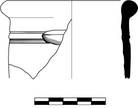
436. Unclassified Plainware Jug (Roman)
K/L16/17.0114:52. P.H. .084,, Th. .0025. Two joining sherds. Light brown (5YR 7/6) fabric with elongated lime inclusions up to .001 in length and other varied small inclusions as well as frequent voids. The now very worn buff (10YR 8/2) exterior surface preserves some original coating. The interior is plain. There is slight banding on the neck (not shown on illustration) and ridges appear on the small portion of preserved body.
svg/K-L16-17.0114-52.jpg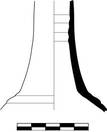
437. Unclassified Plainware Jug (Roman)
K/L16/17.0114:54. P.H. .123, est. D. rim .058 (1/3 preserved), Th. neck .006. Slightly coarse pale brown (5YR 7/6) fabric with frequent small white and dark inclusions and occasional voids. Buff (10YR 8/4) exterior surface is coated, the interior is plain.
svg/K-L16-17.0114-54.jpg
438. Unclassified Plain Ware Jug Moulded Base
K/L16/17.0086:13. P.H. .037, D. base .07 (completely preserved), min. th. wall .0024. Single base sherd. Slightly granular orange/red (2.5YR 6/8) fabric with only occasional tiny lime inclusions, and rarer dark bits. Coated surface is slightly lighter (2.5YR 6/6). Tooled grooves on interior. In terms of both fabric and finish, this piece has more in common with the sanded-oxydized cookingware than it does with usual buff, compact plain ware jugs.
svg/K-L16-17.0086-13.jpg
439. Unclassified Semi-Slipped Jug, Incised Strap Handle (Roman)
K/L16/17.0114:14. P.H. .073, Th. wall .035. Handle with small portion of wall attached. Fine red (2.5YR 5/8, lighter towards surface) fabric has frequent tiny white and darker inclusions. Extant exterior surfaces carry thin, unsmoothed red (10R 4/6 where darkest) slip that is unevenly applied. Handle has three deep grooves decreasing in width from left to right. These grooves were made with a relatively thin blade inserted at progressively more perpendicular angles from widest to thinnest.
svg/K-L16-17.0114-14.jpg
440. Plain Ware Jug Rim
K/L16/17.0467:11. Not cataloged
441. Plain Ware Jug Neck and Rim
K/L16/17.0169:13. Not cataloged
442. Unclassified Semi-Slipped Jug/Lid?
I17.0647:8. P.H. .038, est. D. knob .026 (2/3 preserved), Th. lid .025. Four joining sherds preserving knob but not edge. Medium gray (no munsell) fabric with occasional tiny lime? Inclusions. Surface is plain but color is made by a thin oxidized layer, less than .0025 thick. This layer is fired light red (2.5YR 6/6) on interior, reddish-brown (2.5YR 4/3) on exterior. Near K/L16/17.0434:05 and K/L16/17.0120:09 but far fewer inclusions in this piece. Identical fabric to K17.0860:12.
I17.0647-8.jpg
443. Semi-slipped bowl (Hadrianic?)
P. H. .07. Est. diam. rim .168. Est. diam. base .064.
. P0455. Almost complete, ten joining fragments. Plain bowl with ring base. Fabric soft buff (between 10YR 6/4 and 7/4), and with a greenish tinge. Some mended fragments have been burned.
First published as no. 58.
svg/P0455.jpg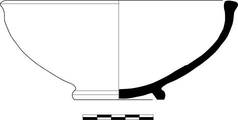
444. Plain Ware Bowl (2nd Century AD)
P. H. .13. Est. diam. rim .30.
K/L16/17.0086:3. Ten joining and non-joining sherds allow profile to be restored. Soft, slightly granular pale green (5Y 8/3) fabric with added sand (quartz, red, black – all small) and frequent lime chunks also visible on surface. The surface may have been intentionally coated dark greenish/gray (near 5Y 3/2) but is only poorly preserved now. The base is irregularly formed with the differing widths shown in the illustration. Metal adheres to sherds K/L16/17:0146:03 and K/L16/17.0118:21a and b.
svg/K-L16-17.0146-3.jpg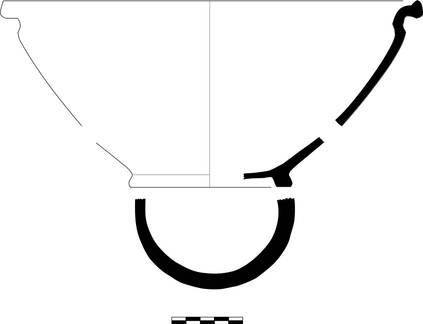
445. Unclassified Plain Ware Cookpot, Downturned Rim
P. H. .057. Est. diam. rim .19 (completely preserved). Th. .004.
K/L16/17.0114:1. Seven joining sherds. Slighty granular brown (5YR 6/6) fabric with frequent varied angular inclusions and gold mica visible in section and on the surface. Thinly coated surface is pale brown (5YR 7/6). One strap handle (as shown by complete preservation of rim). No joins to the simiar vessel in K/L16/17.0112.
svg/K-L16-17.0114-1.jpg
446. Unclassified Plain Ware Cookpot, Downturned Rim
K/L16/17.0112:19. P.H. .027, est. D. rim .14 (1/6 preserved), th. wall .005. Two joining rim sherds. Slighty granular brown (5YR 6/6) fabric with frequent varied angular inclusions and gold mica visible in section and on the surface. Thinly coated surface is pale brown (5YR 7/6). Iron patch interrupted by break. See :18 for probable base.
svg/K-L16-17.0112-19.jpg
447. Unclassified Plain Ware Pot, Molded Base
K/L16/17.0112:18. P.H. .032, est. D. base (1/3 preserved), th. wall .0041. One base sherd. Identical in fabric to K/L16/17.0112:19. Probably base of the same.
svg/K-L16-17.0112-18.jpg
448. Unclassified Semi-Slipped Utilitarian Ware Bowl
K/L16/17.0118:13. P.H. .045, est. D. rim .24 (1/6 preserved), Th. wall .005. Single rim sherd. Fine brown (5YR 5/6) fabric with frequent white inclusions and occasional gold mica in fabric and on the surface. Thin red (10R 5/6) slip on all surfaces.
svg/K-L16-17.0112-7.jpg
449. Unclassified Plainware Basin (Roman)
K/L16/17.0118:14. P.H. .024, D. rim not recoverable but in .25 to .30 range (<1/8 preserved, damaged), Th. .009. Single rim sherd. Slightly coarse brown (2.5YR 5/6) fabric with frequent small angular inclusions and occasional voids. Surface is coated and slightly darker than fabric.
svg/K-L16-17.0118-14.jpg
450. Unclassified Plainware Krater (Roman)
K/L16/17.0461:15. P. H. .036, Est. d. rim .216 (1/6 preserved), , Th. .004. Single sherd of rim and upper wall. Brown (5Yr 5/4) fabric with few tiny white inclusions. Fabric is perhaps discolored by fire. Weak gray slip (5YR 6/2) on all surfaces. Ash patches all over. Unslipped. Cf. Kozal 2001, no. 75.
svg/K-L16-17.0461-15.jpg
451. Large Portable Processing Platform (2nd Century AD)
P. H. .083. Th. .018. L. 23. W. .132.
K/L16/17.0114:5. Two joining sherds preserve corner, original dimensions not recoverable. The fabric and surface of this piece are identical to the very large mixing bowl/mortarium (K/L16/17.0144:5). The large golden mica flakes, in particular, make it very likely that they come from closely related workshops. There is a layer of white accretion not removed by the acid bath used to conserve the piece but this is not part of the original surface. It is, however, under the remaining patches of dark gray ash so that this is evidence of post-depositional burning: i.e., a sequence of deposition, accretion, burning. Even without knowing the original dimensions, the surviving portion indicates a large and sturdy piece of kitchen equipment. In form, it is a platform with upturned edges. It stood on at least two raised feet, only one of which is in evidence, that ran along parallel sides. The extant foot is .04 high from base to lower floor. There is a single ridge on the sloping upper face of the edge. There is no extant iron adhering to this piece.
svg/K-L16-17.0114-5.jpg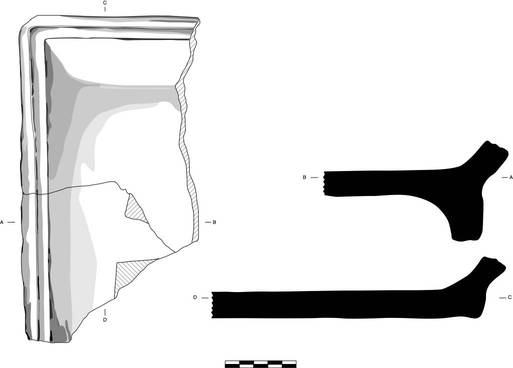
452. Very Large Mixing Bowl/Mortarium (2nd Century AD)
P. H. .078. Est. diam. rim .65-.75. Th. .0295.
K/L16/17.0144:5. Single rim fragment. Fabric is predominantly pale red (5YR 6/6), with variation around this. As with any such large utilitarian vessel, the inclusions in this piece are extremely varied. At the large end is angular quartz up to .007 in length, and rounded lime chunks .002 in diameter. There are gray and reddish stones .005 and smaller. An important component is the regular presence of large and small golden mica flakes, up to .003 in diameter when flattened on the base. At the small end of the size scale are an abundance of angular and rounded light and dark bits. Despite the high frequency of inclusions the paste is not overwhelmed. Using the munsell “charts for estimating the proportions of mottles and coarse inclusions” puts the inclusions in this vessel at between 5 and 7 percent. The coating is pale brown (7.5YR 7/4); it is worn away by use below rim. There is a single patch of iron on the extant interior face.
svg/K-L16-17.0144-5.jpg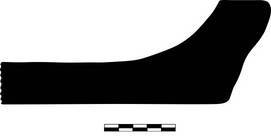
453. Plain Ware Bowl Profile (Early Roman)
H. .55. Est. diam. rim .16 (<1/20 preserved). Est. diam. base .06 (1/3 preserved). Th. .007.
K/L16/17.0120:11. Single sherd preserving profile. Fabric is fired brown (5YR 6/8). The inclusions are varied, consisting of .001 lime chunks, some visible on surface, angular quartz, and sub-angular stones, and varied tiny bits. There are occasional small voids. Surfaces smoothed with some scratches and surface voids. A simple form with similarities to red-slipped tablewares such as ESA Hayes 22.
svg/K-L16-17.0120-11.jpg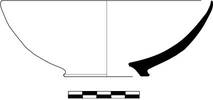
454. Semi-slipped Incurved Rim Bowl
K/L16/17.0169:16. P.H. .034, est. D. rim .16 (1/10 preserved), Th. .004. Single rim sherd. Slightly coarse light red fabric (2.5YR 6/6 near exterior, changing to 2.5YR 6/4 at interior) with frequent small angular white inclusions as well as darker. Interior slip is thin, dark brown (2.5YR 4/3), exterior thinner red (near 10R 5/8). Exterior shows distinct stick smoothing bands on exterior, brush marks on interior. May be residual.
svg/K-L16-17.0169-16.jpg
455. Semi-slipped Bowl, Recurved Handle
K/L16/17.0086:2. P.H. .051, est. D. rim near ~.15, min. th. wall .007. Single sherd, rim and re-flexed handle. Compact brown (5YR 5/6) fabric with occasional subangular lime inclusions. The surface is encrusted but was plain. The interior is lightly slipped and fired light red (10R 6/6). Upper face of thickened rim has single groove near outer edge.
svg/K-L16-17.0086-2.jpg
456. Regional Brown Plain Ware Basin, Incurve Rim
K/L16/17.0427:30. P.H. .04, est. D. rim ~.25 (1/10 preserved), Th. .wall min. 007. Single rim sherd. Compact, hard pale brown (5YR 6/6) fabric with some tiny inclusions. Plain surface, thinly self-slipped/coated and slightly lighter in places.
svg/K-L16-17.0427-30.jpg
457. Regional Brown Plain Ware Basin, Incurved Rim
K/L16/17.0427:31. P.H. .048, est. D. rim ~.33 (1/10 preserved), Th. min .008. Single rim sherd. Compact brown (7.5YR 5/3) fabric with frequent tiny light and dark inclusions. Buff (7.5YR 7/3) thinly self-slipped/coated surface. Small patches of excess clay on interior of rim.
svg/K-L16-17.0427-31.jpg
458. Regional Brown Plain Ware Basin, Incurved Rim
P. H. .064. Est. diam. rim .28 (1/3 preserved). Th. .007.
K/L16/17.0461:31. Single sherd of rim and upper wall. Compact brown (2.5YR 7/4) fabric with varied tiny inclusions, becoming redder towards surface. Pale (near 7.5YR 7/6) surface, self-slip.
svg/K-L16-17.0461-31.jpg
459. Plain Ware Basin, Type 1
P. H. .081. Est. diam. rim .30 (1/5 preserved). Th. .006.
K/L16/17.0467:22. Single large rim sherd. Compact red (2.5YR 6/6) fabric with small rounded light and occasional rounded dark inclusions. Coated exterior surface is very pale (10YR 8/2).
svg/K-L16-17.0467-22.jpg
460. Regional Brown Plain Ware Basin, Incurved Rim
P. H. .037. Est. diam. rim .31 (1/8 preserved). Th. .065.
K/L16/17.0112:16. Single rim sherd. Slightly granular, red (2.5YR 7/8) fabric with some angular light and dark inclusions. Pale white coating on exterior. Interior plain. Metal patch adhering to inner wall.
svg/K-L16-17.0112-16.jpg
461. Regional Brown Plain Ware Basin, in-turned stepped ledge rim
P. H. 042. Est. diam. rim .22 (1/10 preserved). Th. .007.
K/L16/17.0456:3. Single rim sherd. Compact brown (2.5YR 5/8) fabric with frequent tiny angular inclusions and occasional larger, up to .0025 in diameter, dark chunks exposed on the surface. The interior surface is plain. The exterior has a very light buff (7.5YR 8/3 where thickest) wash that lets the fabric color show through. Near Kozal 2001, nos. 156 and 164.
svg/K-L16-17.0456-3.jpg
462. Regional Brown Plain Ware Basin, white slip, ledge rim
P. H. .031. Est. diam. rim .26 (1/5 preserved). Th. .0045.
K/L16/17.0456:2. Single rim sherd. Fine brown (5YR 5/6) fabric with occasional elongated lime inclusions as well as other small light bits. The exterior surface is plain. The upper face of the rim and the interior are coated white that survives only as partially preserved streaks.
svg/K-L16-17.0456-2.jpg
463. Regional Brown Plain Ware Pot, Ledge Rim (Early Roman)
P. H. .026. Est. diam. rim .23 (1/7 preserved). Th. .005.
K/L16/17.0427:32. Single rim sherd. Compact brown (2.5YR 6/8) fabric with frequent small black inclusions and occasional larger angular quartz. Surface plain, with thin self-slip.
svg/K-L16-17.0427-32.jpg
464. Regional Brown Plain Ware Jug Base
K/L16/17.0114:31. P.H. .03, D. base .054 (completely preserved), Th. wall .004. Single base sherd. Fine brown (5YR 6/6) fabric with small white and dark inclusions, as well as occasional voids. The exterior surface is coated, smoothed and slightly redder (2.5YR 6/6) than the fabric. The interior is plain.
svg/K-L16-17.0114-31.jpg
465. Regional Brown Plain Ware Jug Base (Roman)
K/L16/17.0114:7. P.H. .079, est. D. base ~~.10 (<1/10 preserved), Th. wall .045. Single sherd, molded base. The slightly coarse brown (2.5YR 5/8, lighter towards inner surface) includes rare pieces of previously fired clay, infrequent angular quartz(?), and frequent smaller bits. The exterior surface is coated red (10R 5/4), the interior is plain.
svg/K-L16-17.0114-7.jpg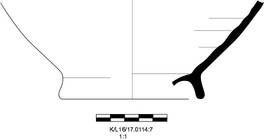
466. Regional Brown Plain Ware Basin, T-Rim
K/L16/17.0114:48. P.H. .056, Th. .006. Single rim fragment. Coarse brown (5YR 5/6) fabric with frequent small light and darker inclusions and occasional voids, near Kozal 2001 “Brown Fabric”. Exterior surface coated and fired buff (7.5YR 8/3), interior plain. The diameter is irregular suggesting that this is a approximately rectangular basin with very rounded corners.
467. Regional Brown Plain Ware Basin, T-Rim
K/L16/17.0144:7. P.H. .004, irregular diameter, Th. wall .01. Single rim sherd. Fine brown (5YR 5/6) fabric with frequent tiny and occasional elongated, up to .0005 in length, white inclusions. Occasional small dark inclusions are also present. A single quartz chunk is visible on the surface on extant sherd. The surface is coated but just slightly darker than the fabric. Two pairs of grooves are present on the upper surface of the t-shaped rim, both inside of the circumference of the wall.
svg/K-L16-17.0144-7.jpg
468. Regional Brown Plain Ware Basin, Short T-Rim
K/L16/17.0144:10. Basin, ledge rim
K/L16/17.0144:10. [[SY.IY.DY.MN.FN]] Unclassified Utilitarian Plain Ware. P.H. .045, diameter irregular, Th. wall .006. Single rim sherd. The fine brown (2.5YR 5/6, faint lighter core) fabric has mostly white small angular inclusions. All extant surfaces are coated pale brown (7.5YR 7/4).
svg/K-L16-17.0144-10.jpg
469. Regional Brown Plain Ware Basin, Lug Handle
K/L16/17.0114:49. P.H. .055, Th. .006. Single wall sherd with attached handle. Compact brown (2.5YR 6/6 and near 7.5YR 6/6) fabric with small dark and light inclusions as well as frequent tiny white inclusions. Buff (10YR 8/3) exterior surface is coated. Interior plain.
Problem: illustration may be upside down.
svg/K-L16-17.0114-49.jpg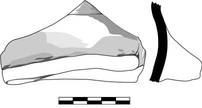
470. Regional Brown Plain Ware Basin, Lug Handle
K/L16/17.0114:50. P.H. .048, Th. .01. Single wall with attached handle. The fine brown (5YR 5/6) is identical to K/l16/17.0114:18, as is the surface. The handle is .07 wide with 3, originally perhaps four, finger impressions. A small patch of iron is adhering to the inner surface.
svg/K-L16-17.0114-50.jpg
471. Regional Brown Plain Ware Bowl
P. H. .053. Est. diam. rim .31 (1/5 preserved). Th. .006.
K/L16/17.0461:20. Single rim shared. Compact brown (5YR 6/8) fabric with small mostly angular dark and light inclusions. Thin pale (7.5YR 7/3) slip over all surface. Broad ridges on exterior wall. Ash on interior of bowl, but only a small streak on exterior; not necessarily from original use.
svg/K-L16-17.0461-20.jpg
472. Semi-slipped Deep Bowl or Dish (Early Roman)
K/L16/17.0427:33. P.H. .059, est. D. .30 (1/10 preserved), Th. .065. Two joining sherds. Compact fabric with small to medium angular white inclusions. Gray (Gley 2 – 5B 5/1) core turning brown (5YR 6/6) towards surfaces. Surfaces are slipped; interior fired brown to buff (7.5YR 5/2 to 7/4), exterior is more red (10R 5/6 to 4/2). Two grooves on upper face of rim. Light groves/wheelmarks on interior. The rim form is perhaps in imitation of ESB Form 76.
svg/K-L16-17.0427-33.jpg
473. Semi-slipped Deep Bowl, Ledge Rim (Early Roman)
K/L16/17.0427:35. P.H. .068, est. D. rim ~.33 (<1/10 preserved), Th. min. wall .006. Single rim sherd. Compact reddish-brown (2.5YR 5/6) fabric with inclusions ranging from occasional large elongated white to frequent small dark bits. Surface thinly self-slipped and only just darker than fabric. Single deep groove towards outer edge of upper face of everted rim.
svg/K-L16-17.0427-35.jpg
474. Regional Brown Plain Ware Bowl, Ledge Rim (Early Roman)
P. H. .077. Est. diam. rim .33 (1/10 preserved). Th. .009.
K/L16/17.0427:36. Single rim sherd. Somewhat granular brown (5YR 5/6) fabric with frequent inclusions ranging large angular quartz and lime to small light and dark bits. Surface thinly coated but otherwise plain. Two grooves, one near inner and outer upper face of rim.
svg/K-L16-17.0427-36.jpg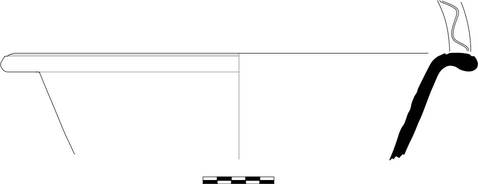
475. Regional Slipped Utilitarian Bowl
K/L16/17.0427:39. Single rim sherd. Downturned, rounded rim; beginning of flattening of wall vestigially extant. P.H. .019, est. D. rim ~.32 (<1/10 preserved), Th. wall .011. Fine brown (2.5YR 6/6) fabric with few tiny white inclusions. Interior has red (10R 5/8) slip. Exterior plain. Perhaps in imitation of Cand “rounded rim” bowls.
svg/K-L16-17.0427-39.jpg
476. Plain Ware Basin, ledge rim.
K/L16/17.0467:19. P.H. .047, est. D. rim ~36, (1/5 preserved), th. .007. Single rim shrd. Brown (5YR 5/6) fabric with tiny black inclusions and a few larger sub-rounded light chunks. Surface pale (2.5YR 6/4).
Cf. , no. 76.
svg/K-L16-17.0467-19.jpg
477. Unclassified Gray Ware Basin
K/L16/17.0169:8. Uncataloged
478. Brazier
K/L16/17.0461:23. P. H. .123, Th. .024. Single sherd of lower wall and knob foot. Very coarse brown fabric (2.5YR 5/8) with frequent angular white and varied smaller other inclusions, typical for form.
svg/K-L16-17.0461-23.jpg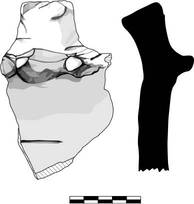
479. Brazier or Cover
K/L16/17.0086:4. Th. .011. Single sherd with cover and “back”. Light gray (2.5Y 6/2) core, brown under surfaces. Frequent lime, quartz and varied sand inclusions, mostly light. Coated surface is brown (5YR 6/6).
svg/K-L16-17.0086-4.jpg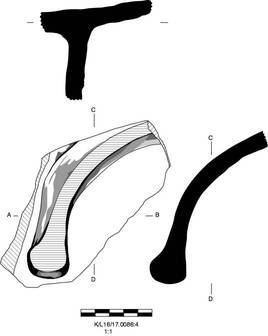
480. Plain Ware Incurved Rim Bowl
K/L16/17.0114:32. P.H. .034, est. D. rim .156 (1/4 preserved), Th. .035. Compact brown (near 5YR 5/6) fabric with tiny dark inclusions and small rounded voids. Surface coated and slightly darker than fabric. Cf. Tekkok 2001, no. 68 and Kozal 2001, no. 67 for 2nd AD incurve rim bowl.
svg/K-L16-17.0114-32.jpg
481. Plain Ware Incurved Rim Bowl
K/L16/17.0144:8. P.H. .036, est. D. rim .17 (1/8 preserved), Th. .003. Compact, light brown (near 5YR 6/6) fabric with frequent varied small inclusions. Surface is coated and lighter than fabric (7.5YR 7/3). There are patches of iron adhering to the exterior of this vessel.
svg/K-L16-17.0144-8.jpg
482. Plain Ware Bowl, Downturned Rim
K/L16/17.0144:11. P.H. .022, est. D. rim .18 (1/10 preserved), Th. .035. Single rim sherd. Reddish brown (near 2.5YR 6/8) fabric with frequent angular white and rounded reddish and darker inclusions. The surface is coated buff (10YR 8/2). See the 112/114 drooping rim cookpot for a very similar from but not same fabric.
svg/K-L16-17.0144-11.jpg
483. Plain Ware Basin
K/L16/17.0114:36. P.H. .026, est. D. rim .26 (<1/10 preserved), Th. wall .005. Single rim sherd. Fine brown (2.5YR 5/6) fabric with occasional angular white and occasional darker red inclusions, none larger and .005. Some gold mica is also visible in the fabric as well as lying flat on the surface. The surface has a thin and matte red (10R 5/6) slip.
svg/K-L16-17.0114-36.jpg
484. Plain Ware Basin Base
K/L16/17.0114:25. P.H. .076, est. D. ~.20 (1/10 preserved), Th. .006. Single base sherd. Granular brown (5YR 5/6) fabric with occasional lime inclusions as well as frequent tiny white inclusions. The coated exterior surface is buff (5YR 6/3), the interior is plain.
svg/K-L16-17.0114-25.jpg
485. Plain Ware Basin Base
K/L16/17.0114:29. P.H. .04, est. D. bas. .22 (1/5 preserved), Th. wall .011. Single base sherd. Granular reddish-brown (2.5YR 5/8) fabric with frequent angular quartz and other smaller inclusions. Surface is coated and a more pale red (2.5YR 7/6). A patch of the interior surface .03 in diameter is stained brown by the remnants of an iron object.
svg/K-L16-17.0114-29.jpg
486. Plain Ware Modius Base
P. H. .068. Est. diam. base .26 (1/4 preserved). Th. .011.
K/L16/17.0144:14. Single sherd, base and wall. Granular fabric with varied inclusions: angular quartz and rounded lime, both up to .002 in length, smaller light and dark bits. The vessel is unevenly fired, light red (2.5YR 6/6) near bottom of base and layered gray and brown near interior surface. It is distinct from the other large plain wares in this group.
svg/K-L16-17.0144-14.jpg
487. Plain Ware Basin Base
P. H. .12. Est. diam. base .21 (1/5 preserved). Th. .009.
K/L16/17.0112:17. Two joining sherds, base and lower wall. Compact brown (2.5YR 5/6) fabric with angular quartz and other smaller inclusions. All extant surface are coated and fired pale (2.5Y 8/2).
svg/K-L16-17.0112-17.jpg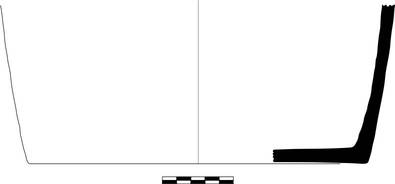
488. Large Unguentarium
K/L16/17.0148:13. P.H. .066, D. bas. .049 (completely preserved), Th. wall .012. Single base sherd. The slightly coarse pale brown (5YR 6/6) fabric has occasional sub-angular and rounded light and dark inclusions. The surface is plain.
svg/K-L16-17.0148-13.jpg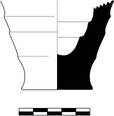
489. Unclassified Small Red-Slipped Unguentarium (Late Roman?)
P. H. .0165. Est. diam. base .05 (1/3 preserved). Th. .006.
K17.0845:15. Single base sherd. Hard, compact light red (2.5YR 6/6) fabric with occasional lime exploding on interior surface. There is a gray subsurface patch near the base just under the interior surface, this does not continue around the whole of the extant sherd. The worn surface is slipped and fired to an uneven red/orange (from 2.5YR 5/8 to 6/8). The interior of the vessel shows deep grooves. The exterior unevenly banded. A large void (.0143 long) appears on the exterior surface just above turning of floor.
svg/K17.0845-15.jpg
490. Basin, Downturned Ridged Rim
P. H. .039. Est. diam. rim near .30 (<1/20 preserved). Th. .007.
K/L16/17.0413:1. Two joining sherds, modern break. Slightly granular, hard light red (2.5YR 7/6) fabric with occasional light, elongated bits. Surface plain with buff patches thinly coated. Ridges on wide drooping rim. [[needs inking]]
491. Phocaean Cookpot
P. H. .03. Est. diam. rim .13 (1/10 preserved). Th. .003.
K/L16/17.0461:18. Single sherd of rim and upper wall. Thickened triangular rim with ridges on outer face. Brown fabric (2.5YR 5/8) with frequent white inclusions and golden mica. Gray exterior surface. Interior same as fabric.
For form see no. 85.
svg/K-L16-17.0461-18.jpg
492. Phocaean Cookpot, Inverted and Ridged Rim
P. H. .033. Est. diam. rim .15 (1/10 preserved). Th. .0025.
K/L16/17.0434:11. Single rim sherd. The compact reddish brown (near 2.5YR 5/8) fabric has frequent tiny white inclusions and less frequent darker ones, golden mica in fabric and on surface. The surface of this sherd is very worn but where preserved is gray (2/5YR 5/2).
Form near no. 84, though slightly more rounded.
svg/K-L16-17.0434-11.jpg
493. Phocaean Cookpot, Inverted and Ridged Rim
P. H. .029. Est. diam. rim .145 (1/7 preserved). Th. .002.
K/L16/17.0434:4. Single rim sherd. Slightly granular, dark reddish-brown (2.5YR 5/8) fabric with frequent tiny to small white inclusions and golden mica, some flattened on surface. Interior is plain. Exterior is gray.
For form see no. 84.
svg/K-L16-17.0434-4.jpg
494. Cookpot, Regional
P. H. .033. Est. diam. rim .020 (<1/10 preserved). Th. .004.
K/L16/17.0474:8. Single rim sherd. Granular brown-red (10R 5/8) fabric with frequent angular inclusions. Exterior surface gray, interior same as fabric. The thickened rim is folded with two deep ridges on outer face with rounded edge below.
See no. 85 for similar form in Phocaean fabric.
svg/K-L16-17.0474-8.jpg
495. Phocaean Cookpot, Flaring Rim (Early Roman)
P. H. .058. Est. diam. rim .22 (1/10 preserved). Th. .003.
K/L16/17.0120:13. Two joining rim sherds. Slightly granular brown (5YR 4/4) fabric with frequent angular white inclusions and occasional golden mica flattened on surface. Surface dark gray (2.5Y 4/1) with much thinner slip on lower part of preserved exterior. Shallow, broad ridges on exterior.
For form see no. 80.
svg/K-L16-17.0120-13.jpg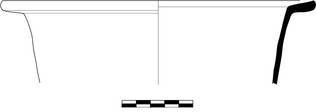
496. Phocaean Cookpot
P. H. .057. Est. diam. rim .22. Th. .006.
K/L16/17.0427:9. Single rim and handle sherd with upper wall to carination. Hard, slightly granular fabric is red-brown (10R 6/6) near exterior, shading to brown (7.5YR 6/3) near interior at wall; frequent small light and quartz inclusions. The plain surface is fired gray, thin layer. The extant handle is sliced at the right side. The color of this piece is darker than most Phocaean vessels, perhaps from use or subsequent burning. (Was drawn as 08 so needs "inking", on sheet 1754).
497. Phocaean Cookpot Rim and Handle, upturned rim
P. H. .087. Est. diam. rim near .28 (<1/10 preserved). Th. .004.
K/L16/17.0144:3. Two sherds, rim and handle. The fabric of this vessel is compact with frequent elongated light and rounded dark inclusions; orange (2.5YR 6/8) towards the interior surface and browner (7.5YR 6/4) towards the exterior. The exterior surface is gray. Slight ribbing is evident on the extant wall, an unusual feature in Phocaean vessels as found at Ilion.
Cf. , no 80; type T9, p. 86.
svg/K-L16-17.0144-3.jpg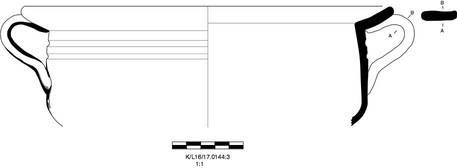
498. Phocaean Cookpot
P. H. .034. Est. diam. rim .21 (1/12 preserved). Th. .004.
K/L16/17.0102:2. Single rim sherd with handle start, flaring rim. Light red (2.5 YR 6/8) granular fabric with occasional angular and frequent tiny dark inclusions. Exterior surface fired gray (5YR 6/1), interior with streaked reddish wash.
svg/K-L16-17.0102-2.jpg
499. Unclassified Cookpot, Upturned Rim
P. H. .055. Est. diam. rim .15 (1/10 preserved). Th. .0035.
K/L16/17.0118:3. Granular red (nearest 2.5YR 6/8) fabric with very frequent small angular and occasional larger, up to .001, elongated white inclusions. The exterior surface is a dull brown (2.5YR 6/4) whereas the interior is closer to the fabric. Gold mica is visible flattened on surface. The fabric is close to "sanded oxydized cookware", though the form is Phocaean. The firing is unusual for either source: brown and no gray surface.
svg/K-L16-17.0118-3.jpg
500. Phocaean Cookingware Lid
I17.0647:15. P.H. .024, est. D. rim .14 (<1/10 presevrved), Th. max. .007. Single edge sherd. Fine light red (10R 6/8) fabric with small reddish inclusions and occasional lime. There is mica flattened on the surfaces. The exterior is gray (2.5YR 5/1 and darker). The interior is same color near edge but otherwise plain. Shallow exterior ridging begins ~ .035 below rim. Problem: offset too pronounced on illustration.
I17.0647-15.jpg
501. Phocaean Cookpot Rim
Est. diam. rim near. .31 (1/1- preserved). Th. .007.
K/L16/17.0148:12. One rim sherd. Compact, pale brown (7.5YR 6/6) fabric has large, up to .001, angular quartz inclusions with many smaller light and dark bits, gold mica, and also occasional small elongated voids. Gold mica on surface. The surface is thinly slipped in gray.
svg/K-L16-17.0148-12.jpg
502. Phocaean Globular Cookpot, upturned rim
P. H. .027. Est. diam. rim .15 (1/4 preserved). Th. .003.
K/L16/17.0114:47. Ten sherds, six joining with rim, and four probably from same vessel. The vessel has been discolored by heat, either before or after deposition. The original pale red (2.5YR 6/6) color of the fabric is preserved near the rim. Inclusions consist of angular quartz and smaller varied bits.
Cf. T4.
svg/K-L16-17.0114-47.jpg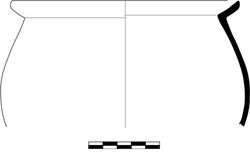
503. Phocaean Cookpot Rim and Handle Room, hooked rim
P. H. .058. Est. diam. rim .23 (1/8 preserved). Th. .004.
K/L16/17.0148:9. Single rim sherd. Slightly granular fabric is unevenly fired with brownish-red (5YR 5/6) core fading to dark brown near exterior surface. Inclusions consist mainly of small angular white bits and less common smaller dark bits as well. The exterior surface is discolored from use, the interior wall retains some weak red hue (2.5YR 5/2) in patches but is probably also discolored.
Cf. type T10, p. 87.
svg/K-L16-17.0148-9.jpg
504. Phocaean Cookpot
P. H. .044. Est. diam. rim .15 (1/12 preserved). Th. .0037.
K/L16/17.0102:1. Single rim sherd. Slightly granular, light red fabric (2.5YR 6/8) fabric, tiny dark inclusions. Gray-brown (near 10YR 5/2) surface.
Cf. type T15.11, p. 91.
svg/K-L16-17.0102-1.jpg
505. Phocaean Trefoil Rim Jug
K/L16/17.0467:21. Regional Gray on Red Thin Wall Cooking Ware. P. length .039, width across handle .0265. Single handle with part of rim. Fabric and surface are standard for ware – red 2.5YR 6/8/angular white inclusions. Gray surface.
svg/K-L16-17.0467-21.jpg
506. Phocaean Cookpot, upturned rim
K/L16/17.0114:43. P.H. .018, est. D. rim .23 (1/8 preserved), Th. rim .006. Single rim sherd. Reddish-brown (5YR 6/8) fabric with varied inclusions ranging from angular quartz to rounded darker red pieces and frequent smaller light and dark bits. The exterior surface is thinly slipped red (10R 5/6 and darker). The interior is plain. There is mica.
svg/K-L16-17.0114-43.jpg
507. Phocaean Cookpot Rim, upturned rim
K/L16/17.0086:15. P.H. .058, est. D. .27 (1/10 preserved), min. th. wall .0057. Single rim sherd. Yellowish-red (5YR 5/6) fabric with small quartz and lime inclusions in addition to other tiny bits. Inclusions are very visible on interior surface. Exterior fired gray. Offset cleanly marks transition from lower face of rim to outer wall.
svg/K-L16-17.0086-15.jpg
508. Cookpot, Regional
P. H. .018. Est. diam. rim near .010 (<1/10 preserved). Th. .002.
K/L16/17.0474:10. Single rim sherd. Slightly coarse brown (2.5YR 5/8, lighter towards surface) fabric with occasional small white, as well as some darker, inclusions. Exterior surface is gray (2.5YR 6/2) and interior is redder (2.5YR 5/4). Well formed rim has two ridges on exterior face.
See no. 152 with a single offset in face of rim.
svg/K-L16-17.0474-10.jpg
509. Regional Sanded-Oxydized Brazier, near Phocaean
K/L16/17.0169:1. Unclassified Utilitarian Ware. P.H. .116, min. th. wall .0067. Single sherd. Consistentlly fired to light brown (7.5YR 6/6) with varied large inclusions typical of such a coarse ware. Lime and dark stones, etc. Surface fired gray to weak red (10R5/1 to 5/3). The surface firing is identical to ER/MR tw cookwares such as Phocaean Jugs, but no mica.
510. Regional Sanded-Oxydized Cooking Ware Thin-Walled Cookpot
K/L16/17.0461:14. P.H. .017, est. D. rim ~.14 (1/20 preserved), th. wall .0042. Single rim sherd. Flaring rim with ridges on exterior face and interior ledge for lid. Gray fabric (2.5YR 5/1) turning to pink near surface with frequent small predominantly white inclusions. Gray (10B 4/1) exterior surface. Light wash of thin brown coating preserved on interior below rim.
svg/K-L16-17.0461-14.jpg
511. Regional Sanded-Oxydized Cooking Ware Thin-Walled Cookpot, Downturned Rim
P. H. .042. Est. diam. rim .21 (1/5 preserved). Th. .003.
K/L16/17.0417:4. Single sherd. Compact red (2.5 YR 6/8) fabric with occasional tiny white inclusions. Gray surface.
Cf. T88 and T89.
svg/K-L16-17.0417-4.jpg
512. Regional Sanded-Oxydized Cooking Ware Jug, trefoil rim
P. H. .02. Est. diam. rim not recoverable.
K/L16/17.0114:18. Single sherd with part of rim and start of handle. Fine brown (2.5YR 5/8) fabric with frequent small white inclusions. Surface intentionally vitrified.
svg/K-L16-17.0114-18.jpg
513. Regional Sanded-Oxydized Cooking Ware Jug, trefoil rim
K/L16/17.0118:2. P.H. .021, Th. across handle .013. Single sherd with part of rim and handle. The compact fabric is darker than usual (2.5YR 4/3) but the inclusions are as expected, mostly angular light/lime bits. The surface is gray.
svg/K-L16-17.0118-2.jpg
514. Regional Sanded-Oxydized Cooking Ware Jug, trefoil rim
P. H. .066.
K/L16/17.0086:10. Width mouth .0764. Single rim sherd. Light red (2.5YR 5/8) fabric with tiny lime inclusions. Gray surface. Faceted under lip.
svg/K-L16-17.0086-10.jpg
515. Regional Sanded-Oxydized Cooking Ware Jug Handle
K/L16/17.0118:19. P.L. .08, Th. across handle .02. Single handle. Red (10F 6/8) fabric with angular light and darker inclusions. Gray surface.
svg/K-L16-17.0118-19.jpg
516. Regional Sanded-Oxydized Cooking Ware Trefoil-Mouth Jug
P. H. .045. Est. diam. rim length mouth .065 (completely preserved preserved). Th. .01.
K/L16/17.0417:10. Single sherd preserves complete mouth and handle attachment. Compact red (2.5YR 5/8) fabric with frequent small white inclusions. Exterior surfaces fired gray (7.5YR 5/1) interior plain.
svg/K-L16-17.0417-10.jpg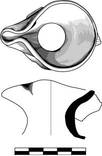
517. Unclassified Jug, Spiralled Neck
P. H. .067. Est. diam. rim .07 (completely preserved preserved). Th. .03.
K/L16/17.0413:2. Single sherd preserves complete neck and handle attachment. Compact reddish brown (2.5YR 6/6) fabric with frequent tiny mica, occasional lime visible on surface. Surface coated. Spiral groove running up neck. [[needs "inking"]]
518. Regional Sanded-Oxydized Jug Handle
P. H. .076. Est. diam. rim length .076 (completely preserved). Th. .019.
K/L16/17.0434:18. Compact red (2.5YR 5/8) fabric with frequent light angular inclusions. Surface gray (GLEY2 5/1).[[stance should be vertical]]
svg/K-L16-17.0434-18.jpg
519. Unclassified Semi-Slipped Bowl
P. H. .046. Est. diam. rim .24 (1/6 preserved). Th. .007.
K/L16/17.0114:4. Single rim sherd with wall down to beginning of floor. Slightly granular light brown (near 5YR 6/6) fabric with frequent small inclusions varying from white rounded and angular to reddish and darker rounded bits. Squared rim, initiation of slight carination of outer wall is extant. Surface slip is thin and mostly red (10R 5/8) with darker patches, probably from use. Interior is more carefully smoothed than the exterior which has scratches.
svg/K-L16-17.0114-4.jpg
520. Pompeian Red Ware Baking Pan
D09.2043:1. SC19-4c. Thick red slip on interior. Exterior plain below rim.
svg/D09.2043-1.jpg
521. Pompeian Red Ware Baking Pan
P. H. .035. Est. diam. rim .34 (1/12 preserved). Th. .01.
K/L16/17.0430:2. Single rim sherd. Granular, hard brown (7.5YR 4/3) fabric with added sand and other varied inclusions; many of the quartz-like inclusions are flattened on the outer surface and so are highly reflective. Thickly slipped and smoothed inner surface, darkened by burning. Thickened rim is undercut at exterior.
svg/K-L16-17.0430-2.jpg
522. Phocaean Baking Pan Rim to Floor (Early Roman)
H. .039. Est. diam. rim >.30 (1/8 preserved). Th. .011.
K/L16/17.0461:8. Single rim sherd with floor. Inner surface and fabric red (2.5YR 6/8) where not discolored by heat. Frequent added sand, occasional golden mica (some flattened on surface). Where best preserved the interior floor is well polished, with spiral streaks of particularly well burnished. The smoothness is not to the degree of Pompeian Red-Slip but is obviously purposeful.
Cf. P15.
svg/K-L16-17.0461-8.jpg
523. Phocaean Baking Pan Rim to Floor (Early Roman)
H. .035. Est. diam. rim .24 (1/10 preserved).
K/L16/17.0461:24. Single sherd of wall and beginning of floor. Fabric almost black from use, brown (2.5YR 6/8) just under surface of gray exterior; inclusions obscured by discoloration but golden mica flattened on interior surface. Interior wall burned from use. Large vegiform voids on exterior. Exterior gray and unburned.
Cf. P15.
svg/K-L16-17.0461-24.jpg
524. Phocaean Baking Pan Rim to Floor (Early Roman)
Th. .0093.
K/L16/17.0461:25. Single sherd preserving flaring wall. Coarse orange fabric (2.5YR 6/8) with frequent large lime and varied smaller inclusions. Interior surface smoothed. Exterior fired gray. Outer face is distinctly convex, interior only slightly flaring. Top of rim is relatively flat.
svg/K-L16-17.0461-25.jpg
525. Baking Pan Rim to Floor (Early Roman)
H. .04. Th. .013.
K/L16/17.0427:21. Single rim sherd. Coarse brown (7.5YR 5/4) with many large angular quartz inclusions. Coated interior surface is same color as fabric. Exterior is blackened from use.
Similar form from the Augustan D08 well-deposit ( no. 38).
svg/K-L16-17.0427-21.jpg
526. Baking Pan Rim to Floor (Early Roman)
H. .039. Est. diam. rim .30 (1/10 preserved). Th. .009.
K/L16/17.0427:14. Single rim sherd with small part of floor extant. Coarse light brown (5YR 7/6) with frequent white angular inclusions, added sand, and other darker inclusions. The coated interior surface is the same color as the fabric. The exterior is gray, perhaps from use. The underside is relatively rough in comparison to the walls.
svg/K-L16-17.0427-14.jpg
527. Regional Baking Pan Rim to Floor (Early Roman)
P. H. .046. Th. .011.
K/L16/17.0461:33. Single sherd of rim and beginning of floor. Fabric brown from use towards interior of wall, light brown (2.5YR 5/6) near burnt exterior. Frequent large and small, angular and rounded inclusions, predominantly white but darker as well, no mica flattened on surface.
Cf. P15.
svg/K-L16-17.0461-33.jpg
528. Regional Baking Pan Rim to Floor (Second Century AD)
H. .05. Est. diam. rim .33 (1/6 preserved). Th. .011.
K/L16/17.0114:6. Single sherd with profile. Coarse orange (5YR 6/6 and lighter) fabric with frequent added quartz and other angular inclusions. Surface gray from use. Patches of the fabric are also gray from use. The interior of the pan is smoothed, though not glossy as in Pompeian Red Ware. The exterior and underside are relatively rough. There is .02 metal patch adhering to the interior.
Cf. P23 (from Ilion).
svg/K-L16-17.0114-6.jpg
529. Baking Pan Handle (Early Roman)
C29.0011:2. SC19-4d. Single sherd, handle.
530. Regional Baking Pan Spiral Handle (Early Roman)
K/L16/17.0434:25. P. length .087, D. handle .05. Single sherd with complete spiral handle. Granular, hard bright orange (near 2.5YR 6/8) fabric with a range of large, .002, angular sand to smaller rounded inclusions that vary in color from pale to reddish to dark. The coated surface is dull red (2.5YR 6/3).
Cf. P14.
svg/K-L16-17.0434-25.jpg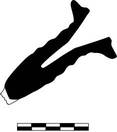
531. Slipped Baking Pan?
Th. .009.
K/L16/17.0144:1. Single sherd. Slightly granular, brown (2.5YR 6/8) fabric with frequent tiny white inclusions and occasional voids. Thick, polished red (10R 5/8) slip on upper surface; it is reminiscent of ESBii slip. Underside is plain. Single circle inscribed on upper surface. Underside is stepped.
svg/K-L16-17.0144-1.jpg
532. Cooking Pan (Early Roman)
P. H. .053. Est. diam. rim .28 (1/10 preserved).
K/L16/17.0100:32. Single sherd, rim to just below carination/floor. Granular reddish-brown (2.5YR 5/4) fabric with frequent small light inclusions. Surface gray. The vessel is not flat below the carination so no part of the floor is extant.
Cf. P29, but with no groove on rim.
svg/K-L16-17.0100-32.jpg
533. Baking Pan, Phocaean
P. H. .029. Est. diam. rim .26 (<1/10 preserved). Th. .008.
K/L16/17.0120:15. Single rim sherd with upper wall. Coarse light brown (7.5YR 6/4) fabric with added sand and varied smaller inclusions, occasional small golden mica visible on surface. The exterior surface is burned black and this discoloring intrudes into the fabric. Interior surface is unslipped but the top of the rim carries thin gray wash.
Same rim form also in Phocaean fabric at , no. 91.
svg/K-L16-17.0120-15.jpg
534. Gritty Gray Cookingware Flanged Casserole
P. H. .049. Est. diam. rim .026 (<1/10 preserved). Th. .006.
K/L16/17.0118:16. Single rim sherd to floor. The coarse fabric has a reddish-brown (2.5YR5/6) core, darker towards burned exterior. The interior surface is pink (10R 6/6). The outer wall is lightly ridged. Distinct ridge to hold lid.
svg/K-L16-17.0118-16.jpg
535. Gritty Gray Cookingware Flanged Casserole
P. H. .036. Est. diam. rim .30 (<1/10 preserved). Th. .007.
K/L16/17.0434:15. Single rim sherd, incurved rim. Coarse brown (7.5YR 4/3) fabric with frequent sandy light and dark bits.
svg/K-L16-17.0434-15.jpg
536. Flanged Casserole, Regional
P. H. .046. Est. diam. rim .32 (1/10 preserved). Th. .011.
K/L16/17.0474:7. Coarse light brown (2.5YR 6/6) fabric with frequent varied inclusions ranging in size up to .003 m. Interior surface is slightly darker than fabric, exterior is tinged gray from use. The flange and short rim are well defined. There is no ridging on the exterior.
no. 91 for form.
svg/K-L16-17.0474-7.jpg
537. Baking Dish
P. H. .065. Est. diam. rim near .33 (1/7 preserved). Th. .01.
K/L16/17.0114:11. Two joining sherds from rim to floor. Coarse brown (5YR 5/8) fabric with large quartz, rounded red and darker, and other smaller inclusions, among them golden mica. Surface is coated and fired light red (2.5YR 5/6).
Cf. P32-P48.
svg/K-L16-17.0114-11.jpg
538. Baking Dish
P. H. .05. Est. diam. rim .34 (1/10 preserved). Th. .011.
K/L16/17.0118:15. Single rim sherd. Coarse brown (2.5YR 6/8 and lighter) with very frequent inclusions ranging from angular quartz up to .002 in length to varied angular red, whitish, and darker bits. There is also gold mica, some visible on surface. The occasional voids are both elongated and rounded. The surface is otherwise coated and dull brown (5YR 6/4). Distinct ridge for holding lid.
Cf. P32-P48.
svg/K-L16-17.0118-15.jpg
539. Phocaean Flanged-Casserole (Early Roman)
H. .06. Est. diam. rim .26. Est. diam. base .22.
C29.0452. P0475. Complete. Orangeish buff fabric (between 7.5YR 6/4 and 6/6), with gold and silver mica. Smoothed surface, partially burned. Irregular bottom. Pressed clay around the rim in two parts.
First published as no. 91. From the Hadrianic deposits of the C29 well.
svg/P0475.jpg
540. Phocaean Flanged-Casserole Rim to Floor (Early Roman)
P. H. .04. Est. diam. rim .37 (1/10 preserved). Th. .008.
K/L16/17.0132:7. Single rim sherd. Greenish gray (2.5Y 7/2) fabric may be discolored from use. The inclusions range from angular quartz to varied small light and dark bits, with frequent mica.
Similar form at no. 91.
svg/K-L16-17.0114-11.jpg
541. Gritty Gray Cookingware Flanged Casserole
P. H. .049. Est. diam. rim .30 (1/12 preserved). Th. .0084.
K/L16/17.0100:34. Single rim sherd. Coarse brown (2.5YR 4/4) fabric with frequent, mostly light sand angular inclusions. Surface near black. Light exterior ridging.
svg/K-L16-17.0100-34.jpg
542. Gritty Gray Cookingware Flanged Casserole
P. H. .045. Est. diam. rim .24 (<1/10 preserved). Th. .0073.
K/L16/17.0100:33. Single rim sherd. Coarse brown (2.5YR 4/4) fabric with very frequent, mostly light and reddish sand angular inclusions. Surface near black. Very light exterior ridging.
svg/K-L16-17.0100-33.jpg
543. Gritty Gray Cookingware Flanged Casserole
P. H. .042. Est. diam. rim .21 (1/10 preserved). Th. .008.
K/L16/17.0417:14. Single sherd preserves <1/10 rim circumference. P.H. .042, est. D. rim near .22, Th. wall .008. Single rim sherd. Coarse brown (7.5YR 4/4) fabric with frequent large angular white chunks and smaller angular light and dark bits. Surface is coated reddish-brown (2.5YR 5/3 and lighter).
Cf. P51.
svg/K-L16-17.0417-14.jpg
544. Gritty Cookingware Casserole
P. H. .053. Est. diam. rim .22 (1/5 preserved). Th. .0072.
K/L16/17.0084:13. Single rim sherd. Coarse varied reddish-brown (near 5YR 5/3) with frequent light angular inclusions. The surface is fired pale red (around 10R 6/4). [[drawing needs to be traced]]
Cf. P51.
545. Gritty Gray Cookingware Flanged Casserole
P. H. .051. Est. diam. rim .30 (1/7 preserved). Th. .0055.
K17.0845:3. Single rim sherd, flange and inturned rim to lower floor. Brown (5YR 4/6) fabric with occasional large quartz, up to .001, and frequent angular light bits. All preserved surfaces are a uniform dark gray. Exterior is ridged.
Cf. P51.
svg/K17.0845-3.jpg
546. Gritty Gray Cookingware Flanged Casserole
P. H. .06. Est. diam. rim .28 (1/5 preserved). Th. .0067.
K/L16/17.0106:1. Single rim sherd. Coarse fabric with frequent angular quartz/sand inclusion. Greenish-brown core (10YR 5/3), brown layer (5YR 5/6), blackened surfaces.
Cf. P51.
svg/K-L16-17.0106-1.jpg
547. Gritty Gray Cookingware Flanged Casserole
P. H. .068. Est. diam. rim .23 (1/10 preserved). Th. .009.
K17.0777:35. Single rim sherd. Coarse, dark brown fabric (5YR 4/4) with frequent large angular and sub-angular quartz, up to .002, inclusions as well as varied other angular bits. Surfaces are near black. Rim is slightly overhanging. No ridges on exterior.
Cf. P51.
K17.0777-35.jpg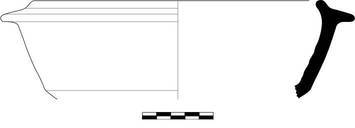
548. Gritty Gray Cookingware Flanged Casserole
P. H. .068. Est. diam. rim .22 (1/10 preserved). Th. .009.
M18.0612:1. Single rim sherd. Dark brown fabric (5YR 4/4) with frequent large angular and sub-angular quartz, up to .002, inclusions as well as varied other angular bits. Surfaces are near black. Rim is slightly overhanging.
Cf. P51.
M18.0612-1.jpg
549. Gritty Gray Cookingware Flanged Casserole
P. H. .029. Est. diam. rim .26 (1/12 preserved). Th. .0057.
M18.0099:13. Coarse fabric is black, perhaps from use. Inclusions consist of frequent angular and rounded small light lime and quartz and surrounding tiny bits. Surface is reddish gray (around 5YR 5/2). Incurved lip is distinctly tooled. Exterior lightly ridged.
Cf. P51.
M18.0099-13.jpg
550. Gritty Gray Cookingware Flanged Casserole
P. H. .054. Est. diam. rim .18 (1/10 preserved). Th. .0063.
M18.0099:11. Single rim sherd. Fabric is mostly black, perhaps from use, with parts remaining very dark brown. Inclusions and surface as #10, though with occasional large angular .002 chunks of quartz visible.
Cf. P51.
M18.0099-11.jpg
551. Gritty Gray Cookingware Flanged Casserole
P. H. .028. Est. diam. rim .18 (1/12 preserved). Th. .004.
M18.0099:9. Single rim sherd. Coarse brown (5YR 5/4) fabric with frequent small light inclusions and frequent varied bits. Surface coated and just darker (5YR 5/3), exterior narrowly ridged.
Cf. P51.
M18.0099-9.jpg
552. Gritty Gray Cookingware Flanged Casserole
P. H. .04. Est. diam. rim .17 (1/8 preserved). Th. .005.
M18.0099:10. Single rim sherd. Coarse fabric is black with a feint reddish brown (5YR 3/3) core, probably from use. Inclusions consist of frequent angular and rounded small light lime and quartz and surrounding tiny bits. Surface is coated black and slip contains mica flattened by turning. Exterior is lightly ridged.
Cf. P51.
M18.0099-10.jpg
553. Unclassified Cooking Ware Cookpot (Roman?)
P. H. .02. Est. diam. rim .12 (1/10 preserved). Th. .003.
K/L16/17.0169:9. Single rim sherd. Granular brown (2.5YR 4/4) fabric with added sand, gray near and on exterior surface. Highly micaceous, particularly on exterior where mica flakes appear flattened. Interior fired red brown.
svg/K-L16-17.0169-9.jpg
554. Gritty Gray Cooking Ware Cookpot
P. H. .027.
K/L16/17.0169:4. Uncataloged
555. Gritty Gray Cookpot (Early Roman)
P. H. .039. Est. diam. rim .16 (1/12 preserved). Th. .0057.
K/L16/17.0120:21. Single rim sherd, with upper wall. Gray (2.5YR 5/1) farbic with distinct redder (2.5YR 6/6) layering in thickened rim. Angular quartz inclusions and frequent lighter bits.
Similar form at no. 78 and no. 111.
svg/K-L16-17.0120-21.jpg
556. Gritty Gray Cookware Cookpot Rim (Roman)
P. H. .035. Th. .005.
K/L16/17.0427:10. Single rim sherd. Granular dark gray(10YR 3/1) fabric has occasional quartz and other large angular inclusions as well as much added sand. Surface is gray with large inclusions showing through the coating/self-slip.
svg/K-L16-17.0427-10.jpg
557. Gritty Gray Cookware Cookpot Rim (Roman)
P. H. .046. Est. diam. rim .20 (1/10 preserved). Th. .0055.
K/L16/17.0427:11. Compact, hard fabric has a dark gray core surrounded by a brown (2.5YR 5/4) layer and then back to gray at surface. There are occasional large (up to .003) angular quartz inclusions and much added sand. The surface is gray with large inclusions showing through the minimal coating/self-slip. Same fabric as no. :10.
svg/K-L16-17.0427-11.jpg
558. Gritty Gray Cookware Cookpot Rim (Roman)
P. H. .038. Est. diam. rim .26 (1/10 preserved). Th. .006.
K/L16/17.0427:12. Single rim sherd. Compact, gray (5PB 5/1 on Gley 2 page) with frequent small white inclusions; no oversize inclusions are visible. Fabric is fired darker just beneath surface but surface itself returns to a gray near the core. Same fabric as no. :13.
svg/K-L16-17.0427-12.jpg
559. Gritty Gray Cookware Cookpot Rim (Roman)
P. H. .061. Est. diam. rim .29 (1/10 preserved). Th. .065.
K/L16/17.0427:13. Single rim sherd. Granular, dark gray (5Y 4/1) fabric with frequent small white inclusions. Surface also dark gray.
svg/K-L16-17.0427-13.jpg
560. Gritty Gray Cookware Cookpot Rim (Roman)
P. H. .034. Est. diam. rim .22 (1/10 preserved).
K/L16/17.0434:12. Single rim sherd. Compact fabric. This vessel has a dark reddish brown (2.5YR 3/4) core becoming darker towards the dark gray surfaces. The inclusions are small to tiny, mostly white and angular but varied as well.
svg/K-L16-17.0434-12.jpg
561. Gritty Gray Cookware Cookpot Rim (Roman)
P. H. .032. Est. diam. rim near .30 (<1/10 preserved). Th. .0045.
K/L16/17.0434:13. Single rim sherd. Granular fabric, brown (5YR 4/4) core becomes darker towards the dark gray surfaces. The very frequent inclusions are mostly small to tiny white angular lime, etc. but there are occasional “reflective” elongated, .0015 in length, bits. Silver mica is also flattened on the surfaces. There are occasional small irregularly shaped voids.
svg/K-L16-17.0434-13.jpg
562. Gritty Gray Cookware Cookpot Rim (Roman)
P. H. .075. Est. diam. rim .24 (1/8 preserved). Th. .045.
K/L16/17.0434:16. Single sherd, thickened rim with attached horizontal handle. The brown (5YR 4/4) core turns darker towards the dark gray surfaces. Granular fabric, frequent angular light and dark sandy bits.
svg/K-L16-17.0434-16.jpg
563. Gritty Gray Cookware Cookpot Rim (Roman)
P. H. .041. Est. diam. rim .23 (<1/10 preserved). Th. .065.
K/L16/17.0434:14. Single rim sherd with horizontal handle. Slightly granular fabric, very frequent small angular lime and varied bits. The brown (5YR 4/4) core becomes darker towards the dark gray surfaces.
svg/K-L16-17.0434-14.jpg
564. Gritty Gray Cookware Cookpot Rim (Roman)
P. H. .086. Est. diam. rim >.30 (<1/20 preserved). Th. .011.
K/L16/17.0434:17. Two joining sherds with attachment point of horizontal handle. Coarse fabric is unevenly fired with gray (7.5YR 6/1) core, surrounding brown (2.5YR 5/6) layer turning to dark gray at the surfaces. The inclusions are frequent and varied. The largest is a sharp quartz chunk .005 in length. There are also lime chunks up to .003 in length, and then an assortment of smaller generally angular inclusions of all colors from white to reddish to dark. There are also large silver mica flakes in the fabric and on the surface. This is a distinctive piece within the cookware assemblage at Ilion.
svg/K-L16-17.0434-17.jpg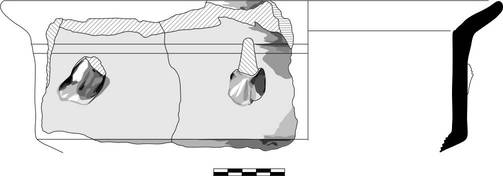
565. Gritty Gray Cookware Cookpot Rim (Roman)
P. H. .045. Est. diam. rim .24 (<1/10 preserved). Th. .007.
K/L16/17.0434:23. Single rim sherd. Granular fabric, brown (5YR 4/4) core becomes darker towards the dark gray surfaces. The very frequent inclusions are mostly small to tiny light bits. Exterior surface is pale reddish (5YR 6/3) in patch.
svg/K-L16-17.0434-23.jpg
566. Gritty Gray Cookware Cookpot Rim (Roman)
K/L16/17.0461:9. P.H. .037, est. D. rim .25, th. wall .0053. Single rim sherd. Thin red (2.5YR 5/6) core turning gray towards and on surfaces. Varied angular inclusions, with .002 elongated quartz present. Dark gray surface.
svg/K-L16-17.0461-9.jpg
567. Gritty Gray Cookware Cookpot Rim (Roman)
K/L16/17.0461:21. P. H. .019, est. d. rim .30 (1/20 preserved). Single rim sherd. Gritty gray (2.5Y 4/2) fabric with frequent small white inclusions.
svg/K-L16-17.0461-21.jpg
568. Gritty Gray Cookware Cookpot Rim (Roman)
P. H. .03. Est. diam. rim .14 (1/10 preserved). Th. .0045.
K/L16/17.0467:14. Single rim fragment with flaring rim, grooved on outer face of rim and interior concave band. Gritty gray fabric (5Y 5/1) with frequent mica and angular opaque stone inclusions. Brushed surface is slightly darker.
svg/K-L16-17.0467-14.jpg
569. Gritty Gray Cookpot Rim (Roman)
P. H. .035. Est. diam. rim near .32 (1/10 preserved). Th. .0054.
K/L16/17.0467:16. Single rim fragment. Flaring thickened triangular rim with flattened outer face and concave inner band. Granular brown (7.5YR 5/2) fabric with frequent angular inclusions. Surface fired dark gray.
svg/K-L16-17.0467-16.jpg
570. Gritty Cookware Cookpot
P. H. .032. Est. diam. rim .16 (1/10 preserved). Th. .004.
K/L16/17.0144:9. Single rim sherd. Coarse, dark brown (7.5YR 4/3) fabric with frequent angular quartz and varied sand inclusions. The surface is coated gray with many inclusions plainly visible, though flattened by turning. Cf. Kozal 2001, no. 112.
svg/K-L16-17.0144-9.jpg
571. Gritty Cookware Cookpot
P. H. .051. Est. diam. rim .22 (<1/20 preserved). Th. .006.
K/L16/17.0467:20. Single rim sherd. Compact fabric. Pale greenish brown (10YR 5/3) core with feint red-brown layer turning to dark gray at surfaces. Inclusions range from a single observed large, .004, angular chunk of quartz to assorted smaller bits, most of which are light. Occasional silver mica in fabric and flattened on surface.
svg/K-L16-17.0467-20.jpg
572. Gritty Cookware Cookpot
P. H. .094. Est. diam. rim .25 (1/10 preserved). Th. .004.
K/L16/17.0084:12. Two joining sherds, rim, neck and upper wall. Granular dark reddish brown (5YR 4/4) fabric with frequent small angular light bits. Surface caoted and fired reddish-gray (5YR 5/2). Everted rim with offset underneath; high neck and rounded body.
Cf. , no. 169.
573. Gritty Cookware Cookpot
P. H. .07. Est. diam. rim .18 (<1/10 preserved). Th. .006.
K/L16/17.0148:10. Coarse dark greenish gray (5Y 3/2) with frequent large rounded and angular quartz on other stone inclusions as well as varied smaller bits. The darker gray to black surface is smoothed in places. Unusual fabric and form.
svg/K-L16-17.0148-10.jpg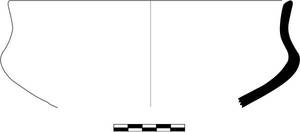
574. Regional Sanded-Oxydized Cooking Ware Lid
P. H. .04. Th. .0046.
K/L16/17.0112:6. Single sherd. Granular, pale brown (5YR 6/4, darker near surfces) fabric with occasional quartz and other varied tiny inclusions. Coated surface is dull red (10R /54) where preserved. A relatively large lump of iron is adhering near the knob.
svg/K-L16-17.0112-6.jpg
575. Gritty Cookware Lid
P. H. .015. Est. diam. rim near .31 (1/8 preserved). Th. .006.
K/L16/17.0114:45. Single edge sherd. Granular, red (10R 5/8, browner towards edge) fabric with frequent small angular white inclusions and golden mica, some flattened on surface. The plain surface is brown.
svg/K-L16-17.0114-45.jpg
576. Gritty Cookware Lid
K/L16/17.0114:44. P.H. .013, est. D. edge ~.16, Th. .055 (<1/20 preserved). Single edge sherd. Coarse light red (near 10R 6/6) fabric is unevenly fired with frequent added light and dark sand, inlcuding larger dark angular bits. Patches of the vessel have been discolored gray throughout from use or post-depositional heat. The rough surface is gray.
svg/K-L16-17.0114-44.jpg
577. Gritty Cookware, Lateral Handle
K/L16/17.0114:45. P.H. .034, est. D. rim ~.014 (1/7 preserved), Th. .004. Single rim and handle sherd. Slightly granular greenish-gray (2.5Y 6/3) fabric with occasional tiny white inclusions. More compact than the usual ER/MR gritty gray cookware. Surface coated a slightly darker gray. The lateral handle is attached at top of rim and extends for just over .06 meters. There are five finger-impression on its outer edge. Near Kozal 2001, no. 110 (also in gray ware). Near Tekkok 2001, no. 78 (brown fabric).
svg/K-L16-17.0114-45.jpg
578. Unclassified Cookpot, perhaps imitating Phocaean form
K/L16/17.0100:11. Single sherd. P.H. .092, est. D. rim .315 (1/6 preserved), min. th. wall .0073. Light reddish-brown (5YR 6/3) fabric with abundant tiny “mottled lime” inclusions. Surface is generally pale red (10R 6/3) in lower preserved parts but becomes gray near and over rim. A short span (.045) of the outer edge of the rim has a vitrified surface. Wide ridges on exterior.
svg/K-L16-17.0100-11.jpg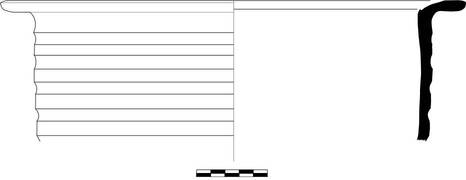
579. Cookpot, horizontal rim
P. H. .095. Est. diam. rim .19 (1/5 preserved). Th. .006.
K17.0752:5. Single sherd preserves rim, handle and body to below handle. Shallow grooves on upper face of rim, wide oval handle. Dark brown (2.5YR 4/4) granular fabric with very frequent added sand, mostly light, and mica. Interior is dull red (2.5 5/4), exterior becomes gray on handle and towards lower preserved wall.
580. Late Roman Cookpot, ledge rim.
P. H. .069. Est. diam. rim .14 (1/10 preserved). Th. .005.
H17.0069:8. Single groove on rim, deep ridges exterior of wall double handles with oval profile. Brown granular fabric with lots of gold mica on surface.
Fabric as K17.0752:5
H17.0069-8.jpg
581. Late Roman Cookpot, Thickened and Grooved Rim
P. H. .045. Est. diam. rim .13 (<1/10 preserved). Th. .0045.
I17.0647:11. Two joining rim sherds. Granular fabric unevenly fired with gray core (GLEY 1 7/1) and light red (2.5YR 6/8) layer. Frequent angular inclusions including golden mica on surface. Also a single large, .0025, chunk of quartz is extant intruding on the interior surface. Surfaces are coated and fired variably but all close to dull reddish-brown (2.5YR 5/3).
Cf. "Local Pot Type III", p. 45 and plate 35, no. 5.
I17.0647-11.jpg
582. Late Roman Cookpot, Thickened and Grooved Rim
P. H. .04. Est. diam. rim .20 (1/10 preserved). Th. .0045.
I17.0819:1. Single rim sherd. The granular brown (5YR 4/3) fabric has abundant added sand, and turns to black just under the surface. The surface itself is variably fired. The interior is dull reddish-brown (near 2.5YR 4/2), the outer edge of the rim is comparatively light (5YR 6/6), and the exterior proper is again dull reddish-brown (2.5YR 5/4).
Near "Local Pot Type III", p. 45. Found with coin of Theodosius (C0306).
I17.0819-1.jpg
583. Late Roman Cookpot, Everted Rim (4th to 5th Century AD)
P. H. .042. Est. diam. rim .26 (1/10 preserved). Th. .005.
D20.0183:10. Single sherd, everted ledge rim. Brown highly granular fabric, fine silver and gold mica visible on surface with bits of white sand. Blackened exterior.
584. Cookpot with everted rim
P. H. .041. Est. diam. rim .14 (1/6 preserved). Th. .007.
E/F10.0170:23. Pinkish buff fabric, fired buff in core with lime, opaque quartz and fine silver mica inclusions, partially blackening exterior of the wall. Agora (Tekkök 2009 (forthcoming), n.128; robbing of pavement between Odeion Stage Building and Portico)
svg/E-F10.0170-23.jpg
585. Cookpot with everted rim
P. H. .051. Est. diam. rim .28 (1/6 preserved). Th. .007.
E/F10.0170:19. Two joining sherds with upper part of handle. Pinkish buff fabric with high amount of opaque quartz visible in section and the surface, red stones and fine silver mica.
svg/E-F10.0170-19.jpg
586. Cookpot with everted rim
P. H. .039. Est. diam. rim .12 (1/8 preserved). Th. .006.
E/F10.0209:1. Single rim sherd preserving upper wall and handle stub. Gritty brown fabric (between 5YR 5/3 and 5/4) with lime and silver mica inclusions.
svg/E-F10.0209-1.jpg
587. Cookpot with everted rim
P. H. .027. Est. diam. rim .16 (1/6 preserved). Th. .007.
E10.0125:4. Single sherd with beginning of handle, groove on top of rim. Pinkish buff (2.5YR 6/6) high amount of opaque quartz and red stones visible in section and the surface. Similar series to 128-129, 133.
Agora (Tekkök 2009 (forthcoming), n.142)
Date: t.p.q C360 (A.D. 450-457).
E10.0125-4.jpg
588. Cookpot with ledge rim
P. H. .022. Est. diam. rim .20 (1/8 preserved). Th. .006.
C/D20.0407:2. Brown granular fabric (2.5YR 5/4), lots of inclusions visible on surface opaque quartz, lime, black stones fine silver mica. (Clearing fill associated with the robbing of a wall on the East Side).
svg/C-D20-21.0407-2.jpg
589. Cookpot with ledge rim
P. H. .03. Est. diam. rim .14 (1/6 preserved). Th. .005.
D20.0037:6. Deep groove on rim.Brown granular fabric (2.5YR 4/3 and 4/4) opaque quartz and lime visible on surface.
D20.0037-6.jpg
590. Late Roman Cookpot, Flaring Rim
P. H. .044. Est. diam. rim .20 (1/12 preserved). Th. .0044.
M18.0099:16. Two joining rim sherds. "Purple Micaceous Fabric". Brown (5YR 4/2) core, red (2.5YR 5/8) under surface, frequent rounded and angular lime and “quartz”, frequent golden mica. Surface is coated, fired to light red (5YR 6/4) on upper inner face of rim, weak red (2.5YR 5/2) and lighter in other extant parts of outer and inner rim and wall.
Deep cook pots with flaring rims are common in late antiquity. E.g., nos. 220-224 from a later context. Also, see "Local Pot Type V", p. 46. These are related to the widely exported Aegean cookpot with brick red-fabric and black surface CATHMA 25 ().
M18.0099-16.jpg
591. Late Roman Cookpot Rim and Strap Handle
P. H. .025. Th. .012.
I17.0647:7. Single rim sherd with handle. Black fabric with frequent added sand and much mica, especially visible on the underside of the handle. Dull reddish brown (2.5YR5/3) surface on handle. Gray on extant interior and exterior.
I17.0647-7.jpg
592. Cookpot with ledge rim
P. H. .025. Est. diam. rim .20 (1/20 preserved). Th. .007.
K13.0254:1. Brown fabric (between 2.5YR 4/4 and 4/6) with self slip, brown stones and lime, white bits in section. Agora (Tekkök et. al. 2009 (forthcoming), n.171). Parallel: Stobi (Anderson-Stojanovic 1992, 141, n.1265, pl. 147).
K13.0254-1.jpg
593. Cookpot, everted rim
P. H. .023. Est. diam. rim .15 (1/6 preserved). Th. .005.
C/D20/21.0413:24. Granular pink fabric (2.5YR 5/4) if not blackened, quartz particles in section and fine silver mica.(Clearing fill associated with the robbing of a wall on the West Side)
svg/C-D20-21.0413-24.jpg
594. Late Roman Cookpot, Flaring Rim
P. H. .04. Est. diam. rim .14 (1/6 preserved). Th. .003.
K17.0068:50. Single rim sherd preserving upper wall. The granular orange-red (2.5YR 5/8) fabric has frequent large angular inclusions up to .005 in length, as well as frequent smaller varied bits. The thickly coated exterior surface is bright orange (between 2.5YR 7/8 and 6/8). The interior is dull brown (2.5YR 5/3). Neither the interior nor exterior slip hides the frequent large angular inclusions, though these are less visible on the exterior.
K17.0068-50.jpg
595. Late Roman Cookpot, Ledge Rim (5th Century AD)
P. H. .054. Est. diam. rim .18 (over 1/6 preserved). Th. .005.
D20.0061:4. Single rim sherd, eep groove on rim. Brown granular fabric (5YR 5/4) opaque quartz, red stones, lime pocks on surface.
596. Late Roman Cookpot, Rolled Rim (5th Century AD)
P. H. .043. Est. diam. rim .19 (1/10 preserved). Th. .004.
D20.0056:9. Single rim sherd, eep groove on rim. Brown granular fabric (5YR 5/4) opaque quartz, red stones, lime pocks on surface.
597. Cookpot, flanged rim
P. H. .023. Est. diam. rim .14 (1/6 preserved). Th. .007.
C/D20/21.0394:3. Granular orange brown pink (5YR 5/4) with chunks of black stones, quartz particles. Blackened exterior of rim. Rim form similar to African Red Slip Ware Hayes Form 91.
svg/C-D20-21.0394-3.jpg
598. Cookpot with ledge rim
P. H. .047. Est. diam. rim .22 (1/20 preserved). Th. .006.
H17.0032:25. Deep ridges on exterior wall.Blackened exterior of rim. Pinkish red granular fabric (2.5YR 5/4), with bits of opaque quartz, lime and silver mica.
H17.0032-25.jpg
599. Late Roman Cup/Small Cookpot
P. H. .03. Est. diam. rim .06 (1/4 preserved). Th. .005.
M18.0099:14. Single rim sherd preserving upper wall. "Purple Micaceous Fabric". Brown (5YR 4/2) core, red (2.5YR 5/8) under surface, coated weak red (2.5YR 5/2 and darker) surface. Frequent varied rounded and angular inclusions. Some tiny mica.
M18.0099-14.jpg
600. Late Roman Stand in Gritty Fabric, Lower Edge
P. H. .036. Th. .008.
I17.0647:14. Single sherd preserving small part of lower rim. Coarse red (2.5YR 6/6) fabric with much added sand. Dull reddish-brown exterior surface (2.5YR 5/2). Dark gray on interior and inner part of rim. The fabric of this piece is nearest to that of the earlier cooking pan series.
N18.0030:1 is a more complete version of this form.
I17.0647-14.jpg
601. Late Roman Cookpot Base
P. H. .012. Est. diam. base .15 (1/8 preserved). Th. .009.
I17.0734:2. Single base sherd. "Purple Micaceous Fabric". Almost black (GLEY1 3/1) fabric with angular quartz inclusions and frequent tiny bits. Heat induced flaking on underside exposes frequent mica flakes. Patches on underside are reddish-brown (5YR 5/6).
I17.0734-2.jpg
602. Late Roman Cookpot Base
P. H. .012. Est. diam. base .13 (1/4 preserved). Th. .006.
K17.0736:11. Single base sherd, thickened near center. "Purple Micaceous Fabric". Almost black (GLEY1 3/1) fabric with angular quartz inclusions and frequent tiny bits. Heat induced flaking on underside exposes frequent mica flakes. Patches on underside are reddish-brown (5YR 5/6).
K17.0736-11.jpg
603. Late Roman Cookpot Base (4th to 5th Century AD)
P. H. .027. Est. diam. base .28 (1/20 preserved). Th. .009.
D20.0183:14. Gritty brown granular fabric with lots of lime in section, and fine sand inclusions. See also I17.734:2 (coin of Arcadius), and K17.736:11.
604. Late Roman Cookpot/Basin Base
P. H. .013. Est. diam. base .12 (1/5, irregular preserved). Th. .0075.
M18.0099:8. P.H. .032, est. D. base near .12 (1/5 preserved, irregular), th. wall .0075. Single base sherd. Coarse reddish-brown (2.5YR 5/4) core, surrounded by orange (2.5YR 6/8) with occasional large rounded quartz and varied smaller bits. Surface is orange as well. Surfaces are not well smoothed but many particles are flattened in coating/self-slip making them more reflective. Interior wheel marks.
M18.0099-8.jpg
605. Vessel Stand (Late Roman)
Est. diam. base 18 (1/6 preserved). Th. .0095.
N18.0030:1. Granular red (btw. 2.5YR 5/4 and 5/6) fabric with frequent angular quartz and other varied bits. Coated surface fired red (2.5YR 6/6); interior closer in color to fabric; darker gray in inner face of lower edge.
N18.0030-1.jpg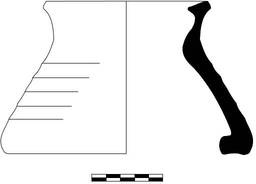
606. Vessel Stand (Late Fourth to Fifth Century AD)
Est. diam. base 20 (1/6 preserved). Th. .01.
D20.0248:1. Deep ridges on wall. Incurving rim profile. Pinkish buff granular cooking ware fabric, blackened underbase. Similar in I17.647:14 M18.30:1.
607. MRA7
I17.0647:12. P.H. .089, Th. wall .006, width handle .044, H. handle .025. Single sherd with part of neck and handle. Slightly coarse red (near 2.5YR 5/6) fabric with frequent white tiny angular inclusions as well as occasional larger angular sand. Surface is brown (near 5YR 6/6). Problem: illustration should be rotated counter-clockwise a bit.
I17.0647-12.jpg
608. Unclassified Amphora
I17.0647:13. P.H. .049, est. D. rim 12, Th. wall .007, width handle min. .054, Th. handle .015. Single sherd with rim and start of strap handle. Relatively fine fabric with grayish-brown (2.5Y 5/2) core, becoming brown (5YR 4/6) towards surface. Surface is coated and dull reddish-brown (2.5YR 5/4). The neck is probably short. The rim is squared, and undercut on the exterior.
I17.0647-13.jpg
609. Lesbos Region Amphora (late seventh to sixth century BC)
P. H. 5.6. Est. diam. rim .14 (1/4 preserved).
D09.2908:30. Multiple sherds preserving rim, part of neck and joining and non-joining handle. Rough coarse surface and breaks; dense packing pale reddish stony bits, grey glassy, yellowish lime, black, and dark grey opaque; micaceous. 2.5YR 5/8 outer core; 5YR 5/3 and darker core.
First published as , no. 1 (with references); see page 200 for discussion. Found in phase 6.
D09.2908-30.jpg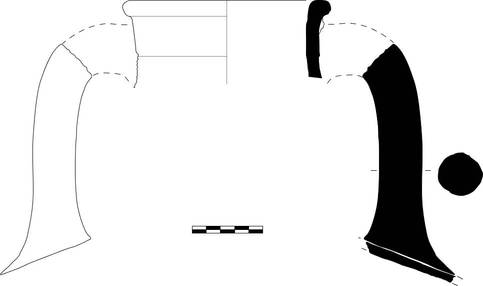
610. Attic Amphora “À la brosse” Rim (late sixth century BC)
P. H. .074. Est. diam. rim .12 (1/4 preserved).
D09.2893:6. Single rim sherd preserving neck almost to shoulder. Black slip from inside of mouth over top and outer surface of rim; also visible at lowest part of neck as preserved. Hard smooth tan surface, redder core; sparse-moderate scatter yellowish white or white bits; rar black; micaceous. 7.5YR 5/6 outer fabric; 2.5YR 6/8 inner core.
First published as , no. 75 (with references); see page 202 for discussion. Found in phase 7.
D09.2893-6.jpg
611. Northern Aegean Amphora - Wedge Rim (fourth century BC)
P. H. .097. Est. diam. rim .08 (1/4 preserved).
D09.2881:16. Narrow wedge rim. Single rim sherd preserving 1/4 rim with parts of neck and upper segments of handle. Micaceous, dark chocolate brown surface, densely micaceous; fairly smooth surface; soft grainy break with sparse black and yellowish bits; very rare greyish and white rock fragments; one piece red brown stone visible. 2.5YR 4/8.
First published as , no. 17 (with references); see page 200 for discussion. Found in deposit 3c..
svg/D09.2881-16.jpg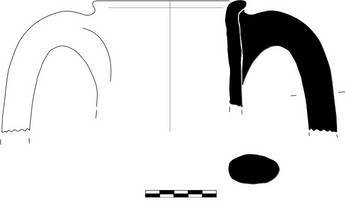
612. Northern Aegean Amphora - Wedge Rim (fourth century BC)
P. H. .083. Est. diam. rim .10 (1/4 preserved).
D09.2859:2. Flattened top, rounded outer edge wedge rim. Single rim sherd preserving ca. 1/4 rim, part of neck and handle. Coarse bricky fabric with redadily visible black chunks, dense packing stony bits, greyish; but especially noticeable are the pale pinkish translucent bits; micaceous. Outer core 2.YR 4/6 and 2.5YR 6/8 with gray inner core in thicker areas.
First published as , no. 18 (with references); see page 200 for discussion. Found in deposit 3c..
svg/D09.2859-2.jpg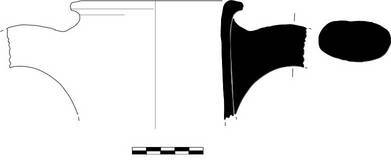
613. Troad(?) Amphora - Airfoil Rim (fourth century BC)
P. H. .213. Est. diam. rim .14 (3/8 preserved).
D09.2881:9. Multiple sherds, preserving large pieces of neck, one complete handle with shallow thumbprint at join with shoulder. Light brown fabric; dense grey glassy, less common white opaque and black bits, light red brown bits; scattered mica. 7.5YR 7/4.
First published as , no. 53 (with references); see pages 201-202 for discussion. Found in deposit 3c..
D09.2881-9.jpg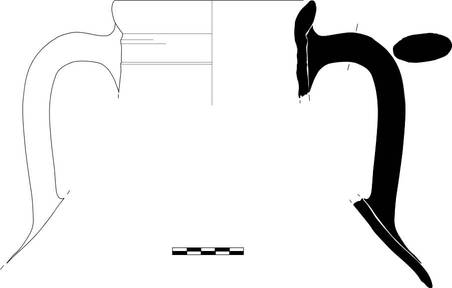
614. Troad(?) Amphora - Airfoil Rim (fourth century BC)
P. H. .067. Est. diam. rim .12 (1/4 preserved).
D09.2872:11. Airfoil rim with grooved fascia. Preserves ca. 1/4 rim, bit of neck wall. Pale purplish surface mottled with greenish lime, very dense packing grey glassy bits mixed with yellowish lime, fewer red and balck bits; micaceous.
First published as , no. 55 (with references); see pages 201-202 for discussion. Found in deposit 3b..
D09.2872-11.jpg
615. Chian Amphora Toe (3rd quarter 4th century BC)
P. H. .281. Est. diam. toe .075.
D09.2876:60. Joining sherds preserving complete toe with a large portion of lower body.
First published as , no. 74; see page 202 for discussion. Found in deposit 3c.
616. Chian Amphora Toe (3rd quarter 4th century BC)
P. H. .08. Est. diam. toe .07.
D09.2876:58. Single sherd preserving 95% of toe and part of interior of vessel.
First published as , no. 73; see page 202 for discussion. Found in deposit 3c.
617. Chian Amphora Toe (3rd quarter 4th century BC)
P. H. .097. Est. diam. toe .062.
D09.2876:57. Single sherd preserving 95% of toe and small part of lower body.
First published as , no. 72; see page 202 for discussion. Found in deposit 3c.
618. Southern Aegean Mushroom Rim Amphora (4th century BC)
P. H. .042. Est. diam. rim .14 (1/8 preserved).
D09.2881:11. Tan surface over redder orange core; quite fine fabric, moderate sparse scatter, small yellow-white bits and small black bits; micaceous. 2.5YR 5/6.
First published as , no. 68; see page 203 for discussion. Found in deposit 3c.
D09.2881-11.jpg
619. Southern Aegean Mushroom Rim Amphora (4th century BC)
P. H. .027. Est. diam. rim .14 (1/4 preserved).
D09.2876:53. Pale tan slip over compact reddish core; sparse lime in-fills; black bits; finely micaceous. 5YR 6/4.
First published as , no. 79; see page 203 for discussion. Found in deposit 3c.
D09.2876-53.jpg
620. Southern Aegean Mushroom Rim Amphora (4th century BC)
P. H. .029. Est. diam. rim 15 (1/3 preserved).
D09.2871:45. Tan smooth micaceous surface over redder/gray core; moderate scatter off-white, black small bits. 7.5YR 5/4 inner core; 5YR 6/6 outer core.
First published as , no. 80; see page 203 for discussion. Found in deposit 3c.
D09.2871-45.jpg
621. Local Mushroom Rim Amphora (4th century BC)
P. H. .047. Est. diam. rim .13 (1/4 preserved).
D09.2871:29. Pale greenish white surface and core; grainy break, difficult to see inclusions - wide scatter black bits most readily visible; glassy bits, small red bown, and very pale reddish powdery bits also present. 2.5Y 7/3.
First published as , no. 81; see page 203 for discussion. Found in deposit 3c.
D09.2871-29.jpg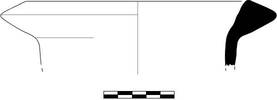
622. Southern Aegean Mushroom Rim Amphora (4th century BC)
P. H. .034. Est. diam. rim 11 (1/2 preserved).
D09.2863:9. Yellowish tan surface over reddish core; sparse scatter yellowish white opaque bits (not lime fill-ins), black bits - both quite visible against the compact orange-red fabric; micaceous. 5YR 5/6.
First published as , no. 82; see page 203 for discussion. Found in deposit 3c.
D09.2863-9.jpg
623. Southern Aegean Mushroom Rim Amphora (4th century BC)
P. H. .079. Est. diam. rim 12 (1/4 preserved).
D09.2862:1. Red brown smooth fabric, moderate scatter - quite even mix - black, grey stony, small white bits, somewhat fewer red brown; micaceous. 5YR 5/6 with slightly greyer brown inner core.
First published as , no. 83; see page 203 for discussion. Found in deposit 3c.
D09.2862-1.jpg
624. Southern Aegean Mushroom Rim Amphora (4th century BC)
P. H. .06113.
D09.2871:28. Brown surface, very smooth, very compact; striated breaks, moderate mixed red-brown and black bits; widely scatted mica. 5YR 6/6 and grey brown core.
First published as , no. 84; see page 203 for discussion. Found in deposit 3c.
D09.2871-28.jpg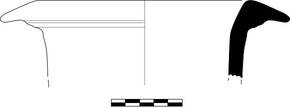
625. Southern Aegean Mushroom Rim Amphora (4th century BC)
P. H. .041. Est. diam. rim 12 (3/8 preserved).
D09.2881:10. Brownish hard smooth compact fabric, quite micaceous; sparse-moderate scatter yellowish lime bits; smudgy dull dark dark grey bits - mostly just mica. Between 2.5YR 5/6 and 5YR 5/6.
First published as , no. 85; see page 203 for discussion. Found in deposit 3c.
D09.2881-10.jpg
626. Southern Aegean Mushroom Rim Amphora (4th century BC)
P. H. .05. Est. diam. rim .10 (1/6 preserved).
D09.2871:44. Smooth red brown surface, fine grained break; sparse scatter small white, large dark grey, rare red brown; micaceous. 5YR 5/6 with slightly yellow brown inner-most core.
First published as , no. 86; see page 203 for discussion. Found in deposit 3c.
D09.2871-44.jpg
627. Short Stem Amphora Toe in Northern Aegean Fabric (4th century BC)
P. H. .076. Est. diam. toe .064.
D09.2876:54. Brownish micaceous fabric; moderate scatter small grey and whitish stony bits, quite micaceous; black bits also common. 7.5YR 5/4.
First published as , no. 26; see pages 200-201 for discussion. Found in deposit 3c.
D09.2876-54.jpg
628. Short Stem Amphora Toe in Northern Aegean Fabric (4th century BC)
P. H. .153. Est. diam. toe .054.
D09.2872:17. Brownish very micaceous fabric with greyish brown firing core; grainy break; moderate scatter dusky black bits; some grey glassy bits also present. Inner core 10YR 5/4; outer core 5YR 5/6.
First published as , no. 29; see pages 200-201 for discussion. Found in deposit 3b.
D09.2872-17.jpg
629. Tall Stem Amphora Toe in Northern Aegean Fabric (4th century BC)
P. H. .153. Est. diam. toe .054.
D09.2872:15. Dark grey smooth hard surface with some mica; fine dark grey-brown, compact core; moderate scatter small smudgy black bits; yellowish lime infills; light red brown bits. 7.5YR 4/3.
First published as , no. 38; see pages 200-201 for discussion. Found in deposit 3b.
D09.2872-15.jpg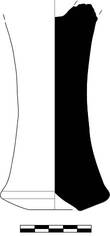
630. Tall Stem Amphora Toe in Northern Aegean Fabric (4th century BC)
P. H. .153. Est. diam. toe .061.
D09.2860:23. Pale reddish tan fabric, coarse grained; moderate-dense grey glassy, fewer whitish-yellow, and very small black bits; micaceous. 7.5YR 7/4.
First published as , no. 41; see pages 200-201 for discussion. Found in deposit 3b.
D09.2860-23.jpg
631. Lawall Type 1 Amphora (late 4th century BC)
P. H. .242. Est. diam. rim .08 (1/4 preserved).
w28.0351:2. Full profile of rim and 3/4 neck with one complete handle preserved. Everted rim has rounded prfile, fascia below rim. Tall, cylindrical neck bulges slightly from join with rim, flares out to the shoulder at the base of the neck. Handles attach just under the rim, arching upward from neck attachment and pulled in slightly at lower attachment. Fabric: sandy fabric with lime. Ext. 2.5Y 7/2 and lighter; core 5YR 7/4 mottled with lime.
First published as , no. 1; with references. Found in late fourth century deposit.
w28.0351-2.jpg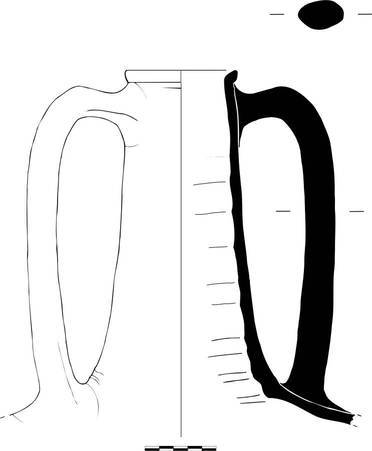
632. Thasian Amphora Rim (late 3rd century)
P. H. .305. Est. diam. rim .11 (1/4 preserved).
w28.0333:17. Complete handle with small portion of rim, neck and shoulder preserved. Handle dimensions: .047x .024. Simple rounded, outward thickened rim with smooth join to neck wall; shallow, indistinct groove around lower part of rim. Long, heavy oval-section handle arcs upward slightly from upper attachment before turning down to steeply sloping shoulder. Fabric: gritty surfae with coarse breaks; very micaceous; 40% inclusions, mostly poorly sorted white translucent bits; many few black bits also present. Exterior 5YR 6/6, core 5YR 5/6.
First published as , no. 16; with references. Found in Hellenistic 2 construction (ca. 225 BC).
w28.0333-17.jpg
633. North Greek Amphora Toe (late 3rd century)
P. H. .076. Est. diam. toe .069.
y29.0120:54. Lower part of stem toe. Flaring stem with fairly sharp outer edge; deep wide conical hollow in base. Fabric: gritty surface, coarse breaks. 10-20% inclusions, mix of gray and pale yellow translucent bits and black bits; mostly 0.2-0.5 mm; micaceous. Exterior 5YR 6/6, core 2.5YR 6/6.
First published as , no. 54; with references. Found in Hellenistic 2a debris (ca. 225 - 175 BC).
y29.0120-54.jpg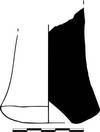
634. Amphora, Button Toe
K/L16/17.0169:14. Single toe sherd, button toe.Brown fabric, light gray core; occasional angular white inclusions, many elgongated tiny light bits.
635. Graeco-Italic Amphora Lyding Will Form D Amphora Neck and Handle (BC 350-150)
D09.2193:1. SC15-01. Joining sherds partially preserving neck and handle
, p. 348.
svg/D09.2193-1.jpg
636. Aegean Amphora
P. H. .068. Est. diam. rim .17 (1/3 preserved). Th. .012.
K/L16/17.0474:14. Somewhat coarse fabric with frequent sand inclusions is pale brown (7.5YR 7/3) at its core becoming pinker (near 2.5YR 7/6) towards surfaces. Salt slipped surface is buff (10YR 8/3).
svg/K-L16-17.0474-14.jpg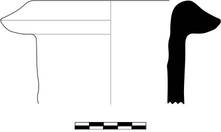
637. Unclassified Dressel 1 Type Amphora (1st Century BC)
P. H. .093. Est. diam. rim .18 (1/10 preserved). Th. .015.
K/L16/17.0427:40. Single sherd with rim, upper neck, and handle attachment. The light red (2.5YR 7/6) fabric is compact with many large rounded bits of previously fired red (2.5YR 5/8) clay as much as .004 in length but mostly much smaller. There are other angular and rounded inclusions that are both light and dark. Just beneath the surface, the fabric is fired light green gray (2.5Y 6/2). The plain surface is buff (2.5Y 8/2).
svg/K-L16-17.0427-40.jpg
638. Dressel 6 Amphora (Augustan)
P. H. .093. Est. diam. rim .166.
D08.0695:5. SC16-06. Single rim sherd. Light buff (10YR 8/2) surface, smooth. Well defined light reddish-brown core (2.5YR 7/4).
First published as no. 53. The form is generally 50 BC to 150 AD; this example comes from an Augustan deposit.
639. Dressel 2-4 Amphora Handle, probably Campanian (1st to 3rd Century AD)
W. .057.
D20.0366:1. SC17-21. Single sherd, handle and neck attachment. Hard, granular fabric is red with many dark and red grits. Surface coated buff.
Class 3. A similar piece is published at no. 109.
640. Dressel 2-4 Amphora Handle, probably Campanian (1st to 3rd Century AD)
P. H. .11. Th. .05.
K/L16/17.0114:56. Single sherd preserving lower part of double handle. Distinctly granular fabric is predominantly brown (between 2.5YR 5/6 and 6/6) with frequent angular black and other yellow inclusions. This is typical of Campanian fabric. The double handle is typical of Dressel 2/4.
Class 3. A similar piece is published at no. 109.
svg/K-L16-17.0114-56.jpg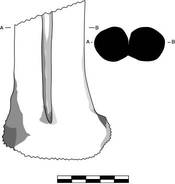
641. Cretan Amphora Neck with Handle Stub, Type AC1b (2nd and 3rd century AD)
P. H. .104. Est. diam. rim .07 (3/4 preserved). Th. .0062.
K17.0749:5. SC17-33. Three sherds with rim and handle stub. Compact, soft pale brown (7.5YR 7/4) fabric with occasional small calcareous inclusions. Surface is coated and paler (7.5YR 8/3). Slightly conical neck and slightly thickened rim.
See AC1b, pp. 70-72; particularly p. 75 for chronology; closest parallels for profile are A37 and A42-44 on fig. 37. See also Middle Roman Amphora 2, pp. 180-183; particularly no. D226; class 41.
svg/K17.0749-4.jpg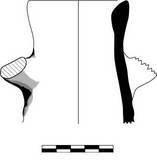
642. Unclassified Amphora
P. H. .09. Est. diam. rim .05 (1/2 preserved). Th. .005.
K17.0759:2. Single sherd with rim and neck, stub of round handle. Slightly granular, light brown (5YR 6/8) fabric with occasional light "quartz" and varied smaller angular inclusions. Coated surface is lighter (5YR 7/4). Thickened, slightly flaring triangular rim.
svg/K17.0759-2.jpg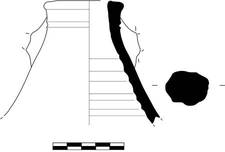
643. Middle Roman Amphora 3 (“Micaceous Water Jar”) Neck with Handle Stub
P. H. .08. Th. .003.
K17.0752:3. SC17-34. Single sherd, incomplete rim and single handle attachment. Fabric and surface brown (2.5 YR 5/4), with frequent mica.
, pp. 183-186; class 45 combines the one and two-handled versions; , plate 41.
svg/K17.0752-3.jpg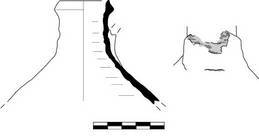
644. MRA/LRA 3 Rim
P. H. .022. Est. diam. rim .038 (1/4 preserved). Th. .004.
D20.0053:14. Micaceous brown fabric.
645. Middle Roman Amphora 3 (“Micaceous Water Jar”) Neck with Handle Stub
w28.0264.102. P0527. Micaceous brown fabric (2.5YR 4/4 to 5YR 4/4). Non-joining neck, rim and single handle are preserved, though not shown in drawing (tk).
, pp. 183-186; class 45 combines the one and two-handled versions; , plate 41.
svg/P0527.jpg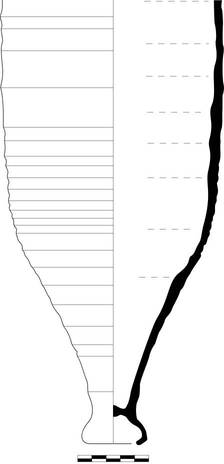
646. Middle Roman Amphora 3 (“Micaceous Water Jar”) Neck and Handle
P. H. .061. Th. .004.
K17.0845:10. Single sherd partially preserves neck and single complete handle. Fine brown (5YR 4/4) fabric with rare tiny white inclusions and frequent mica, typical for form. Interior surface is thinly coated with dark pitch.
svg/K17.0845-10.jpg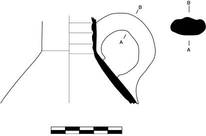
647. Late Roman Amphora 3 ("Micaceous Water Jar") Toe
P. H. .033. Est. diam. base .06 (1/4 preserved). Th. .004.
K17.0389:2. Single toe sherd. Compact brown (7.5YR 4/3) fabric with very frequent small mica flakes. Extant surface is fired to near gray.
K17.0389-2.jpg
648. Water Jar Toe, Regional? (Mid Roman)
P. H. .117. Est. diam. base .067 (completely preserved). Th. .0095.
K17.0881:7. Compact fabric, brown (5YR 6/8). Frequent tiny mica and few tiny dark inclusions. Buff surface with drippping paint visible under accretion.
K17.0881-7.jpg
649. Unclassified Imitative "Water Jar"
K17.0777:40. P.H. .06, D. base .044, th. wall .015. Single toe sherd. Reddish brown (5YR 6/6) fabric is evenly fired and very hard. Frequent tiny mica. Preserved surface has very thin pale coating. Single vertical streak of brown paint coming down from body.
K17.0777-40.jpg
650. Middle Roman Amphora 4 ("Pinched Handle") Rim and Handle
P. H. .073. Est. diam. rim 11 (1/3 preserved). Th. .005.
K17.0759:7. Single sherd. Dark brown (2.5YR 5/8) fabric with infrequent tiny dark and light inclusions. The surfaces are coated and fired to the same color as the fabric. The extant handle is pinched where it turns down towards the body.
For an overview of the form see , pp. 186-187. The fabric of this piece is perhaps identical to that of Cilician “pinched handle” amphoras as described and illustrated in color at , pp. 329-332. Similar fabric and profile at Knossos ().
svg/K17.0759-7.jpg
651. Middle Roman Amphora 4 ("Pinched Handle") Rim and Handle
P. H. .087. Est. diam. rim 11 (1/3 preserved). Th. .005.
K17.0780:1. Four joining sherds with rim and one handle. Soft, compact, pale green (2.5Y 8/2) fabric. The frequent inclusions include occasional large angular quartz (.005 in length), rounded lime, chunks of previously fired clay that are more red than the main matrix, and a variety of smaller inclusions. Elongated voids in wall, irregular voids in handle. The surface is plain. Handle is “pinched” at upper angle. The sherds have been conserved.
For an overview of the form see , pp. 186-187. Cf. , no. G199 and , no. 41.
K17.0780-1.jpg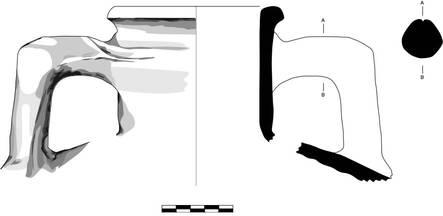
652. Middle Roman Amphora 5 Neck, Rim and Handle
P. H. .115. Est. diam. rim .15 (1/5 preserved). Th. .01.
K17.0759:8. Single sherd with rim and handle, single groove under rim. Coarse fabric. Gray core where wall is thickest but cleanly fired to red (from 2.5YR 5/8 to 2.5YR 6/6) at lower extant neck. Coated exterior surface is brown (2.5YR 5/6) after conservation. Small lime/white bits and angular sand are the most frequent inclusions.
, pp. 188-189.
svg/K17.0759-8.jpg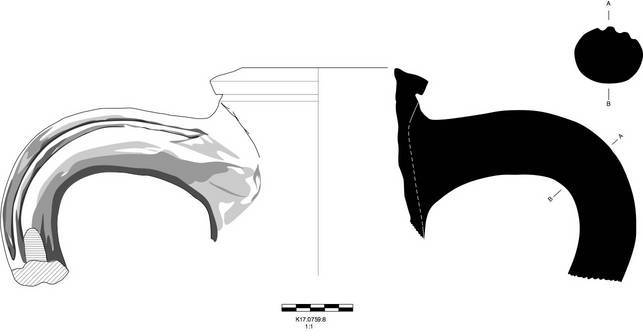
653. Middle Roman Amphora 5 Neck and Rim
D20.0220:1. SC17-13. Single large piece preserving neck and rim. High neck. Flattened rim. Two deep incisions below rim. Core- pink/gray (5YR 6/2) fired to red (2.5YR 5/6). Quartz and other angular inclusions.
, pp. 188-189.
654. Middle Roman Amphora 5 Rim
D20.0017:34. SC17-14. Single rim sherd. Two deep exterior incisions. Light brown/gray (10YR 6/2) core fired to light red (2.5 YR 6/8) at surface. Large light inclusions.
, pp. 188-189.
655. Middle Roman Amphora 5 Rim
P. H. .097. Est. diam. rim .15 (1/3 preserved). Th. .008.
K17.0777:28. Single rim sherd with upper neck. Slightly granular brown (2.5YR 5/8) fabric with small white inclusions and occasional mica. Coated surface is slightly paler than fabric. Two slits cut below rim.
K17.0777-28.jpg
656. Middle Roman Amphora 5 Rim
P. H. .038. Est. diam. rim .19 (1/6 preserved). Th. .012.
K17.0845:13. Single sherd, deep grooves under rim. Coarse, dark brown (7.5YR 4/3) at core of rim with frequent varied angular inclusions and gold mica. Exterior surface is predominantly orange (near 2.5YR 6/6), the upper face of the rim and extant inner part of the neck is gray except where worn.
K17.0845-13.jpg
657. Middle Roman Amphora 5 Handle
P. H. .11.
K17.0845:11. Single sherd preserves part of handle. Hard granular, brown (5YR 6/8 and browner) fabric with frequent white angular inclusions. Thin dull red (near 10R 5/6) coat on surface.
svg/K17.0845-11.jpg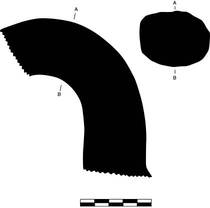
658. Middle Roman Amphora 7 Rim and Handle
P. H. .11. Est. diam. rim .06 (completely preserved preserved). Th. .0065.
K17.0759:9. Single sherd, rim and handle. Well-formed collar below rim. Coarse fabric. Reddish-brown (2.5YR 6/8) fabric with frequent rounded and sub-angular black stones up to .002 in length, as well as frequent small white and varied bits; elongated voids. Surface is coated and ranges from 2.5YR 6/6 to a smokey dull red (2.5YR 5/3 and darker). Sherd has been conserved.
, pp. 189-193; 77; class 47.
svg/K17.0759-9.jpg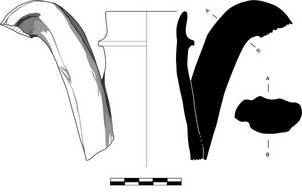
659. Middle Roman Amphora 7 Neck and Rim
P. H. .24. Est. diam. rim .061.
D20.0017:35. SC17-16. Single large piece preserving neck an rim. Brick red fabric.
, pp. 189-193; 77; class 47.
660. Middle Roman Amphora 7 Rim
K17.0777:29. P.H. .061, est. D. rim .072 (1/2 preserved), Th. .013. Single rim sherd. Reddish-brown (5YR 5/4) fabric with frequent small angular inclusions varied from light to dark. Coated surface is also brown (5YR 5/6). Groove with ridge below under rim.
, pp. 189-193; 77; class 47.
K17.0777-29.jpg
661. Middle Roman Amphora 7 Handle
K/L16/17.0419:3. Single sherd with handle and adjacent neck. P.H. .17, Th. across handle .05. Somewhat granular, hard, cleanly-fired brown (5YR 5/6) fabric with varied inclusions: most frequently black rounded bits - some up to .008 in diameter but usually .004, also elongated white/lime, brick red chunks up to .002 in length - perhaps re-fired clay -, and frequent other varied tiny bits; frequent elongated voids. The surface is coated and fired same color as fabric.
, pp. 189-193; 77; class 47.
svg/K-L16-17.0419-3.jpg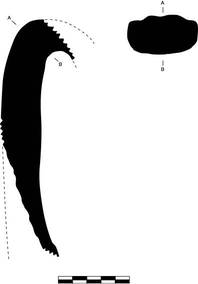
662. Middle Roman Amphora 7 Type Handle
K/L16/17.0417:3. Handle with adjacent neck. P.H. .095, Th. across handle .046. Somewhat coarse brown (5YR 6/6) fabric with frequent angular white inclusions and much silver mica. Surface thinly coated but near color of fabric. The mica suggests an southwest Anatolian origin.
, pp. 189-193; 77; class 47.
svg/K-L16-17.0417-3.jpg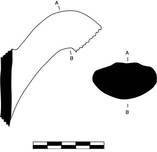
663. Middle Roman Amphora 7 Handle
P. H. .062.
K17.0845:14. Single sherd partially preserves handle. Hard, compact reddish-brown (2.5YR 5/8) fabric with frequent small reddish and light inclusions. Coated surface is slightly darker and browner than fabric.
svg/K17.0845-14.jpg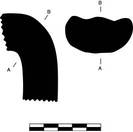
664. Middle Roman Amphora 7 Type Handle
K/L16/17.0104:2. P.H. .11, max. th. across .06. Single handle. Brownish-red (2.5YR 5/6) fabric with frequent small inclusions, and occasional small angular black stones. Darker (2.5YR 5/4) surface.
svg/K-L16-17.0104-2.jpg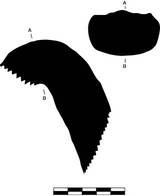
665. Middle Roman Amphora 7 Base
K/L16/17.0419:4. Single sherd preserves 1/5 circumference of hollow foot. P.H. .038, est. D. toe .08, Th. .011. Somewhat coarse brown (5YR 5/8) fabric with oversize (up to .004) black chunks and frequent angular light and dark smaller inclusions. Surface is coated but same color as fabric.
, pp. 189-193; 77; class 47.
svg/K-L16-17.0419-4.jpg
666. Middle Roman Amphora 7 Base
P. H. .165. Th. .008.
K/L16/17.0072:2. Single sherd preserves complete hollow base with lower wall. Slightly granular, brown (7.5YR 6/6) fabric with frequent angular light inclusions, fewer dark, and other mostly light bits. There is some uneven firing, lower wall gray towards interior. Surface coated and redder (5YR 6/4).
, pp. 189-193; 77; class 47.
svg/K-L16-17.0072-2.jpg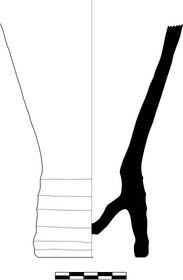
667. Middle Roman Amphora 7 Handle
K/L16/17.0072:4. Single sherd, arched handle to turn.
, pp. 189-193; 77; class 47.
svg/K-L16-17.0072-4.jpg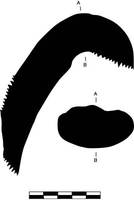
668. Middle Roman Amphora 7 Base
D20.0017:36. SC17-17. Two joining sherds, preserving base. Brick red fabric.
, pp. 189-193; 77; class 47.
669. Middle Roman Amphora 7 Base
P. H. .064. Th. .011.
E/F10.0233:13. Single sherd preserves portion of hollow toe. Granular fabric is unevenly fired in extant portion: comparatively pink (2.5YR 7/6) towards the interior, pale green (7.5YR 8/6) towards the exterior. The most visible inclusions are large (.0054) chunks of possibly re-fired clay. The largest of these are pale in comparison to their matrix, there are also smaller comparatively brick red chunks, which tend to be smaller. Taken together these inclusions are frequent. There are also tiny darker and light bits. The interior surface is coated and also pink (2.5YR 7/6). The coated outer surface is a distinctly darker reddish-brown (2.5YR 5/3).
, pp. 189-193; 77; class 47.
670. Pontic Amphora S IVb/c Rim and Handle (2nd to 4th century AD)
P. H. .125. Est. diam. rim .08. Th. .0094.
K17.0881:8. Neck with beginning of one handle. Pale (2.5Y 8/3) fabric with very frequent small black inclusions, interspersed with far fewer red chunks. Surface thinly coated to very similar color.
See , pp. 413-415 and fig 7 for discussion of form. Also, , p. 255, type C.
svg/K17.0881-8.jpg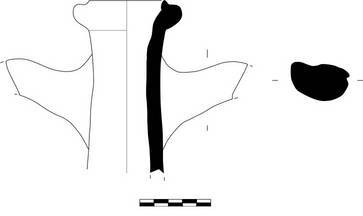
671. Pontic Amphora S IVb/c Rim (2nd to 4th century AD)
D20.0017:26. SC17-11. Single rim sherd. Pale yellow fabric with frequent dark inclusions.
See , pp. 413-415 and fig 7 for discussion of form. Also, , p. 255, type C. A complete example is illustrated from Knossos ().
672. Pontic Amphora S IVb/c Rim (2nd to 4th century AD)
H10.0015:1. SC17-12. Single rim sherd. Pale yellow fabric with frequent dark inclusions.
See , pp. 413-415 and fig 7 for discussion of form. Also, , p. 255, type C.
673. Pontic Amphora S IVb/c Toe (2nd to 4th century AD)
P. H. .04. Est. diam. toe .08. Th. .005.
K17.0777:30. Toe with beginning of body. Pale fabric (7.5YR 7/4) with frequent subangular dark bits.
See , pp. 413-415 and fig 7 for discussion of form. Also, , p. 255, type C.
svg/K17.0777-30.jpg
674. Unclassified Transport Amphora (Early Roman?)
P. H. .049. Est. diam. rim .15 (1/8 preserved). Th. .015.
K/L16/17.0427:34. Single rim sherd. Slightly granular fabric fired to uneven light reddish-brown (10R 6/8), thin core is lighter towards green; some small angular and rounded light, sandy inclusions, as well varied smaller bits. Surface plain. Bulbous neck with thickened rim, groove just below tip.
Dated by 2nd century closing date of context.
svg/K-L16-17.0427-34.jpg
675. Unclassified/Regional Amphora Rim and Handle (3rd Century AD)
P. H. .35. Est. diam. rim .158. Est. diam. toe .09.
. P0426. Tapering rim. Handles round in section, attached to body just below rim. Brick-red fabric (2.5YR 5/8-6/8), gritty surface. Inclusions consist of opaque white stones, black particles (volcanic), and red stone; sand tempered. A coin of Gallienus was attached to this amphora.
First published as no. 167.
svg/P0426.jpg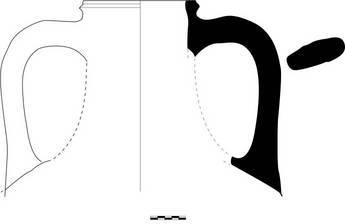
676. Pontic Late Roman Amphora 2 Precursor?
M18.0099:5. Two joining rim sherds. Relatively compact, light red (2.5YR 6/8) fabric with occasional dark grits in addition to tiny white/lime bits. The coated surface is pale.
Similar form at no. 168. That piece is from third century layer of the w28 well.
M18.0099-5.jpg
677. Unclassified Amphora
P. H. .126. Est. diam. rim .14.
K17.0741:13. Single sherd, rim, nack and handle. Squared rim on short vertical neck, thick oval handle. Compact fabric is red (2.5YR 6/8) with small, light angular inclusions. Exterior surface coated beige (7.5YR 8/4). Light groove on neck.
678. Unclassified Transport Amphora
K17.0777:19. P.H. .12, est. D. rim .17 (1/12 preserved), min. th. wall .018. Single sherd. The fabric is fine and compact. In color it is turning pink (5YR 8/3) as we go down the extant neck. Otherwise it is pale green (2.5YR 8/2). There are dark bits and small voids but otherwise the fabric is relatively fine. Thickened rim is rounded on top and undercut at exterior.
K17.0777-19.jpg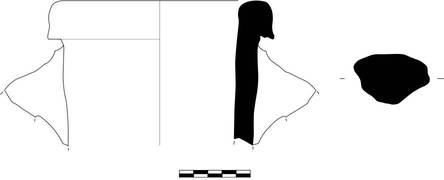
679. Unclassified Transport Amphora
K17.0777:3. P.H. .05, est D. rim .16 (1/3 preserved), Th. .095. Two joining rim sherds. Hard, coarse orange (2.5YR 6/8) fabric with frequent varied large chunks of lime and other stone and abundant smaller, mostly dark, bits.
K17.0777-3.jpg
680. Late Roman Amphora 1 Neck and Handles (Late Fifth to Early Sixth Century AD)
P. H. .19. Est. diam. rim .095.
I17.0181:1. Six joining sherds preserve neck, handles and upper body. Reddish fabric (5YR 7/6) fabric becoming buff () towards surface. Frequent varied inclusions, with some occasional lime chunks. Surface smoothed and coated in places. Convex band below rim, two light channels on handles. Upper body preserves ridges as opposed to the wide bands that appear on later versions. Deposition may be associated with the early sixth century earthquake. Dipinti on both sides and under one handle.
681. Late Roman Amphora 1 Handle (Fifth Century AD)
P. H. .068. Est. diam. .31.Th. .08.
D20.0053:9. Single sherd, with handle stub. Trace of dipinto on shoulder, not readable. Regular fabric: sandy, gritty in orangish buff (5YR 7/6) with black bits, creamy surface. Ridges on extant surface.
682. Late Roman Amphora 1 Base
P. H. .095.
K17.0736:10. Single base sherd, ribbing on interior and exterior. Diameter is estimated maximum preserved diameter of body. Fabric light red (2.5YR 6/8) with very frequent light and dark bits; exterior is encrusted, interior fired pink (2.5YR 8/4). Found in post-earthquake deposit of the early sixth century AD.
K17.0736-10.jpg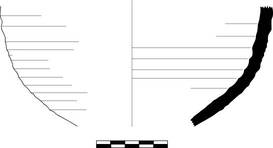
683. Late Roman Amphora 2 Neck and Handle
D20.0035:2. SC17-18. Neck and one handle preserved.
, pp. 217-219, the form is "Late Roman Amphora 2" at both Benghazi and Carthage; class 43.
684. Late Roman Amphora 2 Rim
P. H. .08. Est. diam. rim .125 (1/5 preserved). Th. .009.
K17.0696:18. Single rim sherd. Red core in thickest part of rim (2.5YR 5/6), fired brown under surface (7.5YR 6/6). Inclusions consist of occasional sub-angular dark bits, occasional lime and frequent other small varied bits. Surface is coated pale brown, near fabric.
, pp. 217-219, the form is "Late Roman Amphora 2" at both Benghazi and Carthage; class 43.
svg/K17.0696-18.jpg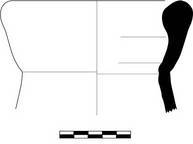
685. Late Roman Amphora 2 Rim (Fifth Centuery AD)
P. H. .036. Est. diam. rim .16 (1/8 preserved). Th. .006.
D20.0065:11. Single rim sherd. Orangish buff fabric (5YR 6/6 and 7/6) highly micaceous and limey with fine silver mica, bits of black inclusions.
, pp. 217-219, the form is "Late Roman Amphora 2" at both Benghazi and Carthage; class 43.
686. Uncataloged Late Roman Amphora 2 Fragment
M18.0099:7.
687. Late Roman Amphora 2 Fragment
K17.0777:37. Th. .01. Single body fragment. Gray towards interior surface, more red towards exterior (2.5 YR 6/4), buff exterior surface (near 7.5YR 7/6). Frequent varied small inclusions and occasional large, up to .0015 in length, lime chunks in relatively soft, fine fabric.
688. Late Roman Amphora 3 ("Micaceous Water Jar") Neck and Handles (Late 4th to 5th Century AD)
P. H. .091. Th. .004.
D20.0053:2. SC17-07. Neck and handles preserved, rim chipped. Micaceous brick red fabric (2.5YR 4/4) with lime inclusions.
, pp. 229-230, where the form is "Late Roman Amphora 10"; class 45 combines the one and two-handled versions; , plate 41.
689. Late Roman Amphora 3 ("Micaceous Water Jar") Toe
P. H. .048. Est. diam. base .042 (1/1 preserved). Th. .0032.
D20.0017:41. SC17-23. Single sherd. Brown, micaceous fabric.
, pp. 229-230, where the form is "Late Roman Amphora 10"; class 45 combines the one and two-handled versions; , plate 41.
690. Late Roman Amphora 3 ("Micaceous Water Jar") Toe
K17.0777:33. P.H. .02. Single fragmentary toe sherd. Micaceous brown (7.5YR 5/6) fabric. Not illustrated.
691. Late Roman Amphora 3 ("Micaceous Water Jar") Fragment
Th. .005. L. .078. W. .057.
D20.0017:41. SC17-23. Body sherd. Brown, micaceous fabric.
, pp. 229-230, where the form is "Late Roman Amphora 10"; class 45 combines the one and two-handled versions.
692. Late Roman Amphora 4 (“Gaza Amphora”) Rim and Handle (fifth century AD)
P. H. .11. Est. diam. rim .135 (1/8 preserved). Th. .008.
K17.0736:4. SC17-35. Two joining sherds preserving rim and handle. Brown (5YR 5/6) fabric with large calcareous inclusions as well as frequent darker bits and small voids. The coated surfaces are slightly darker brown than the fabric. (Note: image does not show join with handle.)
The rim form matches type LRA 4A2, p. 104 and fig. 66. Cf. , pp. 219-223, where the form is "Late Roman Amphoras 3"; class 49.
svg/K17.0736-4.jpg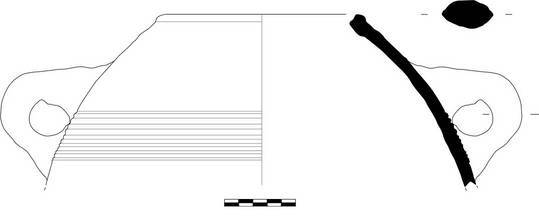
693. Late Roman Amphora 4 (“Gaza Amphora”) Rim
P. H. 025. Est. diam. rim .09 (1/5 preserved). Th. .0085.
K17.0777:34. Slightly granular, brown (7.5YR 5/4) fabric; some quartz and other darker bits. Coated brown surface. Excess clay is adhered on rim.
Cf. , pp. 219-223, where the form is "Late Roman Amphoras 3"; class 49.
K17.0777-34.jpg
694. Late Roman Amphora 4 (“Gaza Amphora”) Handle and Upper Body
P. H. .21. Th. .009.
K17.0759:10. Single body sherd with handle attached. Compact, brown (5YR 5/6) fabric. Compact but with occasional lime chunks and other tiny black and light bits. Ridges on shoulder under handle, which suggests a fifth century date . The stance and diameter shown in the illustration are approximate.
Cf. , pp. 219-223, where the form is "Late Roman Amphoras 3"; class 49.
svg/K17.0759-10.jpg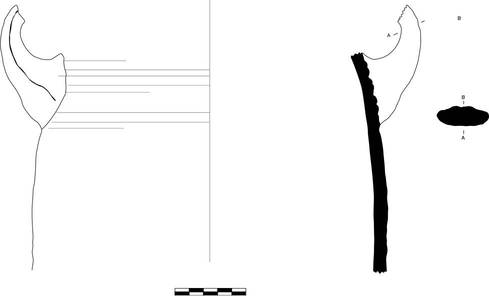
695. Late Roman Amphora 4 (“Gaza Amphora”) Handle
P. H. .095. Th. .004.
D20.0053:10. Single sherd, strap handle, slightly irregular wall. Brown rough fabric, chunks of lime on the surface.
Cf. , pp. 219-223, where the form is "Late Roman Amphoras 3"; class 49.
696. Late Roman Amphora 8 Rim
P. H. .048. Th. .005.
D20.0053:11. Two joining sherds. Thickened rim with triangular profile. Fabric is reddish brown (5YR 5/4) with frequent light and inclusions and frequent mica.
Cf. , p. 132-137.
697. North African Amphora Toe, Spatheion (350 to 600 AD)
P. H. .14. Est. diam. toe .032.
M18.0657:1. Single sherd preserving part of tapering toe to just above beginning of wall. Hard, slightly granular fabric is fired red (10R 5/8) with angular light inclusions. Surface of toe has streaky "salt slip". At the level of the wall, the start of vertical smoothing marks is visible. Extant interior is plain.
, p. 143.
M18.0657-1.jpg
698. Zeuxippus Ware Bowl Rim (13th Century)
p28.0008:1. SC14-3j. Hard clean ware, gray with brown core. The interior of the bowl has a white slip under a pale yellowish-green glaze. Gouged band defines zone of sgraffito decoration; gouges appear dark olive green where slip is removed. Abstract sgraffito motif of a stylized palmette inside two concentric circles. Motif shows amber staining, particularly where color added along rim. Exterior shows traces of white slip; glaze extends to a point just over the rim.
First published as , no. 1.
699. Regional Zeuxippus Ware Derivative (RZD) Bowl Rim (AD 1250-1350)
Est. diam. rim .24 (1/20 preserved). Th. .0054.
p28.0008:2. SC14-3e. text
First published as , no. 24.
700. Regional Zeuxippus Ware Derivative (RZD) Bowl Rim (AD 1250-1350)
Est. diam. rim .22 (1/20 preserved). Th. .0067.
p28.0003:4. SC14-3a. Single rim sherd. Interior and exterior decorated with a white slip under a yellowish-brown glaze. The interior has a band of added color (sepia) on rim. Rim is slightly flaring. Exterior is decorated with horizontal ladder motif between two gouged bands; a third band is below the motif. Below the third band is an extra bit of clay impressed with small "circles." Below the impressed decoration are two gouged vertical lines with no added color. The glaze on the top of the rim has worn away. Core is greyish (possibly underfired?).
First published as , no. 25.
701. Regional Zeuxippus Ware Derivative (RZD) Plate Rim (AD 1250-1350)
Est. diam. rim .24 (1/20 preserved). Th. .006.
p28.0174:13. SC14-3d. Single sherd. Red fabric with frequent mica. The interior of the bowl has a white slip under a pale yellow glaze. There are two gouged bands running around rim of plate on interior. Trace of another gouged decoration closer to floor also appears. Amber staining and slight vitrification. Exterior has a white slip over most of sherd; appears to taper off closer to floor. The glaze extends over rim about 1 cm. Rim is upturned.
702. Hellenistic Fusiform Unguentarium
. P0577. Complete vessel except missing rim. Fired gray (surface = 10yr 4/1, section = 10 yr 4/1-4/2). Traces of white bands, 1 on shoulder and 1 on body.
Most similar to group B.32, which overlaps with S. Rotroff's "Atheanian Gray Unguentaria".
703. Hellenistic Fusiform Unguentarium
. P0579. Complete vessel except missing rim; joined from 9 frags. Fired gray (10yr 4/1-5/1) with self-slip hues of gray on the surface.
Most similar to group B.32, which overlaps with S. Rotroff's "Atheanian Gray Unguentaria".
704. Roman Period Piriform Unguentarium
l/m14/15.0001. P0759. Unguentarium, chipped at rim, otherwise complete.
Parallels are found in groups C.11.1 and 2.
705. Early Roman Piriform Unguentarium
t/u14.0130. P0717. Complete vessel. Orange buff (2.5YRR 6/6-7/6), micaceous fabric. Red slip around rim and neck.
Nearest to group C.33.6, for which only western Mediterranean findspots are listed.
706. Unguentarium (Late Roman)
P. H. .061. Est. diam. base .028. Th. .01.
D20.0183:6. Single sherd preserving complete base. String cut base, slightly irregular. Pinkish buff fabric (2.5YR 6/6) surface one tone darker.
707. Ampulla in Plain Fabric (Late Roman)
P. H. .058. Est. diam. .02.Th. .002.
I17.0647:10. Single sherd preserving lower half of vessel. Compact, soft light red (10R 6/8) fabric with frequent small lime inclusions and infrequent dark bits. Surface is plain.
The category of small late Roman unguentaria, also known as ampullae, was defined by Hayes (, ). More recently, examples from Ephesos have been extensively discussed (, ).
I17.0647-10.jpg
708. Hellenistic Meander Geison Tile
y29.0120. AT0169. SC14-3d. Single fragment, edge paritally preserved. Meander on outer face, 5.5 cm.
First published as p. 228 and cat. no. 16 with full discussion.
709. Hellenistic or Early Roman Imbrex Rooftile
K/L16/17.0461:13. SC14-3d. Essentially complete. Coarse orange fabric, micaceous with many other varied, small inclusions. A component of a so-called Corinthian style roof.
710. Marble Plate
H. .037. Est. diam. rim .60 (1/20 preserved). Th. .002.
K17.0681. S0019. Large-grain white marble.Single fragment preserving rim profile and floor. Original surfaces well preserved.Large plate; short flaring wall, concave inner wall offset from floor, concave outer wall offset from rounded outer edge of rim; two grooves on broad upper face of rim; flat floor. Inner surfaces highly polished; outer wall and floor less so. There is a very shallow guideline set .012 in from the outer edge of the floor. This width nearly matches the finished band on S0022.
711. Marble Plate
H. .037. Est. diam. rim .60 (1/20 preserved). Th. .002.
K17.0681. S0022.
Large-grain white marble.
Single fragment preserving rim profile and floor. Original surfaces well preserved.
Plate with short flaring wall, concave inner wall offset from floor, concave outer wall extends to squared outer edge of rim; single groove towards inner edge of broad upper face of rim. Inner surfaces and outer wall highly polished. The floor has a .011 highly polished outer band. The surface is rough inside of the polished band, with short point-chisel marks still extant (see photo and drawing). This roughness may indicate that the plate is unfinished.
712. Marble Bowl with rectangular lug
H. .044. Est. diam. rim .19 (1/4 preserved). Th. .011.
K17.0714. S0019.
Large grain white marble with some gray veining.
Two joining fragments (body and partial handle)
Bowl with single extant rectangular handle. The rounded walls rise smoothly to rounded vertical rim. Vessel is thickest (.019) at lower part of wall with upper walls and floor distinctly thinner. Neither interior nor exterior wall is marked off from floor or base. The small handle is rectangular in profile; although chipped, its edges were quite well-defined, intersections with wall of bowl are also well defined. Condition of extant surfaces may indicate that interior was more finished than exterior. There is a relatively unpolished band on the exterior that still carries light chisel marks.
713. Marble Bowl with palmette lug handles
H. .049. Est. diam. rim .23 (1/2 preserved). Th. .0152.
K17.0845. S0016.
Large grain white marble with some gray veining.
Two large joining fragments.
Bowl with rounded wall, no part of floor extant; two palmette handles preserved. The rounded wall rises directly to flat rim. The handles are similar in conception, though not identical in result. They are both elongated semi-circles. In section they are gently rounded on top, with a continuous vertical side and more rounded lower face. Each is divided into four parts by three v-shaped grooves that are deeper towards the outer edge. In one handle these grooves meet at a straight line dividing the handle from the rim. The center groove extents to the inner edge of the rim, where it is faint. On this handle the flanking grooves have a slight flare. The other handle has one groove that crosses onto the rim and misses the intersection of the central groove and rim; the other flanking groove is more carefully placed. The central groove of this handle does not seem to cross onto the rim. This second handle is larger than the better executed one. [[handles will be labeled a and b when illustrated]]
svg/S0016.jpg

